In the fast-moving world of ecommerce, every click, scroll, and second of attention matters. A/B testing has become the backbone of data-driven growth, helping brands uncover what truly resonates with their audience. From simple design tweaks to full-scale personalization, the right experimentation platform can turn guesswork into measurable results. Whether you’re a D2C startup running on Shopify or an enterprise brand handling millions of visitors, choosing the right tool determines how quickly you learn and how effectively you grow. This guide explores some of the most powerful A/B testing platforms available today, each bringing a unique approach to optimization, personalization, and customer experience.
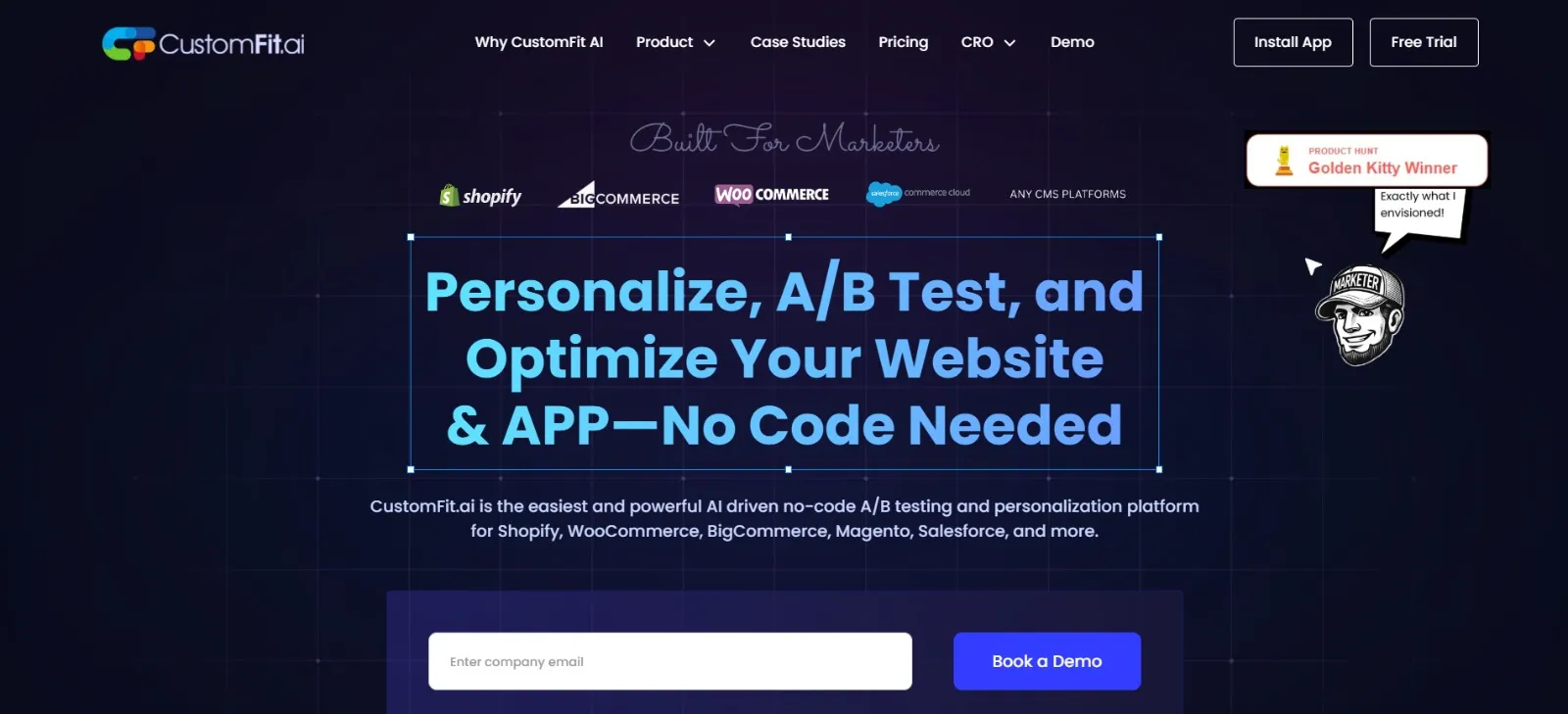
If most A/B Testing tools are designed for developers, CustomFit.ai flips that approach entirely. It’s a no-code A/B Testing Platform built specifically for marketers and growth teams running ecommerce stores on platforms like Shopify, WooCommerce, and Shoplazza.
With CustomFit.ai, teams can modify website content, test variations, and personalize the user experience in real time, without ever touching the code. What makes it stand out is its focus on helping brands increase conversion rates through behavior-based personalization and instant content changes.
For example, a brand can run an A/B test where one group sees a “Free Shipping Today” banner, and another group sees “Buy 2 Get 10% Off.” The system tracks real conversions, showing which version drives more engagement and revenue.
Beyond testing, CustomFit.ai enables deep segmentation: by traffic source, device type, campaign, region, or returning visitors. For fast-moving D2C brands where decisions can’t wait for engineering cycles, this kind of flexibility is game-changing.
Best for: D2C brands and ecommerce stores that want fast, no-code A/B testing and personalization at scale.

Optimizely is one of the earliest and most widely recognized A/B Testing Platforms in the world. Known for its enterprise-level flexibility, it allows teams to experiment across web, mobile, and server-side environments.
What makes Optimizely exceptional is its depth; it’s not just a tool for website experiments but a full-scale digital experimentation platform that connects A/B tests to broader business goals. Ecommerce teams can test everything from checkout flows and search algorithms to pricing strategies or feature rollouts.
The platform’s advanced targeting and statistical modeling ensure accurate, reliable results, even when running complex experiments with multiple variants. For large-scale ecommerce players handling millions of monthly visitors, Optimizely provides the infrastructure and data precision to test without compromise.
Best for: Large ecommerce and enterprise companies with dedicated experimentation teams looking for deep analytics and control.
Optimizely is built for large enterprises and often requires developer support, longer setup times, and higher costs. CustomFit.ai takes a simpler, more hands-on approach, it’s designed for marketers and growth teams who want to run A/B tests and personalize their websites without coding. The platform offers visual editing, instant experiment launches, and deep Shopify integrations, all while removing flicker issues that disrupt user experience. Most importantly, CustomFit.ai provides direct human support via Slack, WhatsApp, and calls, making it more of a partner than a tool. It’s faster, easier, and built for real-world growth needs , not just enterprise-scale setups.

VWO makes A/B Testing accessible without oversimplifying it. It’s a versatile A/B Testing Platform that combines testing, behavioral analytics, and conversion tracking in one unified dashboard.
Unlike developer-heavy tools, VWO caters to marketing and product teams who want to design experiments visually, from changing CTAs and product images to testing new homepage layouts. Beyond standard A/B tests, it supports multivariate and split URL testing, allowing ecommerce stores to explore multiple design and messaging possibilities at once.
One of its biggest strengths is its built-in user insights module: heatmaps, session recordings, and form analytics help teams understand not just what users do, but why they do it. For D2C marketers focused on conversion optimization, this combination of testing + behavioral data is extremely powerful.
Best for: Ecommerce and SaaS teams who want an easy-to-use A/B testing solution backed by strong behavioral analytics.
While VWO is a popular A/B testing platform, it often caters more to technically driven teams and can feel complex for marketers who want quick, hands-on control. CustomFit.ai, on the other hand, is built from the ground up for marketers, growth teams, and founders who want to create and run experiments or personalize websites without writing a single line of code. It offers a clean visual editor that lets you modify pages, test new layouts, and personalize content instantly, all without developer dependency. Unlike VWO, which can experience flicker and load delays, CustomFit.ai ensures seamless, flicker-free experiences and faster rendering for every visitor. It also integrates deeply with Shopify and other eCommerce platforms, enabling brands to create personalized offers, messages, and widgets that directly improve conversions. Beyond its product capabilities, CustomFit.ai stands out for its exceptional, always-accessible support — teams can connect with the CustomFit.ai crew via WhatsApp, Slack, or calls for instant help. In short, CustomFit.ai combines simplicity, speed, and human support, making it a smarter, more practical choice for today’s fast-moving eCommerce and marketing teams.

AB Tasty blends classic A/B Testing with AI-driven personalization to deliver optimized customer journeys. Designed for ecommerce and enterprise businesses, it helps teams test ideas quickly, deploy new content variations, and target high-value audience segments automatically.
Its AI algorithms predict which variant will perform best based on live user behavior, making it more than just a test-and-wait tool. The platform’s visual editor makes it easy to launch tests without technical support, while its robust API layer supports complex, full-stack experimentation for advanced users.
Ecommerce brands use AB Tasty to test things like product detail pages, cart flows, and loyalty banners, all with one goal: to increase conversion rates and improve the on-site experience.
Best for: Mid-to-large ecommerce stores that want intelligent, AI-backed testing and personalization combined.
When you’re evaluating optimisation platforms and wondering whether to choose CustomFit.ai rather than AB Tasty the right answer often comes down to clarity, speed and support. AB Tasty is a powerful, enterprise-grade suite that offers extensive capabilities like web experimentation, feature flags, AI-driven personalization and recommendations. However it also carries with it the complexity of a broad platform: its pricing is custom and opaque, which can make budgeting challenging.
CustomFit.ai, by contrast, aims to simplify the process of testing and personalising a website, especially for mid-sized teams, e-commerce brands or marketing-led organisations. You spend less time figuring out integrations or heavy configuration and more time running meaningful experiments. The focus shifts from managing the tool to improving outcomes. With fewer layers of technical dependency you move faster. CustomFit.ai also emphasises direct human support and a hands-on partnership model, which for many teams means fewer delays and fewer hidden hurdles. In practice this means if you’re looking for a solution that avoids the overhead of a full-scale enterprise stack, gives you visual editing, fast launch of campaigns and a simpler decision-making process, then CustomFit.ai can be a more practical choice than AB Tasty.
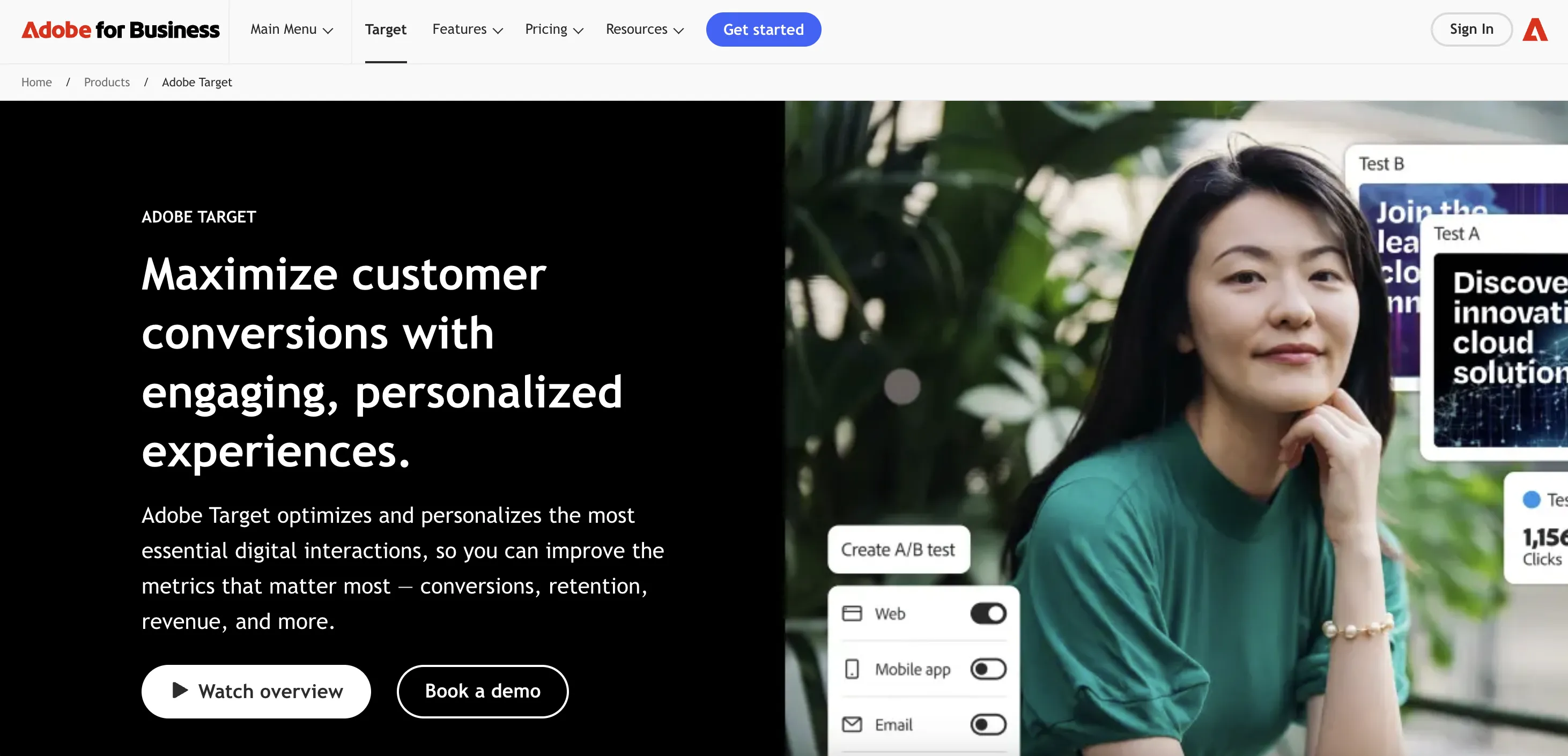
When it comes to enterprise-level experimentation, Adobe Target is often the gold standard. It’s part of the Adobe Experience Cloud, designed to deliver cross-channel A/B testing and personalization across web, mobile apps, email, and even in-store digital displays.
Adobe Target empowers large ecommerce companies to serve personalized experiences to millions of customers simultaneously. Its automated decisioning engine uses AI (through Adobe Sensei) to determine which variant to show to each visitor, optimizing conversions in real time.
It integrates seamlessly with Adobe Analytics, which makes it particularly powerful for data-driven marketing teams. If your ecommerce brand runs across multiple channels, web, mobile, and email Adobe Target is one of the few platforms capable of managing that entire ecosystem under one roof.
Best for: Enterprise ecommerce stores operating across multiple customer touchpoints who need advanced personalization and analytics.
Adobe Target is a powerful enterprise platform, but it often requires large teams, deep technical resources, and complex setup to unlock its full potential. For many marketing and eCommerce teams, this makes experimentation slow, expensive, and dependent on developers. CustomFit.ai takes a simpler and more practical approach. It lets marketers run A/B tests, personalise website experiences, and make visual changes without writing code or relying on engineering support. It is faster to implement, easier to use, and better suited for teams that want quick, meaningful impact rather than managing a heavy enterprise stack. With smoother integrations, a clean visual editor, and direct human support, CustomFit.ai becomes a more agile and accessible choice for brands that value speed, simplicity, and hands-on guidance over complex enterprise tooling.

Unlike most client-side A/B Testing Platforms, SiteSpect is designed for precision and speed. It operates at the server level, eliminating page flicker and ensuring seamless user experiences during tests an often overlooked but critical factor in ecommerce where milliseconds can affect conversions.
SiteSpect’s architecture allows you to test everything from content and UX elements to back-end logic like pricing, recommendations, and API responses. Its robust targeting and traffic allocation make it a favorite among technically advanced ecommerce teams.
For brands concerned about data security and page performance, SiteSpect provides enterprise-grade control with zero external scripts, making it ideal for industries like finance, telecom, and large-scale ecommerce.
Best for: Technical ecommerce teams prioritizing performance, control, and privacy in their experimentation setup.
SiteSpect is built for complex, enterprise environments where teams have strong technical resources and the capacity to manage proxy-based setups and advanced server-side testing. This power also brings heavier implementation effort, longer onboarding, and reliance on engineering teams. CustomFit.ai takes a simpler, more practical path. It is built for marketers and growth teams who want to launch A/B tests and personalise websites quickly without dealing with infrastructure or code. With a clean visual editor, fast setup, and smooth integrations for eCommerce brands, CustomFit.ai helps teams move from ideas to live experiments much faster. It focuses on real conversion improvements rather than technical complexity and offers hands-on, accessible support that makes experimentation easier and more human.
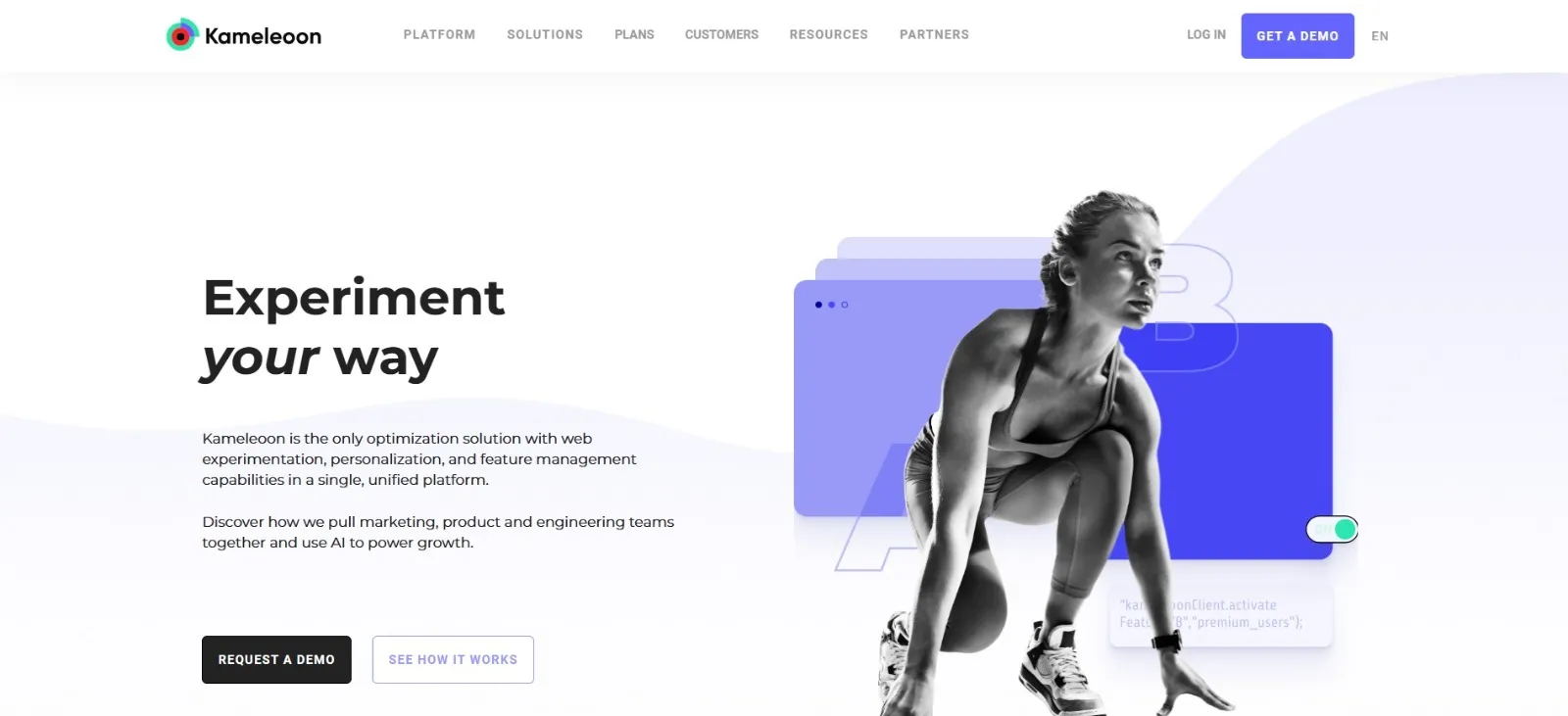
Kameleoon offers a unified A/B Testing Platform that caters to both marketers and developers. It combines web and mobile testing with full-stack server-side experimentation, ensuring that all teams from marketing to engineering, work off one platform.
Its AI-powered segmentation lets ecommerce stores deliver real-time personalization based on behavioral and contextual data. Kameleoon is especially effective for omnichannel retailers who want consistent user experiences across devices and sessions.
For D2C brands, it enables fast iteration and experimentation while maintaining the rigor of enterprise-grade testing frameworks.
Best for: Omnichannel ecommerce businesses looking for full-stack experimentation across devices and teams.
While Kameleoon is a capable experimentation and personalization platform—known for features such as AI-powered targeting, server-side and client-side testing, and a strong enterprise focus. It is geared particularly toward large organizations with deep technical resources, complex infrastructure, and the need for full-stack experimentation. In contrast, CustomFit.ai is built with the marketer and growth team in mind: it emphasises no-code visual editing, faster setup, fewer dependencies on engineering, and smoother integration with mainstream e-commerce platforms. This means you can move from idea to experiment to insight more quickly, without needing a large development backlog. Moreover, for many teams the total cost, operational overhead and learning curve of an enterprise-grade platform like Kameleoon can be a barrier. With CustomFit.ai you get accessibility, agility and human support that sidesteps many of the technical and organisational drag points. If your priority is rapid experimentation, conversion uplift, and making personalization accessible to non-technical users rather than managing a heavy infrastructure stack, then CustomFit.ai offers a more direct, practical pathway.

Dynamic Yield is an A/B Testing Platform focused on delivering hyper-personalized experiences across web, mobile, email, and in-store channels. Acquired by Mastercard, it’s widely used by global ecommerce companies that want to combine personalization, recommendations, and testing under one system.
Dynamic Yield’s real power lies in its ability to build and test personalization logic at scale; you can run experiments that dynamically adjust product recommendations, homepage banners, or messaging based on real-time user behavior.
It’s one of the few tools that bridges A/B testing and 1:1 personalization so seamlessly, making it a preferred choice for enterprise retailers and D2C brands focused on high-impact customer journeys.
Best for: Enterprise ecommerce and retail brands looking for personalization-led experimentation at scale.
While Dynamic Yield is a highly capable platform—offering robust AI-driven personalization, cross-channel optimization, and enterprise-grade scale and integrations —its strengths come with trade-offs that may not serve every team equally. In contrast, CustomFit.ai is built to simplify experimentation and personalization, especially for growth-led, marketing-driven, or e-commerce teams who want to move quickly, iterate freely, and reduce reliance on heavy engineering or infrastructure. CustomFit.ai emphasises visual editing, intuitive workflows, and fast launch of tests and personalized experiences without extensive setup. With fewer layers of technical complexity, smaller onboarding overhead, and a focus on conversion-driven output rather than full-scale enterprise architecture, CustomFit.ai can offer a more accessible path into A/B testing and personalization. If your team’s priority is agility, rapid experimentation, less dependency on developers, and more direct control over your optimization work, then choosing CustomFit.ai instead of Dynamic Yield means opting for speed, clarity, and simplicity over broad enterprise depth.
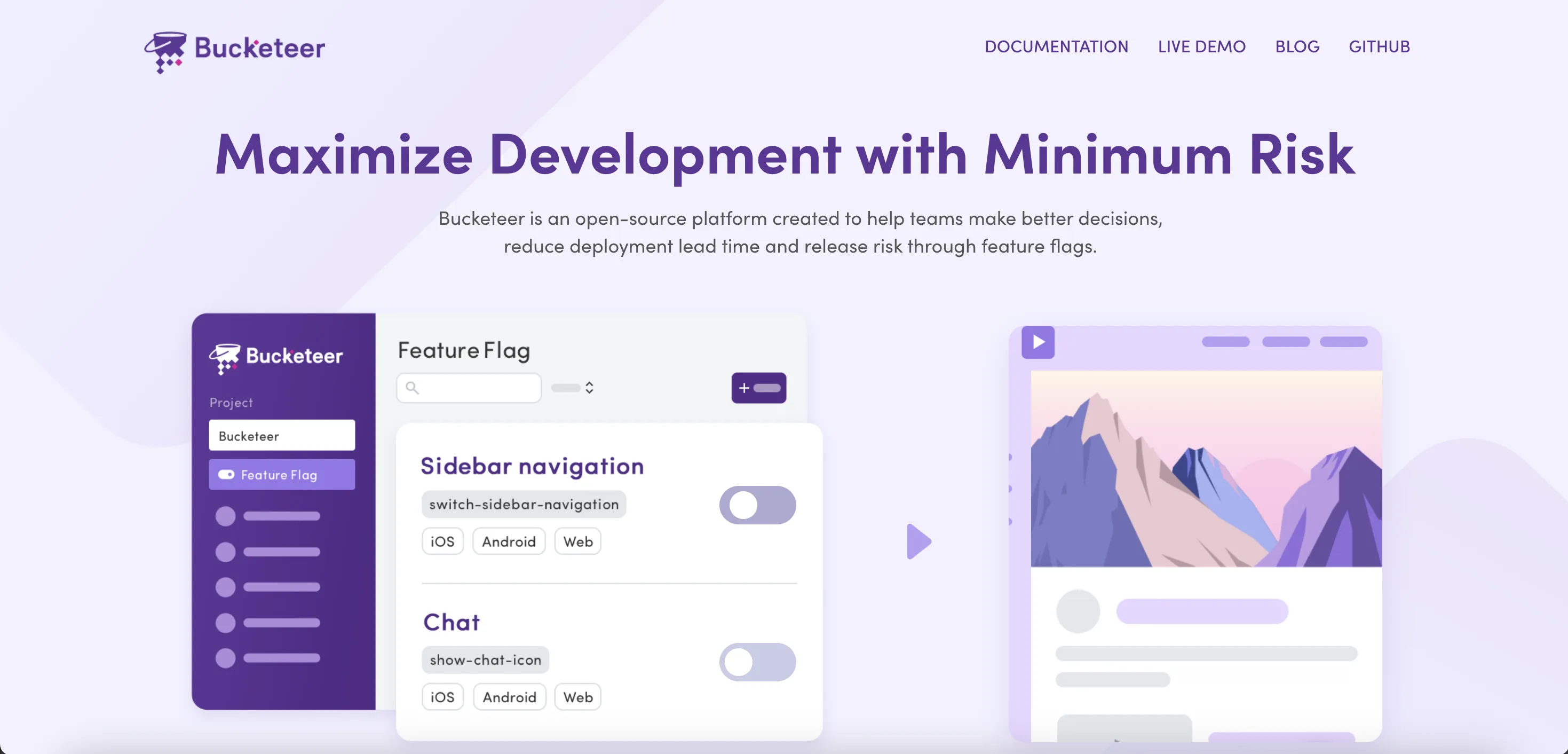
Bucketeer is a modern, cloud-native alternative to legacy experimentation tools. It supports multi-environment rollouts, segmentation, and A/B testing with strong API integrations.
Best for: Modern cloud-based teams running full-stack experiments with scalability in mind.
Bucketeer is a developer-focused platform built mainly for feature flags and code-driven A/B testing, which works well for engineering teams that want full control over backend rollouts. This strength also makes it less accessible for marketers or growth teams because most experiments require developer time, technical setup, and deployment cycles. CustomFit.ai takes a very different approach. It is designed for teams who want to test ideas and personalise website experiences quickly without relying on code or complex workflows. With a visual editor, instant experiment launches, and a focus on improving conversions rather than managing infrastructure, CustomFit.ai gives non-technical teams the freedom to move faster. If your priority is agility, quick execution, and marketing-led optimization rather than engineering-heavy feature flagging, CustomFit.ai becomes the more practical choice.

Monetate bridges the gap between A/B Testing and personalized commerce experiences. Originally built for retailers, it offers a full suite of tools to test, personalize, and optimize customer journeys at scale.
The platform supports A/B, multivariate, and dynamic testing, allowing ecommerce teams to optimize everything from homepage layouts to recommendation modules. What makes Monetate unique is its focus on contextual relevance. It uses real-time data signals like location, device type, and past browsing behavior to tailor each visitor’s experience.
For ecommerce stores and D2C brands that want to move beyond simple split testing into predictive, data-led personalization, Monetate delivers the balance between performance and intelligence.
Best for: Ecommerce retailers seeking to merge personalization with large-scale A/B testing and analytics.
Monetate is a strong enterprise platform with extensive capabilities in A/B testing, personalization, and product recommendations, but it is often best suited for large organizations with significant budgets, long implementation cycles, and dedicated technical teams. Many businesses find that the platform’s complexity, cost, and slower execution pace make it difficult for marketing or growth teams to move quickly. CustomFit.ai offers a more practical alternative by focusing on speed, simplicity, and hands-on usability. It allows teams to run experiments, personalise pages, and make visual changes without depending heavily on developers or navigating a long onboarding process. For brands that want to act fast, test frequently, and prioritise conversion uplift over technical overhead, CustomFit.ai provides a more agile and accessible solution compared to Monetate.
If you’re a D2C brand on Shopify and want to launch tests without touching code, CustomFit.ai is worth a look. It lets marketers ship variants and behavior-based personalizations in minutes, while tracking the revenue impact clearly.
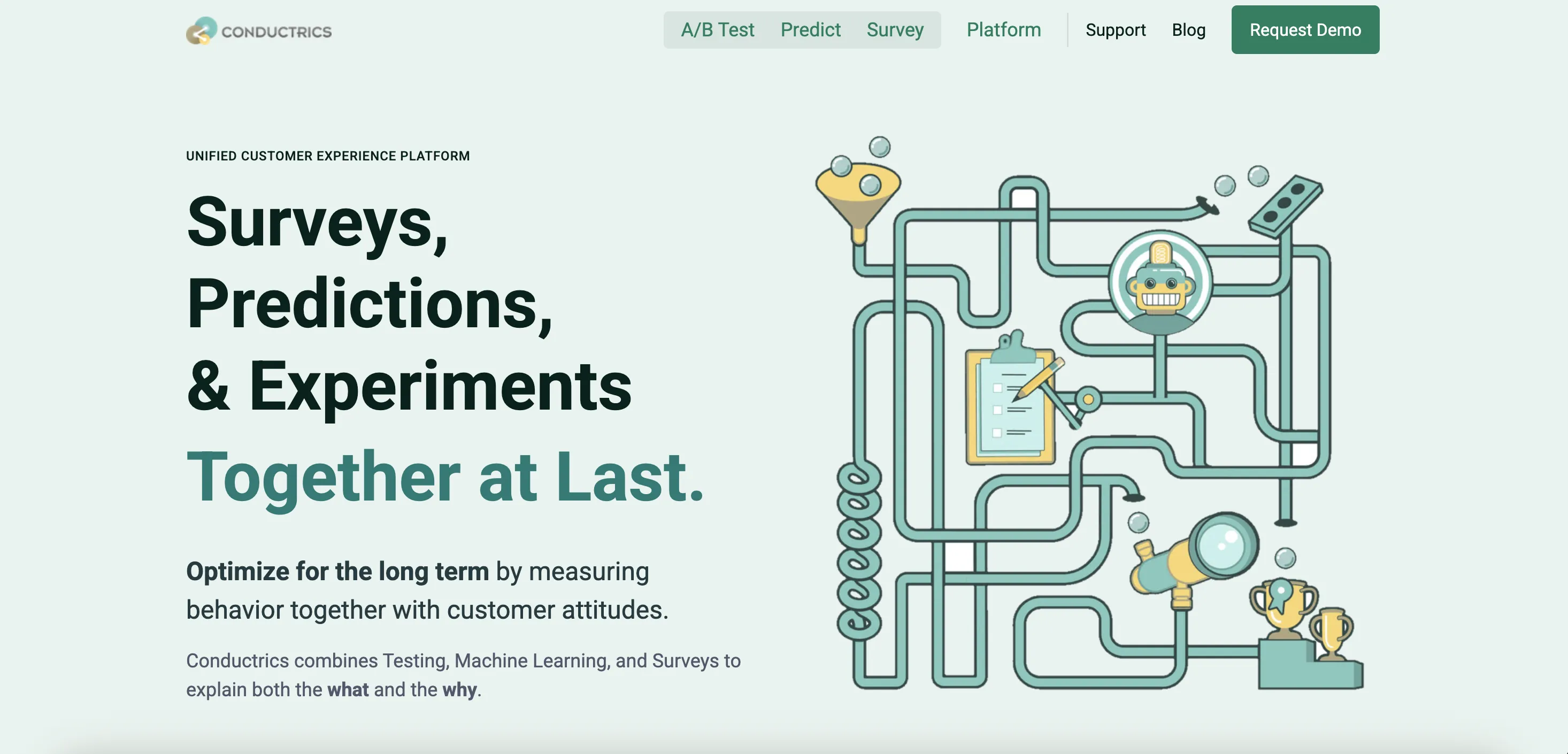
Conductrics is an enterprise experimentation platform that goes deep into the math of optimization. It supports A/B Testing, multivariate experiments, and adaptive learning all powered by advanced statistical models like ANOVA and confidence interval-based decisioning.
Rather than relying purely on surface-level metrics, Conductrics focuses on helping organizations make statistically sound decisions. This makes it popular among businesses that require high data integrity, such as banks, airlines, and enterprise ecommerce companies.
It’s flexible enough for both business users and developers, offering a visual interface as well as a powerful API for custom integration.
Best for: Enterprise teams who prioritize data accuracy, advanced analytics, and API-driven experimentation.
Conductrics is known for its rule-based experimentation and decisioning engine, which works well for teams that want highly technical control and are comfortable managing logic models, APIs, and backend integrations. However, this also means the platform often leans heavily on developer involvement and requires more technical setup to unlock its full capabilities. CustomFit.ai focuses on making experimentation and personalization accessible to marketers, founders, and growth teams without needing deep engineering support. With a visual editor, quick setup, and instant experiment launches, it helps teams move from idea to execution much faster. Instead of managing complex rules and technical workflows, teams can directly make page changes, create personalized journeys, and test variations with minimal friction. For organisations that prioritise agility, ease of use, and faster conversion improvements rather than building and maintaining complex logic systems, CustomFit.ai becomes a more practical and human-friendly choice compared to Conductrics.
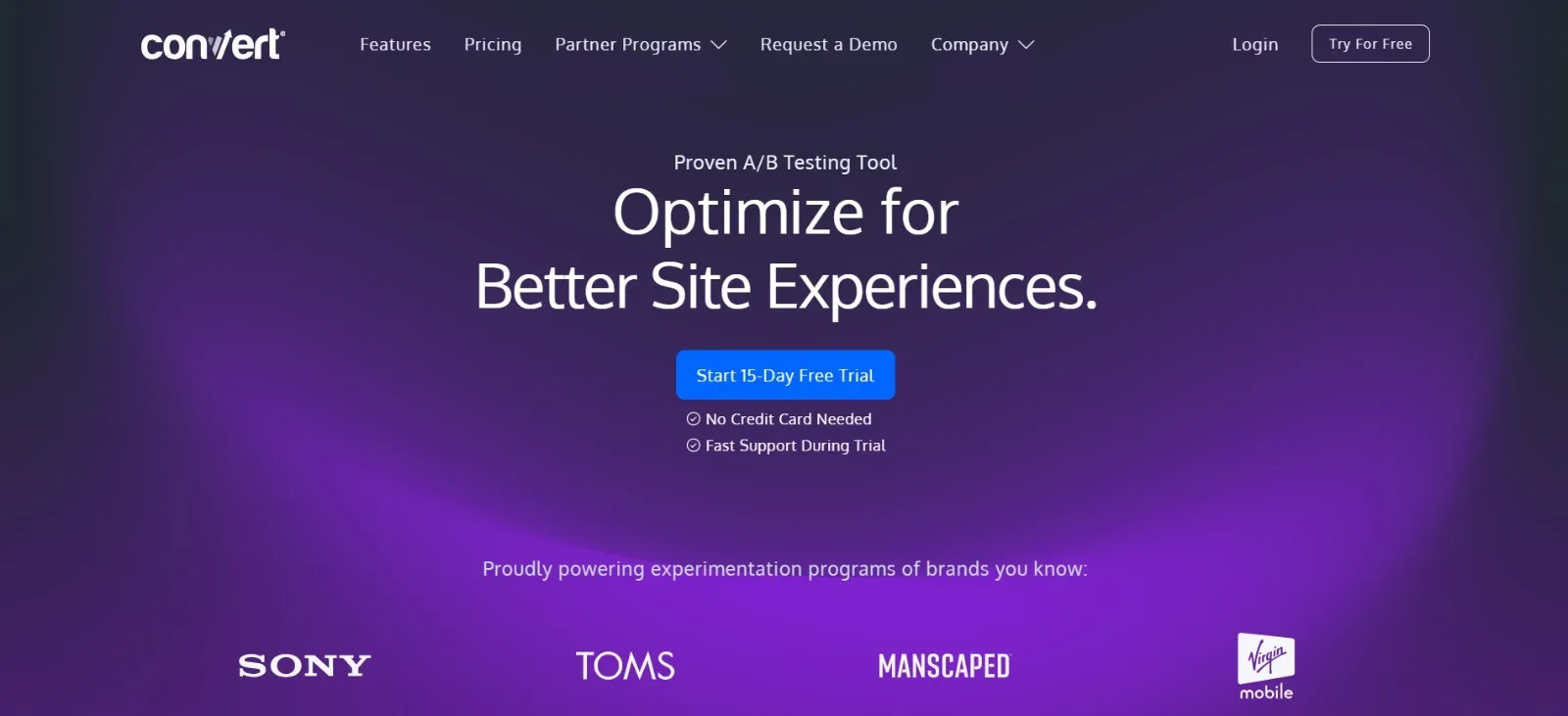
Convert Experiences is a powerful yet privacy-compliant A/B Testing Platform built for marketers who value accuracy and data control. Unlike some tools that rely heavily on third-party tracking, Convert Experiences emphasizes GDPR compliance and first-party data handling which is a huge advantage for global ecommerce brands operating in strict privacy environments.
It supports A/B, split URL, and multivariate tests, making it flexible for both simple page tweaks and complex design comparisons. The interface is clean and intuitive, allowing marketing teams to set up tests without much technical help.
What truly sets Convert apart is its speed and precision. The statistical engine is optimized for quick insights, ensuring you can roll out winning variants faster.
Best for: Ecommerce teams that prioritize privacy, data control, and fast, reliable testing to optimize landing pages and product experiences.
Convert Experiences is a competent platform for A/B testing that suits many mid-sized organisations, but it still often requires some developer support to set up complex experiments, while its interface and workflows may not be fully tailored for non-technical users focussed on growth and marketing agility. CustomFit.ai, on the other hand, is designed to empower marketers, growth teams, and e-commerce brands to launch tests, personalise experiences and iterate without heavy reliance on engineers or development cycles. With an intuitive visual editor, faster onboarding, and tighter integration with e-commerce platforms, CustomFit.ai lets teams move quickly from concept to experiment, enabling them to focus on improving conversions and user experience rather than managing tool complexity. If your priority is speed, simplicity, and real-world results over technical setup and configuration, CustomFit.ai offers a more accessible, actionable pathway.
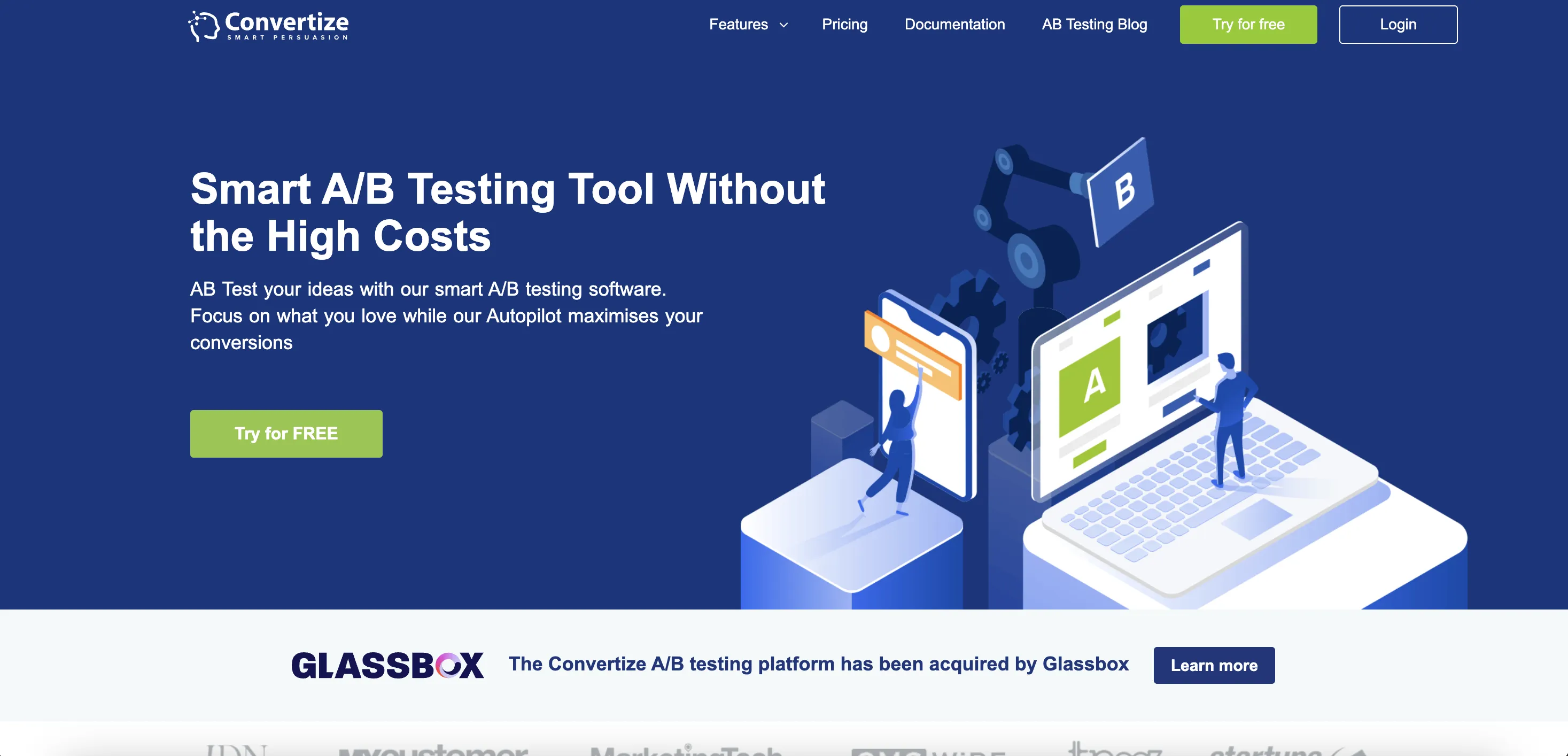
Convertize brings experimentation closer to marketers by removing technical barriers entirely. It’s a no-code A/B Testing tool designed for small and mid-sized teams who want to experiment with headlines, CTAs, layouts, and visuals without waiting for development resources.
The platform features a visual editor that lets users make instant changes to a live site, set up A/B tests, and track performance all through an intuitive dashboard. One of Convertize’s highlights is its “Smart Notifications” feature, which dynamically engages users to reduce abandonment and boost sales.
For D2C ecommerce stores, Convertize provides a fast way to iterate on product page designs, banners, or checkout layouts to identify what resonates best with shoppers.
Best for: Smaller ecommerce or D2C brands that want to run A/B tests quickly and visually without touching code.
Convertize offers a solid solution for A/B testing and conversion optimization but tends to be better suited for teams ready to invest in understanding behavioural psychology, experiment design assumptions, and manual segmentation. While this is valuable, it often means more upfront effort, a steeper learning curve, and ongoing manual work to maintain momentum. CustomFit.ai takes a different path by making experimentation and personalization as frictionless as possible for growth and marketing teams. With a visual editor, seamless no-code workflows, faster launch times, and tight integrations for e-commerce platforms, it allows teams to test, iterate, and personalise without being slowed by tool complexity or technical dependencies. If your team values speed, simplicity and hands-on support over deep customisation and behavioural modeling, CustomFit.ai provides a more accessible and practical way to improve website performance.
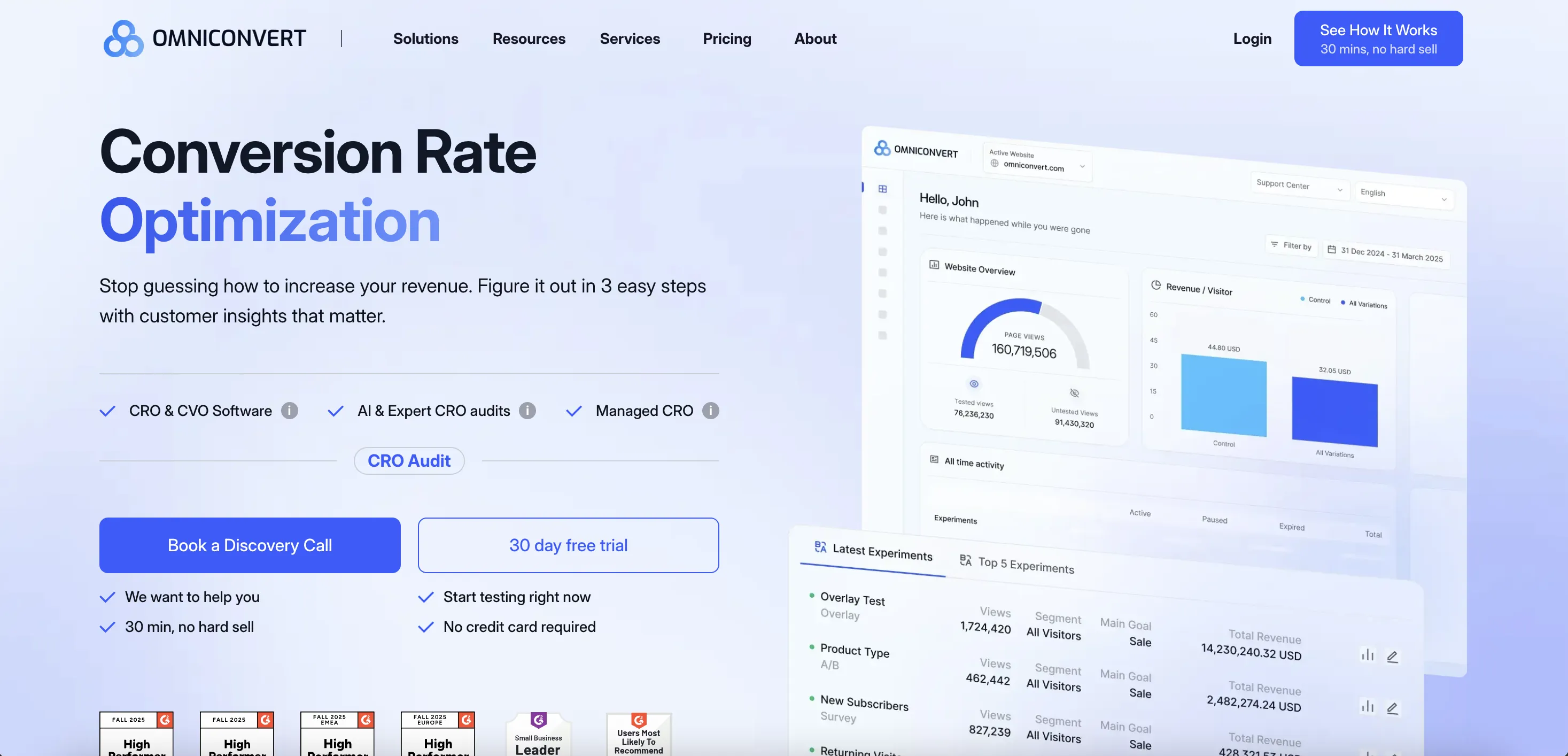
Omniconvert goes beyond A/B testing it’s an all-in-one CRO platform combining experimentation, personalization, segmentation, and surveys. It’s tailor-made for ecommerce stores that want to understand customer behavior deeply while running structured experiments.
Brands can test landing pages, product descriptions, and pricing elements while also capturing insights through pop-ups and feedback widgets. The platform’s segmentation features let marketers create highly targeted A/B tests based on traffic source, cart value, or user behavior.
For growing ecommerce brands looking to go beyond surface-level metrics, Omniconvert offers both the tools to test and the context to understand why something works.
Best for: Ecommerce and retail brands seeking an integrated A/B Testing Platform that combines CRO and behavioral analytics.
Omniconvert provides a full-spectrum platform for A/B testing, personalization and conversion optimisation, but this breadth often comes with trade-offs: more features means steeper setup, deeper technical integration, and more ongoing management. Teams may find themselves spending as much time managing the tool as running experiments. CustomFit.ai, by contrast, is designed for speed, accessibility and real impact. It enables marketers, growth teams, and e-commerce brands to launch tests and personalise experiences right away — without relying on developers or wrestling with configuration. With visual editing, smoother workflows, and quicker time to live, CustomFit.ai helps teams focus on what matters: learning from visitor behaviour and improving conversions, not tool logistics. If you prefer a simplified, hands-on solution that reduces overhead and unlocks faster experimentation, CustomFit.ai offers a more agile and user-friendly path than Omniconvert.
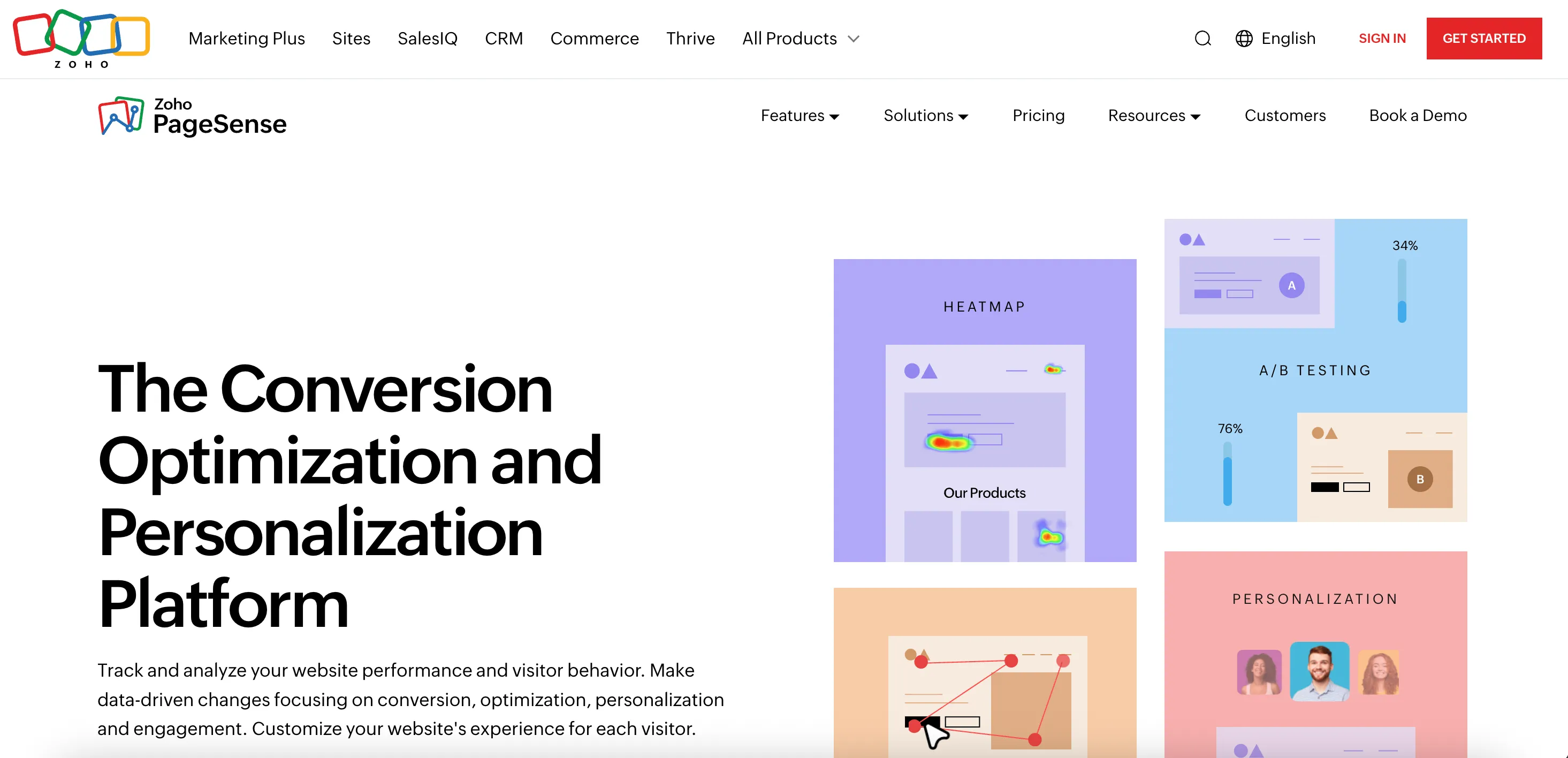
Zoho PageSense is a cost-effective A/B Testing tool from the Zoho ecosystem, making it perfect for startups, small businesses, and emerging ecommerce stores. It includes everything you need for CRO, from heatmaps and session recordings to A/B testing and funnel analytics.
Its biggest advantage is accessibility. Marketing teams can create experiments in minutes using the visual editor and track which design, content, or offer improves conversions.
PageSense’s reporting dashboard is designed for clarity, helping even non-technical users understand test results easily. For D2C stores that want reliable A/B testing without enterprise-level costs, Zoho PageSense is a strong starting point.
Best for: Small to mid-sized ecommerce stores that need affordable and simple A/B testing to optimize user experience.
While Zoho PageSense offers a wide range of experimentation and analytics features including heatmaps, funnel tracking, form analytics and session recording, it remains a more general-purpose optimization suite. If your team is focused primarily on fast, visual A/B testing and on-site personalization with minimal technical overhead, CustomFit.ai offers a more direct path. CustomFit.ai is built around ease of use for growth and marketing teams: no-code visual edits, rapid setup, and fewer dependencies on engineering. This means you can move from idea to live test more quickly, iterate often and concentrate on what actually moves the needle—rather than managing feature-rich infrastructure. In short: if your priority is speed, control, and conversion uplift by marketers rather than deep analytics and multi-tool workflows, then CustomFit.ai provides a simpler, more focused alternative to Zoho PageSense.
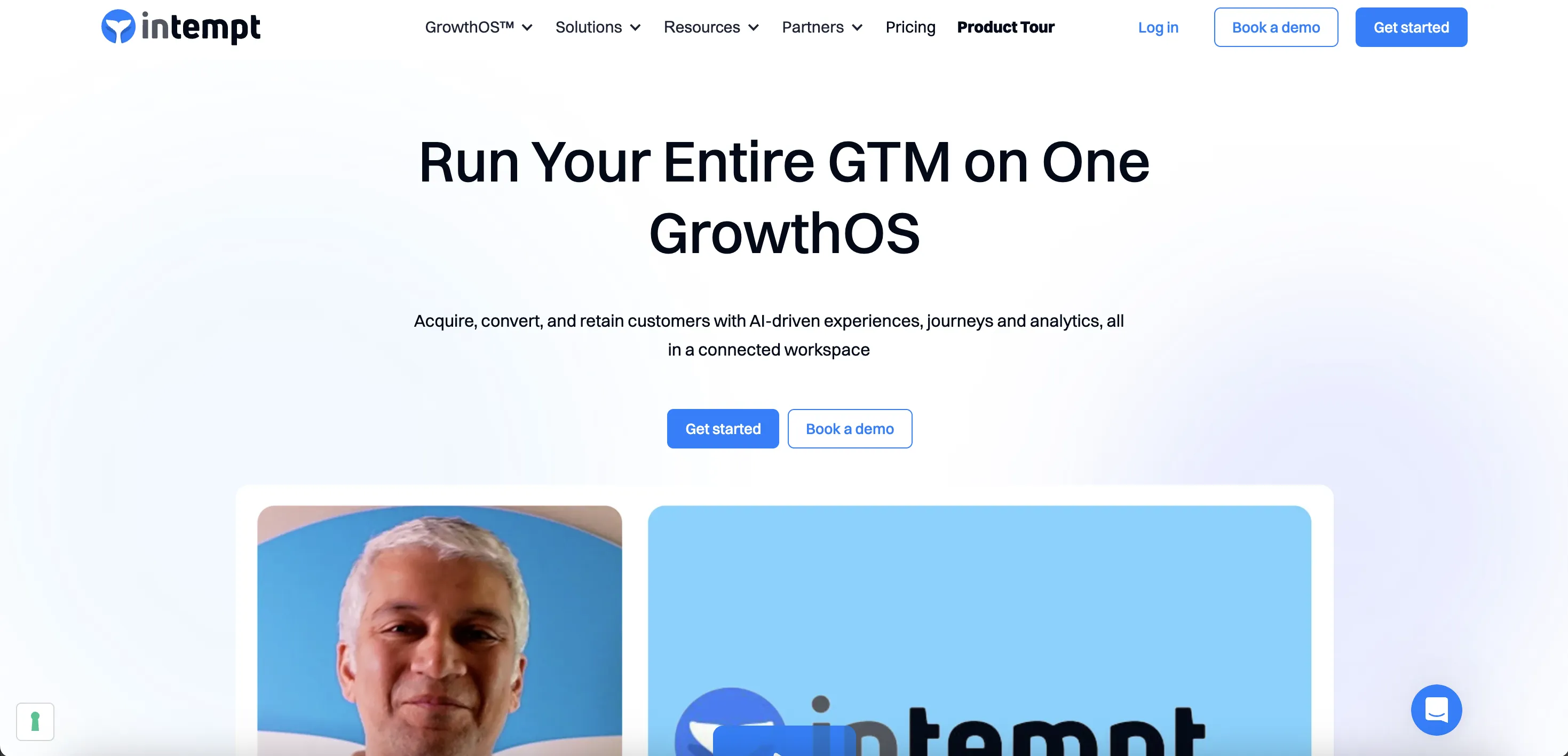
Intempt focuses on customer journey experimentation, connecting behavioral data, segmentation, and personalized experiences across channels.
For ecommerce teams, it allows experiments not just on pages but across the full funnel: ads, emails, on-site personalization, and re-engagement flows.
Best for: D2C brands seeking data-driven personalization across the full customer journey.
While Intempt is a sophisticated growth platform that brings together customer data, automation, AI agents, and multi-channel journeys, it also brings higher complexity, broader scope, and often a heavier lift for teams without full technical or data resources. By contrast, CustomFit.ai is built to simplify experimentation and personalization for growth and marketing teams who want to move quickly on their website. It enables no-code visual editing, fast experiment launches, and personalization aimed at on-site conversion rather than full lifecycle orchestration. If your focus is optimizing pages, improving conversions, and testing through marketing-led workflows without building a full data and operations stack, CustomFit.ai gives you a more accessible, pragmatic path.
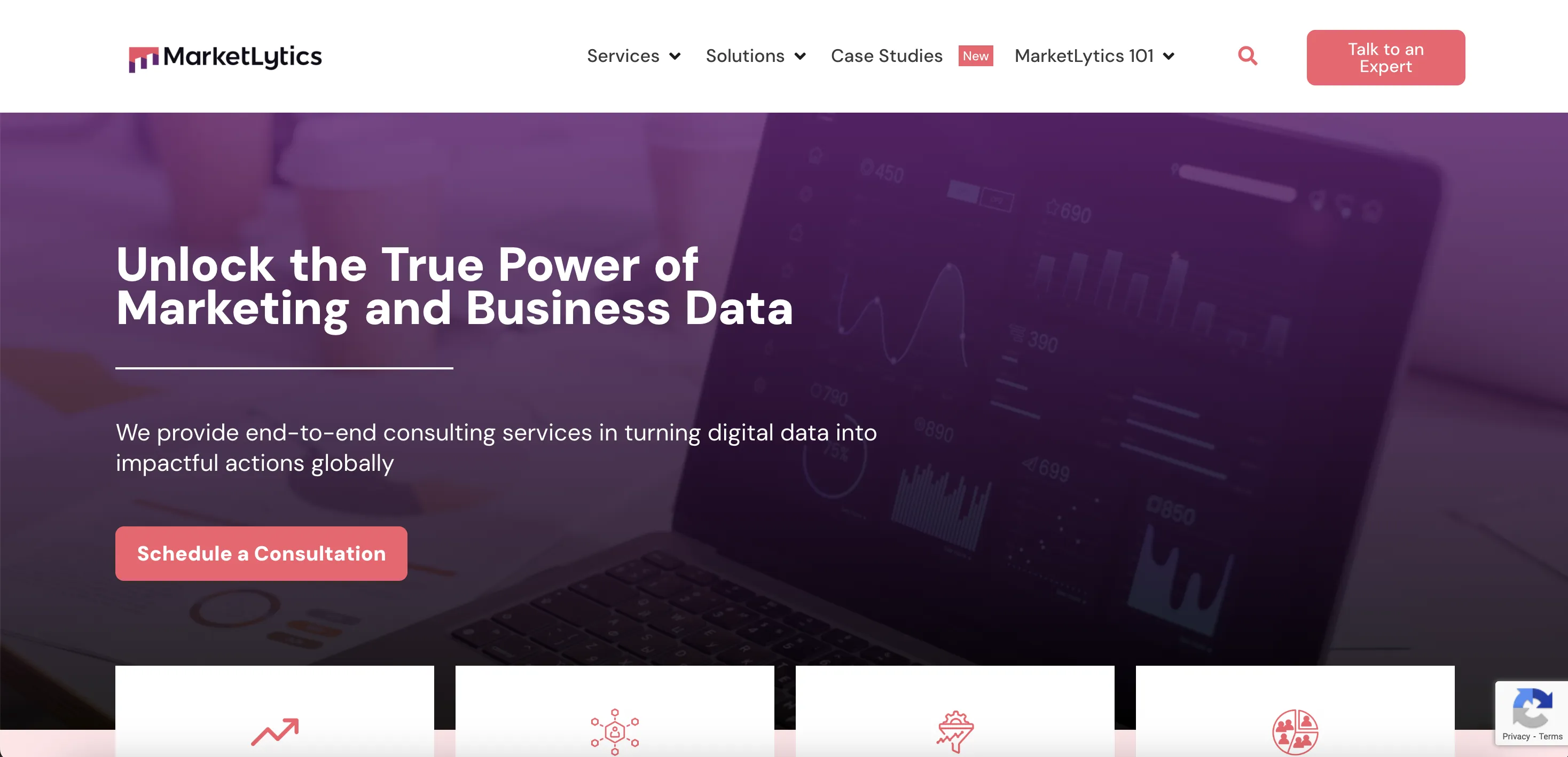
MarketLytics combines analytics consulting with A/B testing implementation, particularly around Google Analytics and GA4-based experiments.
It’s ideal for teams that want expert-led setup of tracking and testing rather than self-service tools.
Best for: Brands seeking consultancy-driven analytics and testing alignment.
When you’re deciding between CustomFit.ai and MarketLytics’ experimentation or optimisation services, the choice often comes down to your team size, time to launch, and need for speed versus breadth. MarketLytics is known as a consultancy-style firm that helps brands build analytics foundations, set up tracking, run structured experiments, and integrate deep data systems. That’s valuable, but it also means bigger upfront investment, heavier coordination, and often longer timeline before you see live results. CustomFit.ai, in contrast, is built for teams who want to act quickly: you can launch visual edits, A/B tests and personalised experiences with minimal engineering dependency, and move from idea to experiment far faster. If your priority is rapid iteration, agility, and giving your marketing or growth team direct control, CustomFit.ai is more accessible and practical. On the other hand, if you’re building a full analytics stack or need large-scale experimentation across multiple touchpoints with heavy data infrastructure, then a partner like MarketLytics might make sense—but for many brands focused on on-site conversion gains, CustomFit.ai provides a clearer, faster path.
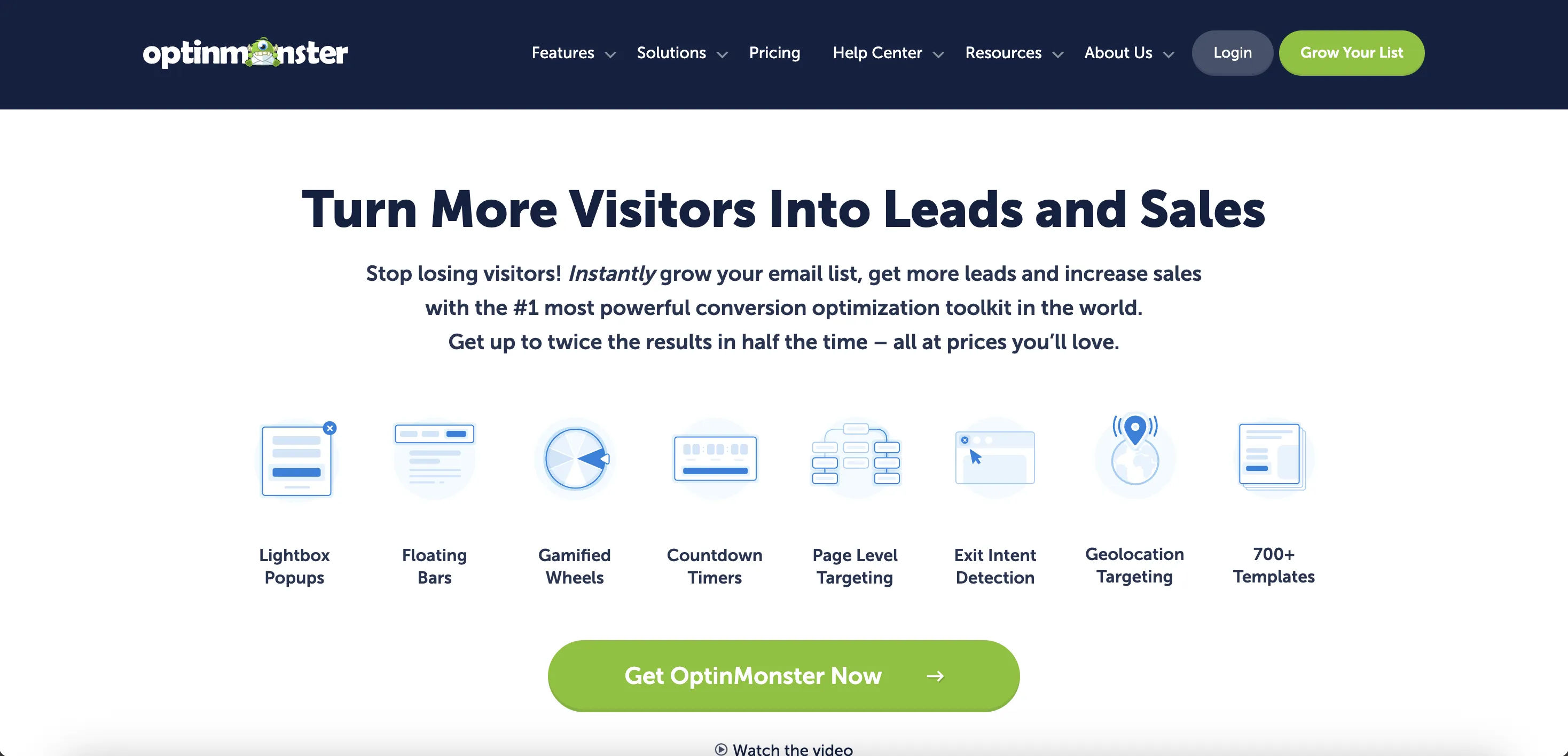
OptinMonster is best known for its powerful lead-generation popups, but it’s also a capable A/B Testing Platform for on-site optimization. Marketers can test headlines, colors, call-to-action buttons, and offer timing to discover which combination converts more visitors into subscribers or customers.
Its drag-and-drop builder makes campaign creation straightforward, while the built-in analytics help you see which designs perform best. For ecommerce brands focused on growing their email list or reducing cart abandonment, OptinMonster offers a clear path to measurable results.
Best for: Ecommerce stores that want to increase conversions from popups, lead forms, and exit-intent offers.
OptinMonster is a strong tool focused on lead capture—from pop-ups and floating bars to overlays and coupon wheels—but its scope is mostly tied to lead generation rather than full-funnel experimentation and personalization. While it offers A/B testing and behavior-based targeting, it’s primarily about capturing emails or driving a specific conversion event on the page. In contrast, CustomFit.ai is built for broader experimentation and site-wide personalization, allowing you to change page layouts, test variations, personalise entire visitor journeys—not just pop-ups. CustomFit.ai empowers growth teams and marketers to run visual edits, segment visitors based on behaviour or intent, and personalise without heavy engineering overhead. If your goal extends beyond capturing leads (as is OptinMonster’s forte) to improving overall conversion rates, testing entire page experiences, and personalising user journeys at scale, then CustomFit.ai offers a more full-spectrum solution tailored for that depth rather than just pop-up campaigns.

OptiMonk focuses on helping ecommerce brands create personalized shopping experiences through smart popups and messages. It’s a journey-optimization platform that includes built-in A/B Testing to fine-tune on-site campaigns.
The platform’s AI-assisted recommendations analyze visitor behavior and suggest the best variations to display, whether that’s a discount popup, cart reminder, or loyalty message. It integrates easily with Shopify, HubSpot, and WooCommerce, making it a go-to solution for D2C brands that rely heavily on direct conversions.
Best for: Ecommerce and D2C businesses looking for personalized popup and journey testing to reduce bounce rates and increase conversions.
While OptiMonk excels as a versatile pop-up and on-site messaging tool—allowing you to create popups, sticky bars, gamified overlays, and basic personalization—its core strength still centres on triggered messages rather than full-blown site-wide experimentation. By contrast, CustomFit.ai is built to empower entire website optimisation workflows: you can visually edit pages, run A/B tests across page layouts or flows, personalise content based on visitor behaviour, and iterate without heavy reliance on engineering resources. OptiMonk is great for capturing leads, reducing cart abandonment and showing targeted offers—but if your goal is broader conversion rate optimisation, seamless personalisation of website experiences, and faster experiment turn-around for marketing or growth teams, then CustomFit.ai delivers a more comprehensive solution tailored to marketers who want to act quickly, test confidently and focus on measurable uplift rather than building and managing pop-up campaigns alone.
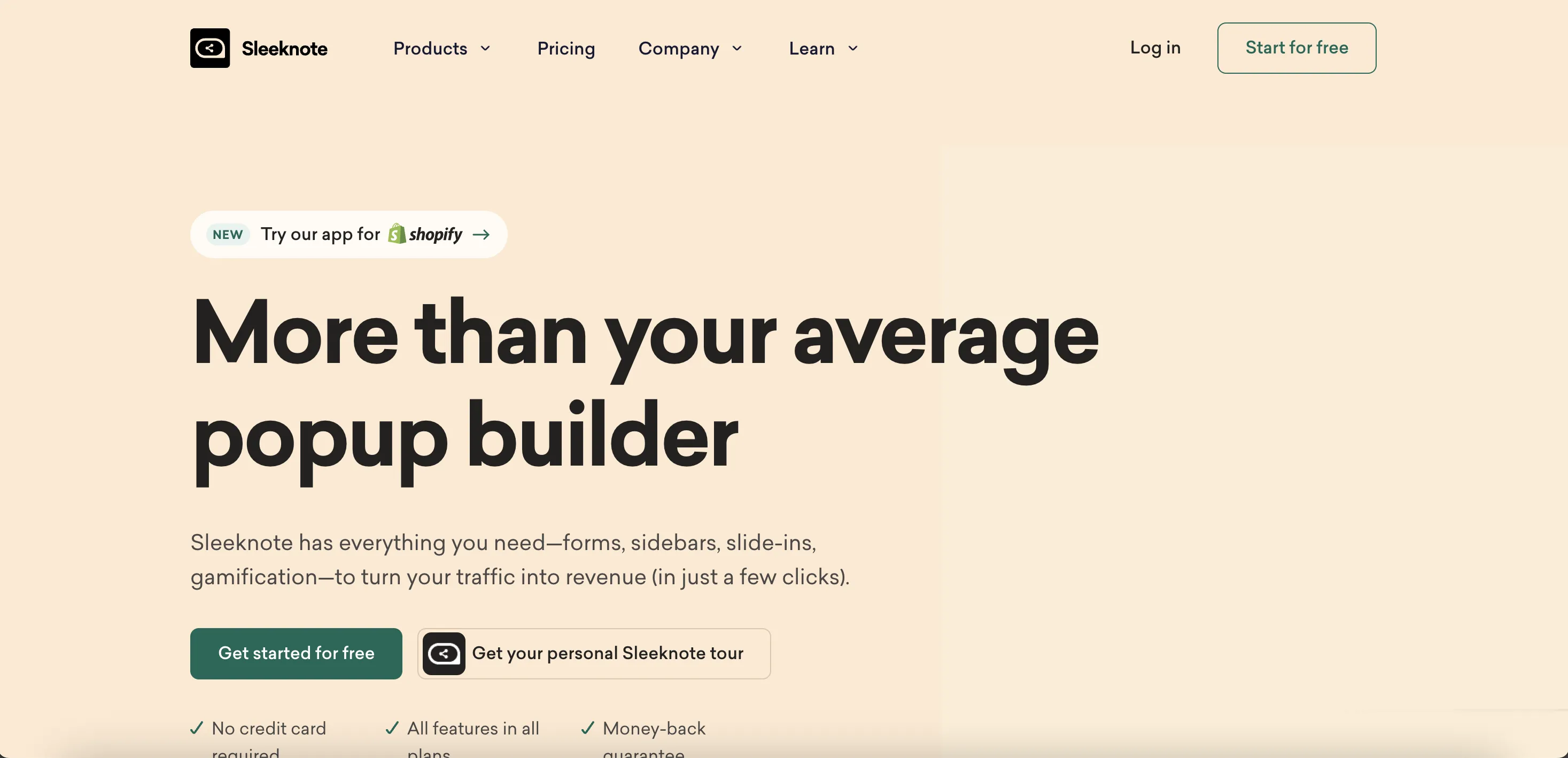
Sleeknote takes a more refined approach to popups and onsite messages. Rather than intrusive popups, it focuses on creating subtle and branded experiences that fit the tone of a website.
Marketers can A/B test different designs, headlines, and triggers to find the most engaging way to capture attention without disrupting the user experience. It’s particularly useful for ecommerce stores that care about maintaining a premium brand image while running experiments to improve engagement.
Best for: Brands that want lightweight, non-intrusive A/B testing for onsite messages and popups.
Sleeknote is a strong tool for creating pop-ups, slide-ins, forms and onsite messages, and it works well for brands focused mainly on lead capture and triggered offers. However, its scope is largely limited to these interaction layers. CustomFit.ai gives teams a much wider canvas to work with by enabling full-site experimentation and personalisation. Instead of only showing pop-ups, marketers can visually edit pages, test different layouts, personalise entire user journeys, and launch A/B tests without relying on developers. This makes it easier to improve conversion rates across the whole website, not just through overlays or sign-up prompts. If your goal is broader CRO, faster iteration, and deeper personalisation rather than running pop-up-centric campaigns, CustomFit.ai offers a more complete and flexible solution than Sleeknote.
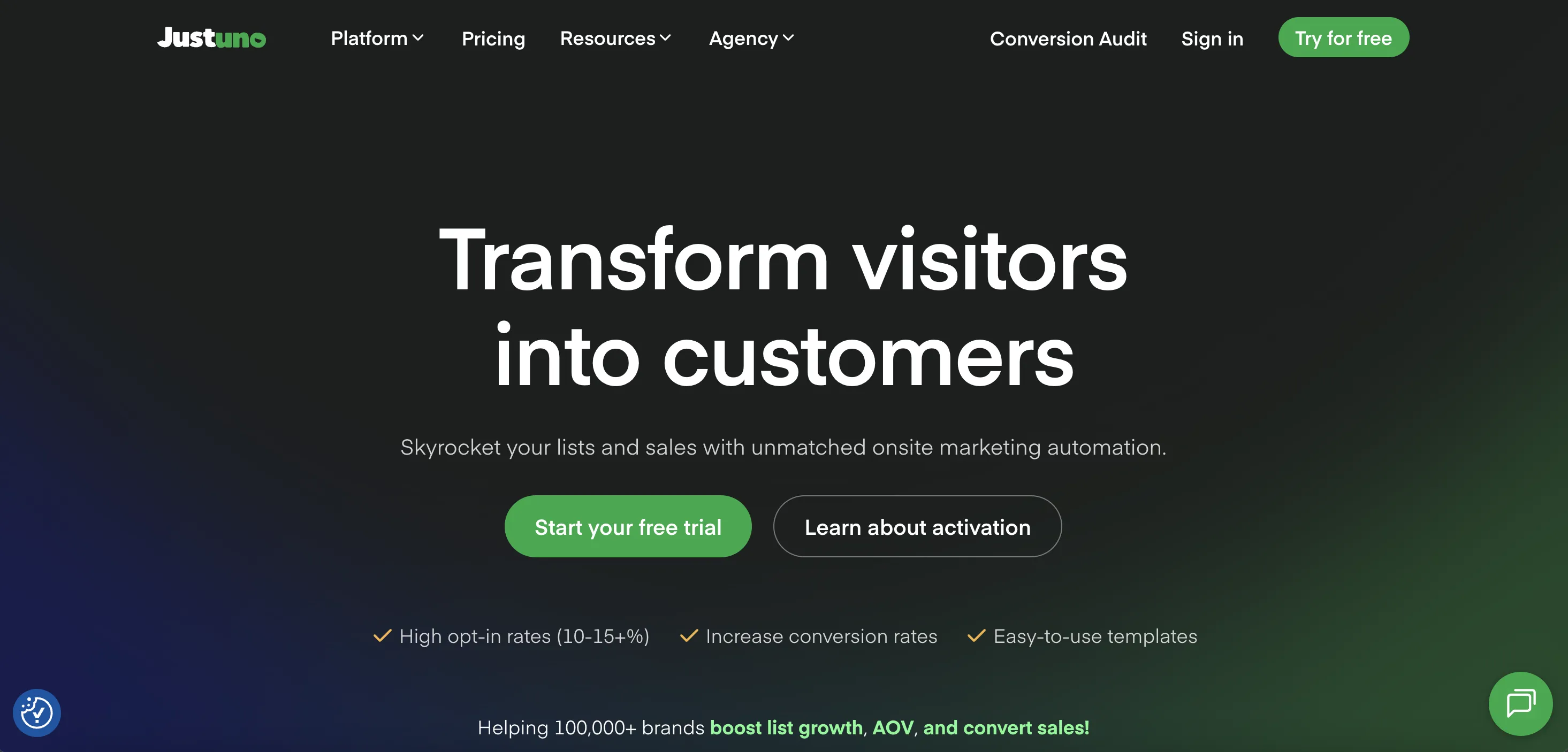
Justuno is an all-in-one Conversion Rate Optimization (CRO) suite that includes A/B testing, segmentation, and personalization features. It enables ecommerce marketers to run multivariate tests on popups, banners, and promotions to determine what drives the highest conversions.
What makes Justuno particularly useful is its targeting flexibility. You can trigger campaigns based on user intent, traffic source, or onsite behavior. For example, a user arriving from an Instagram ad can see a different offer than one coming from organic search.
Best for: Ecommerce marketers looking for an all-in-one CRO and A/B Testing Platform with robust targeting and multivariate capabilities.
Justuno is well known for its pop-ups, banners, and promotional overlays, making it a good choice for brands focused mainly on lead capture, email collection, and onsite promotional messaging. However, its capabilities are centered around creating and displaying these messages rather than optimizing the entire website experience. CustomFit.ai offers a much broader approach by allowing teams to run full-site A/B tests, visually edit page elements, personalise entire user journeys, and experiment with layouts or content without needing developer support. Instead of relying primarily on pop-ups to drive conversions, CustomFit.ai helps improve the core website experience itself, which often leads to more meaningful and sustainable conversion uplift. For teams that want deeper CRO capabilities, faster testing cycles, and the ability to personalise beyond overlays and pop-ups, CustomFit.ai provides a more complete and flexible solution compared to Justuno.
Several readers asked how to run no-code tests on Shopify product pages without theme work. CustomFit.ai handles that use case well and supports behavior-driven segments (device, source, campaign, region) out of the box.
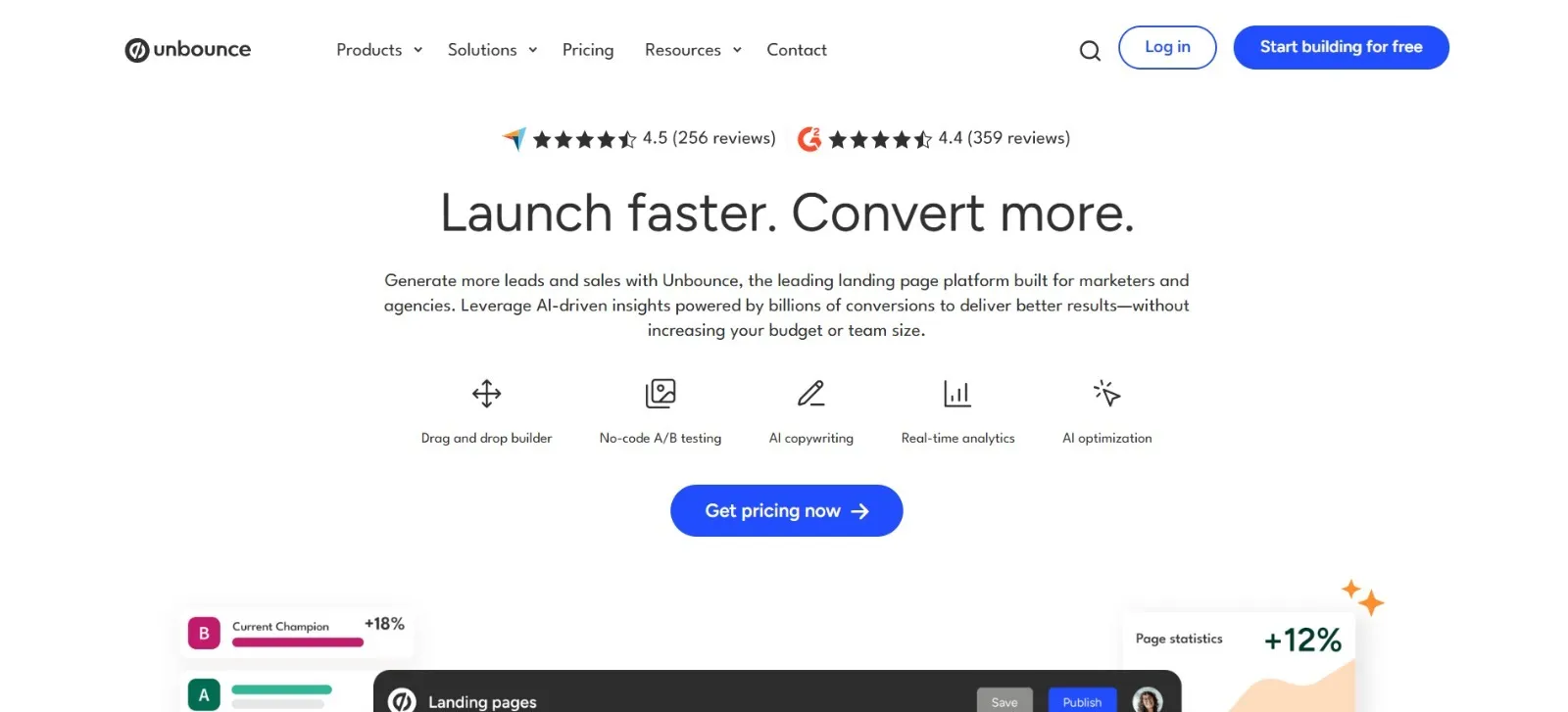
Unbounce started as a landing-page builder but evolved into a robust A/B Testing Platform. It allows marketers to design, publish, and experiment with landing pages without needing developer support.
Its standout feature, Smart Traffic, automatically sends visitors to the version of a page most likely to convert effectively turning every test into an ongoing optimization process.
For ecommerce brands running multiple campaigns, Unbounce helps test product offers, copy variations, or promotional pages rapidly, giving a clear picture of what drives the best ROI.
Best for: Marketers and ecommerce teams who need to create and test high-converting landing pages quickly.
Unbounce is a strong landing page builder designed mainly for creating standalone pages and pop-ups, making it useful when you want to quickly launch campaign-specific pages without touching your main site. But its strength also becomes a limitation when you want to optimise and personalise your existing website itself. CustomFit.ai focuses on improving the experiences visitors see on your actual site, not just on isolated landing pages. It allows marketers and growth teams to run full-site A/B tests, visually edit existing pages, personalise journeys for different audiences, and launch experiments without involving developers. Instead of managing separate landing pages or duplicating content, CustomFit.ai works directly with your live storefront or website, helping you improve conversions where traffic already flows. If your goal is to enhance your entire site experience, test real user journeys, and personalise content at scale rather than only building new landing pages, CustomFit.ai provides a far more flexible and impactful solution than Unbounce.
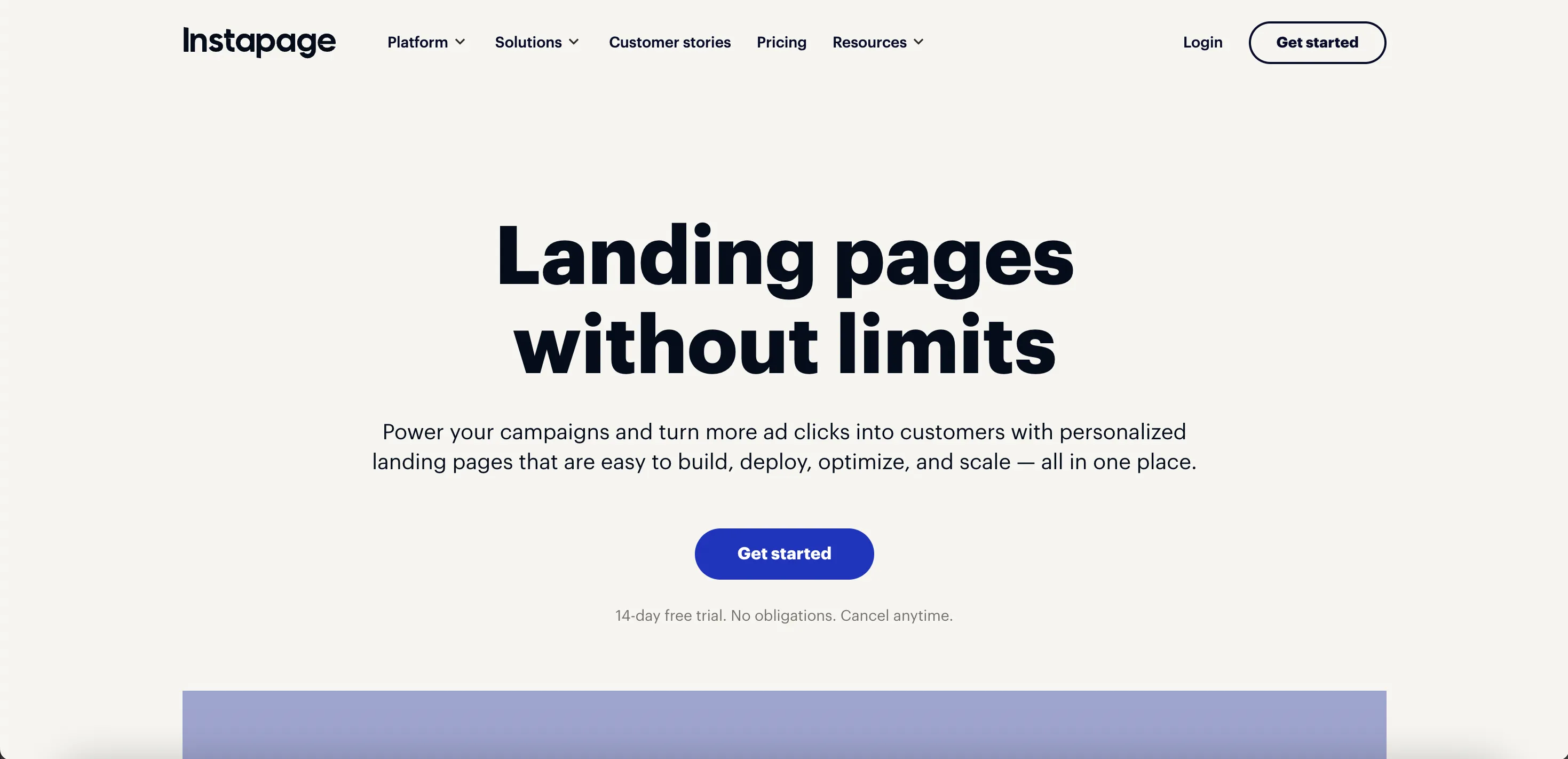
Instapage is designed for businesses that take their paid advertising seriously. It’s a landing-page and A/B Testing tool built to optimize what happens after a user clicks an ad often the most critical step in a campaign.
With dynamic text replacement, advanced analytics, and collaborative editing, Instapage helps teams create multiple landing-page versions and identify which combination of design and copy improves conversion rates the most.
It’s especially popular among performance marketers and ecommerce brands running PPC campaigns who want to eliminate wasted ad spend through post-click optimization.
Best for: Ecommerce and D2C brands focused on advertising efficiency and conversion optimization through landing-page A/B testing.
Instapage is great for creating standalone landing pages, especially for paid campaigns, but its focus stays largely on building and optimizing those isolated pages rather than improving the overall website experience. CustomFit.ai takes a much wider and more practical approach by enabling teams to optimise and personalise their actual website instead of relying on separate landing pages. With CustomFit.ai, marketers can visually edit existing pages, run full-site A/B tests, personalise content based on behaviour or traffic source, and iterate quickly without involving developers. This allows you to improve the real user journey that visitors experience every day, not just a few campaign pages. If your goal is deeper CRO, faster testing across your entire site, and personalization at scale, CustomFit.ai provides a more flexible and impactful solution than Instapage.
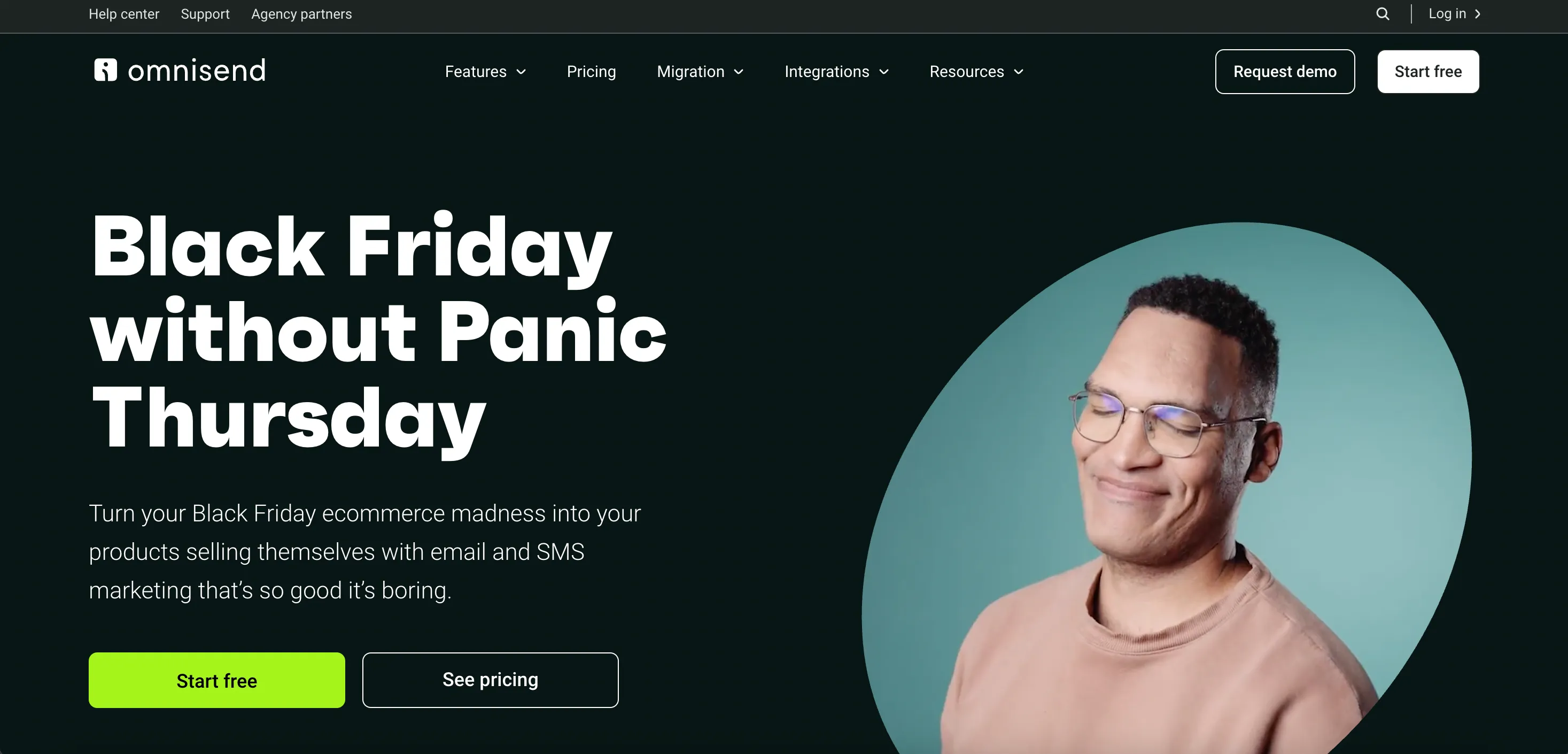
Omnisend is an email marketing and automation platform built for ecommerce. It supports A/B testing for subject lines, send times, email content, and campaign flows helping marketers identify which approach drives the highest open rates and sales.
Beyond email, Omnisend integrates SMS and push notifications, enabling cohesive cross-channel experiments. For online stores that rely heavily on lifecycle marketing, Omnisend simplifies optimization at every touchpoint.
Best for: Ecommerce marketers who want to A/B test email and SMS campaigns to improve engagement and sales.
Omnisend is a strong platform focused primarily on email, SMS, and pop-up marketing automation for e-commerce brands. It excels at sending targeted messages, building segment-based workflows, capturing leads and sending campaigns. However, its design centres more on outbound messaging than on optimising and personalising the actual website experience and visitor journey.
CustomFit.ai takes a different approach: instead of primarily managing email or message flows, it focuses on on-site experimentation and personalization. With CustomFit.ai you can visually edit pages, run A/B tests across page layouts or flows, personalise content based on visitor behaviour in real time, and iterate rapidly — all without needing heavy engineering support or waiting for campaign setup. If your goal is to improve conversions directly on the site, test new page experiences, and tailor journeys at the moment of visit — rather than mainly sending messages post-visit — then CustomFit.ai offers a more targeted, action-oriented solution.
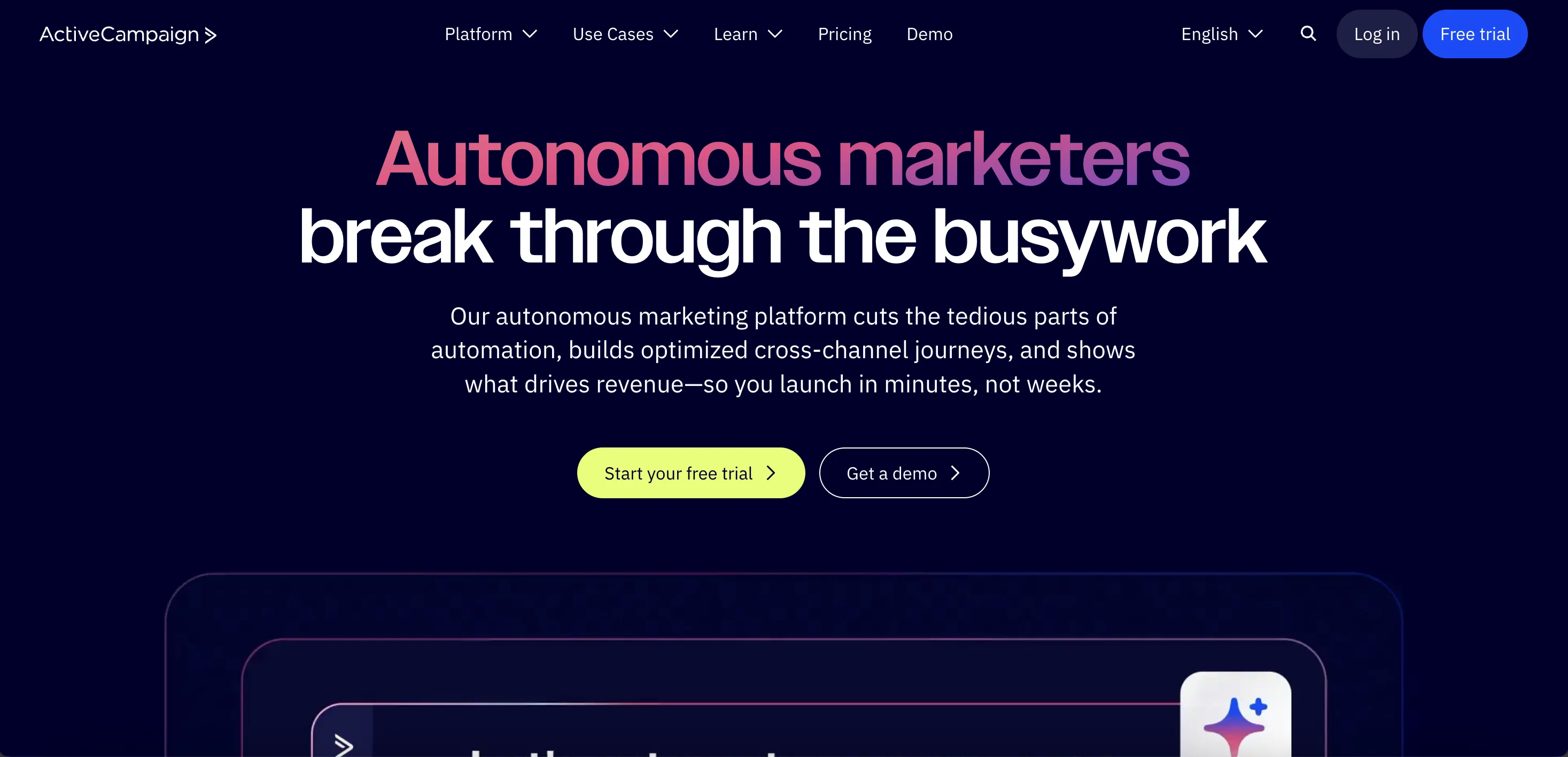
ActiveCampaign combines advanced automation workflows with A/B Testing capabilities across emails, forms, and landing pages. Its strength lies in the ability to personalize communication based on customer behavior and test every touchpoint of that experience.
For example, you can A/B test different email subject lines, sequences, or CTAs and automatically route future customers toward the version that performs best.
For D2C brands running ongoing email-driven sales funnels, ActiveCampaign ensures every campaign improves over time through consistent experimentation.
Best for: Ecommerce and SaaS brands looking to integrate A/B testing into automated customer journeys.
While ActiveCampaign is a solid all-in-one solution built around email marketing, automation and CRM—and is excellent for managing cross-channel campaigns, nurturing leads, and automating workflows—it remains fundamentally focused on outbound marketing and customer journeys via email, SMS, WhatsApp and forms. The product shines when you want to orchestrate campaigns, segment audiences, and automate interactions. However, it does not place its core focus on the live website experience, rapid A/B testing across the site, visual editing of pages or granular on-site personalization with minimal developer dependency.
By contrast, CustomFit.ai is designed specifically for teams who want to optimise their actual website—make visual changes, run experiments, personalise content and layout directly on site, and move from idea to live test far more quickly without heavy reliance on developers or long automation workflows. It shifts the emphasis from managing messages and automations to improving web conversion, user experience and visitor journeys right where they happen. If your priority is to experiment on-site — change layouts, test features, personalise experiences in real time and iterate fast — then CustomFit.ai offers a more direct path compared to ActiveCampaign.
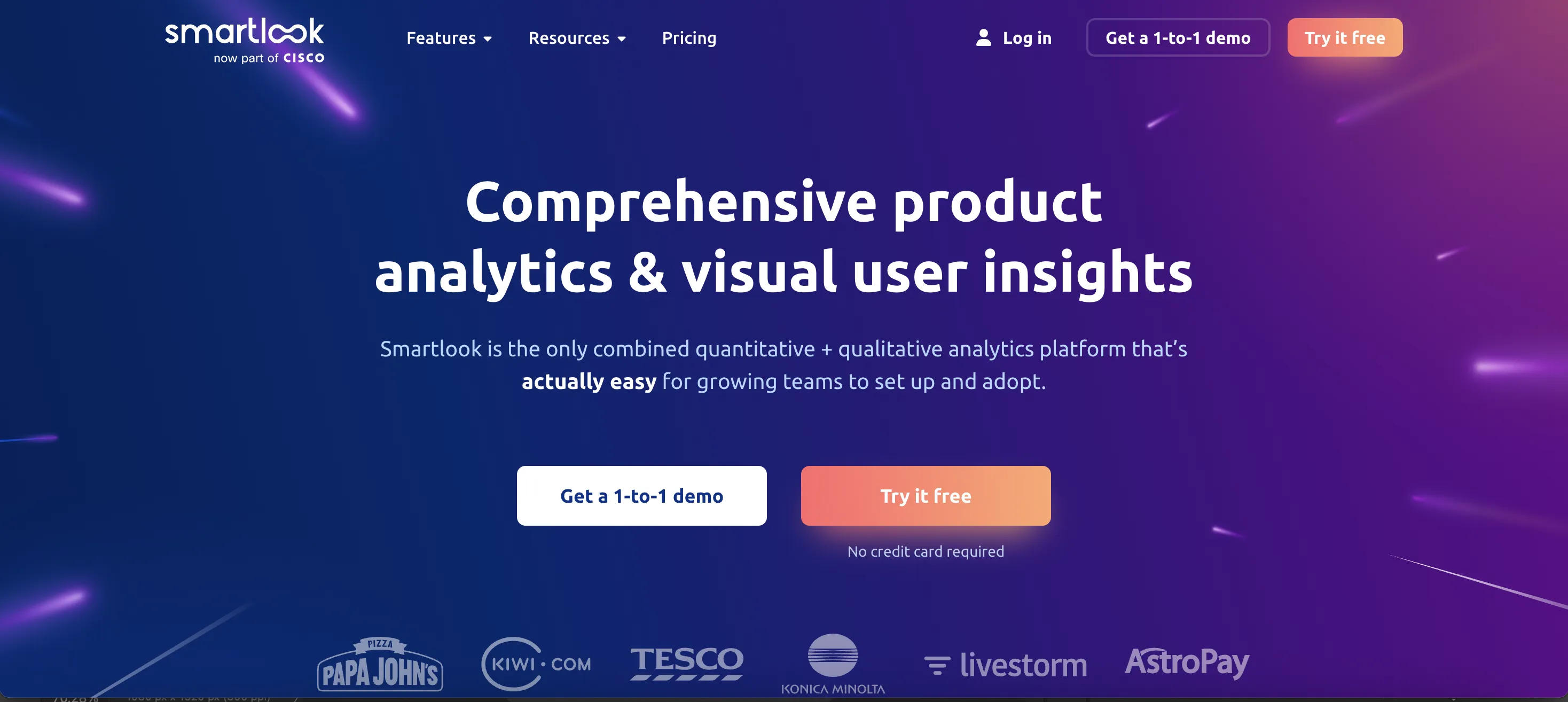
Smartlook combines session recordings, heatmaps, and funnel analysis, making it an essential partner tool for A/B testing.
After running an experiment, you can dive into Smartlook to see exactly how users interacted with each variant, whether they dropped off during checkout or struggled with navigation.
Its advantage lies in its product-level focus: it’s equally suited for web and mobile apps, making it ideal for D2C brands with both storefronts and companion apps.
Smartlook doesn’t just help you measure what users do, it helps you understand what they were trying to do.
Best for: Brands with both web and app presence who want unified behavioral insights to refine future experiments.
Smartlook is a powerful tool for understanding user behaviour through session recordings, heatmaps, funnel analysis, and event tracking. It helps you see what users are doing and where they may be struggling, but it stops at insights. CustomFit.ai focuses on what happens next. Instead of only diagnosing issues, it allows teams to immediately act on what they learn by running A/B tests, personalising content, adjusting layouts, and improving the live website experience without relying heavily on developers. If your goal is not just to watch user behaviour but to quickly implement changes that improve conversions and user experience, CustomFit.ai offers a more action-driven and practical solution than Smartlook.

Amplitude Experiment takes the analytical depth of Amplitude’s product insights and merges it seamlessly with A/B Testing. It allows teams to go from discovery to experimentation within the same ecosystem, making it easier to test hypotheses that arise from actual user behavior data.
For example, if analytics show that users drop off midway through checkout, Amplitude Experiment helps you run targeted tests to fix that exact issue. You can experiment with layout, messaging, or button placement and measure impact directly in the analytics dashboard.
For ecommerce or SaaS companies where every click translates to potential revenue, Amplitude’s tight integration between analytics and testing helps teams increase conversion rates faster, without juggling multiple tools.
Best for: Product-led growth teams that rely heavily on analytics and want to unify insights with A/B testing.
Amplitude Experiment is tailored for product and data teams who run feature-level tests across apps and digital products. It works best when you already operate with a strong data infrastructure, event taxonomy, and engineering support. Experiments typically rely on backend setups, developer involvement, and deeper analytics pipelines, which can slow down marketing-led or eCommerce-focused optimisation. CustomFit.ai is built for a different kind of speed. It lets marketers and growth teams run website A/B tests, make visual changes, personalise experiences, and iterate quickly without depending on developers or heavy data setups. Instead of requiring complex event configurations or engineering cycles, CustomFit.ai turns ideas into live tests instantly through a visual editor. If your goal is to optimise your website, boost conversions, and personalise on-site journeys with minimal friction, CustomFit.ai offers a more accessible, faster, and more practical alternative than Amplitude Experiment.
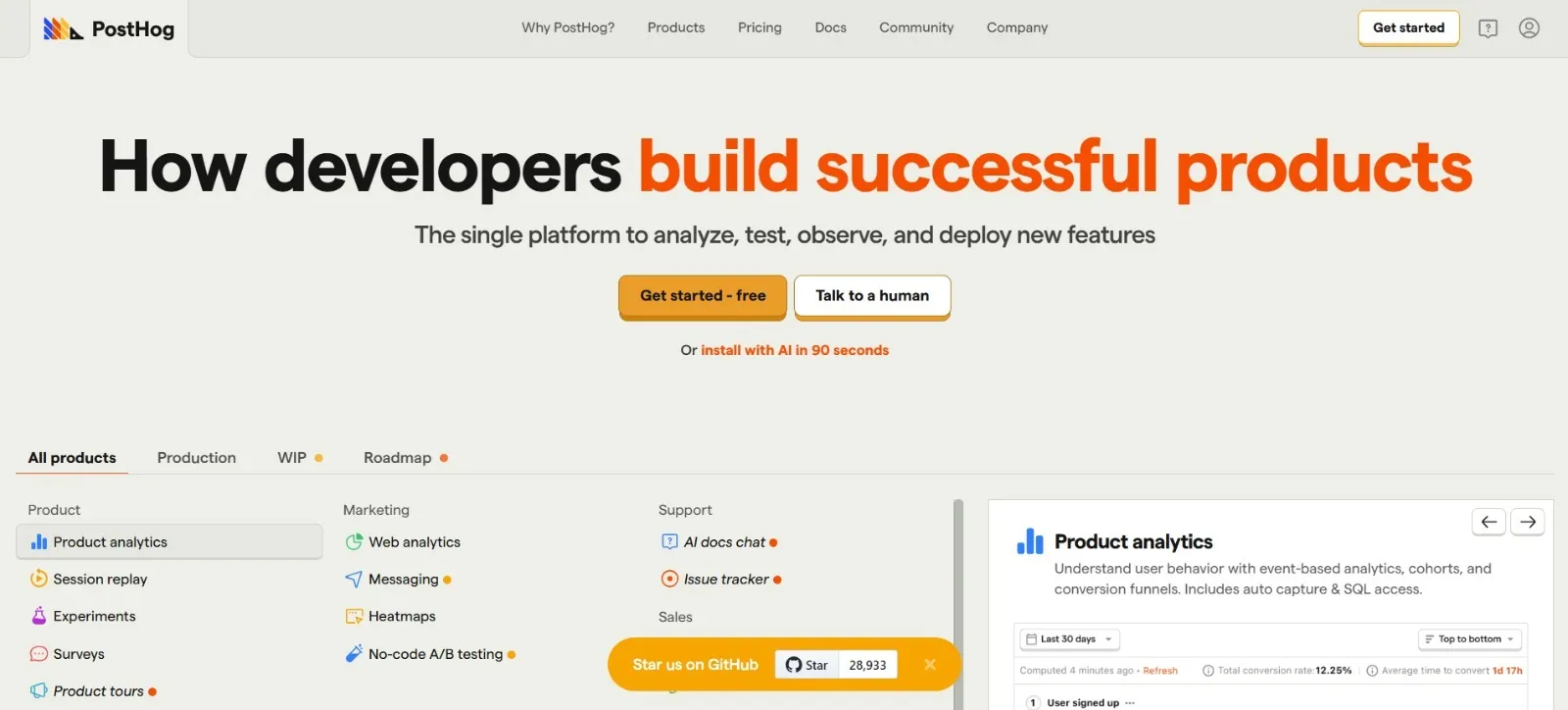
PostHog is an open-source A/B Testing Platform and analytics suite designed for teams that value transparency, control, and flexibility. It’s built for developers and product managers who want to self-host their data and fully customize their experimentation setup.
Unlike closed enterprise systems, PostHog lets you track every event, funnel, and session while simultaneously running A/B tests. The advantage is complete ownership of your data, a big deal for companies with strict privacy requirements or sensitive user information.
For ecommerce startups or D2C brands growing rapidly, PostHog offers a cost-effective way to test new product features, optimize conversion funnels, and keep experimentation tightly linked with behavioral analytics.
Best for: Teams that want open-source freedom, self-hosted analytics, and integrated experimentation without enterprise pricing.
PostHog is a powerful product analytics platform built for engineering and data teams, with strengths in event tracking, feature flags, and full-stack experimentation. It is ideal for product-led organisations that want deep analytics and developer-driven experimentation across apps and internal tools. However, this also means most experiments rely on engineering setup, backend configuration, and event-driven workflows, making it less suited for marketers or growth teams who need to move fast. CustomFit.ai focuses on website optimisation and gives marketers direct control through no-code visual editing, fast A/B testing, and real-time personalisation. Instead of depending on developers or managing complex analytics pipelines, teams can launch tests instantly, tweak layouts, personalise content, and improve conversions directly on the site. If your priority is rapid experimentation, hands-on control, and improving the user journey on your website without technical hurdles, CustomFit.ai offers a more accessible and action-oriented alternative to PostHog.
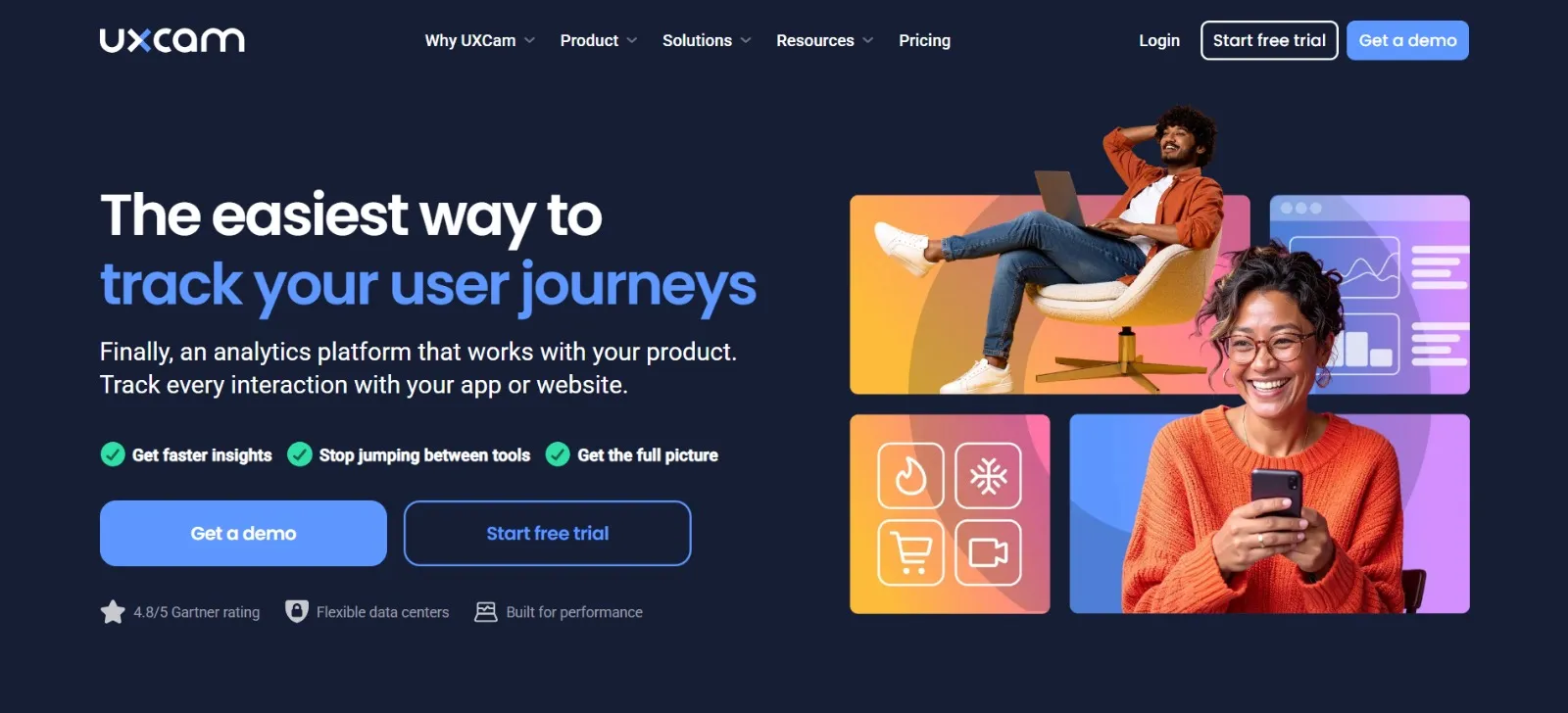
UXCam is not a traditional A/B Testing Platform, but it’s an essential partner tool for mobile experimentation. It records sessions, heatmaps, and gestures to show exactly how users interact with your app.
When paired with A/B testing, UXCam reveals the why behind your results, why one variation worked better than another, or where users faced friction in a flow.
For ecommerce apps, this is particularly valuable. You can observe how users browse products, add to cart, or abandon checkout, then use those insights to design targeted A/B tests that directly improve user experience and increase conversion rates.
Best for: Mobile teams that want to pair behavior analytics with A/B testing to understand and improve user experience.
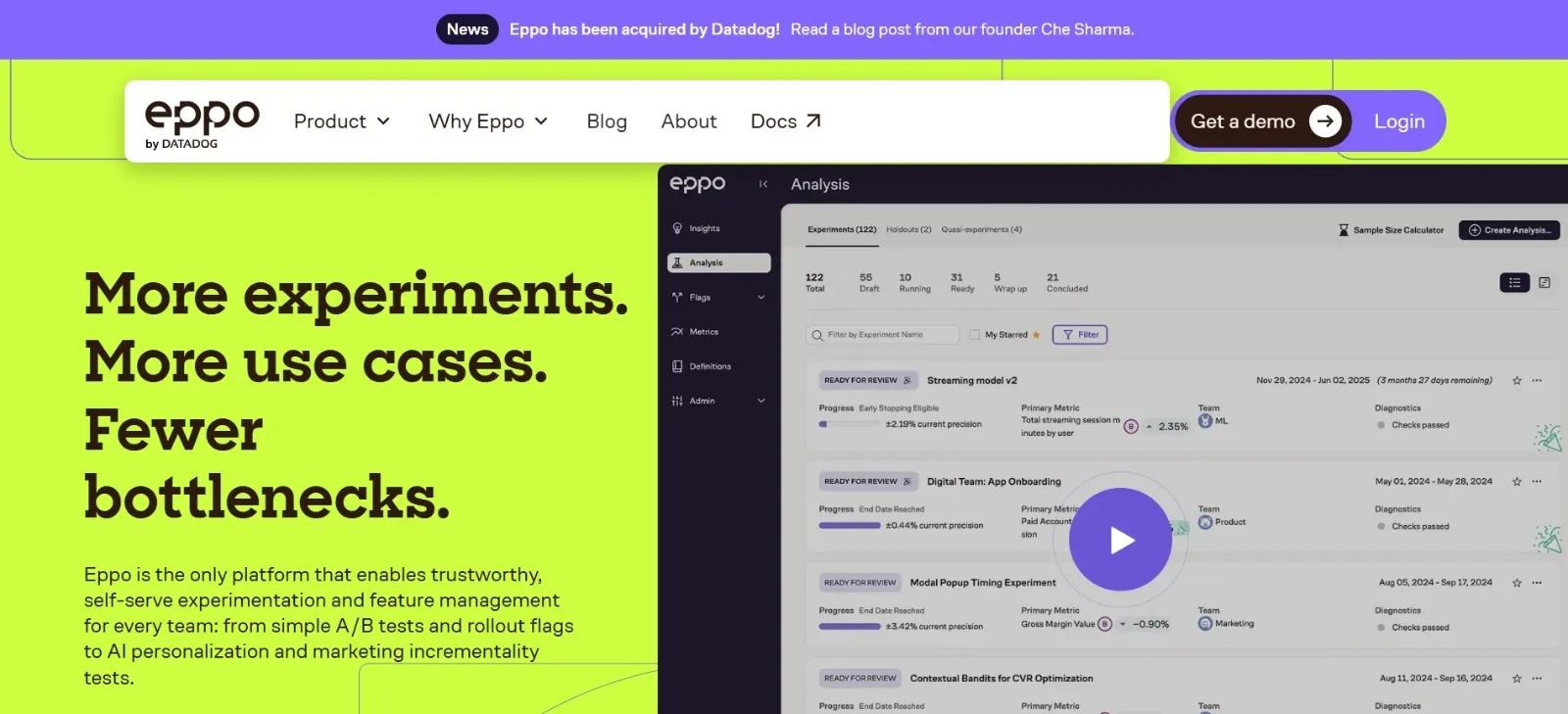
Eppo is a warehouse-native experimentation platform that brings A/B testing directly to your existing data stack. Instead of duplicating analytics, it connects to your data warehouse (like Snowflake, BigQuery, or Redshift) to run tests on the same trusted data source your team already uses.
This approach ensures statistical accuracy and unified reporting. For data-driven ecommerce teams, it eliminates guesswork by linking experiment results directly to revenue, conversions, and other core business metrics.
Eppo is especially useful for teams that already use BI tools or custom dashboards, it slots right into that workflow and adds powerful, statistically sound A/B testing on top.
Best for: Data-mature companies that want warehouse-integrated experimentation without rebuilding their analytics foundation.
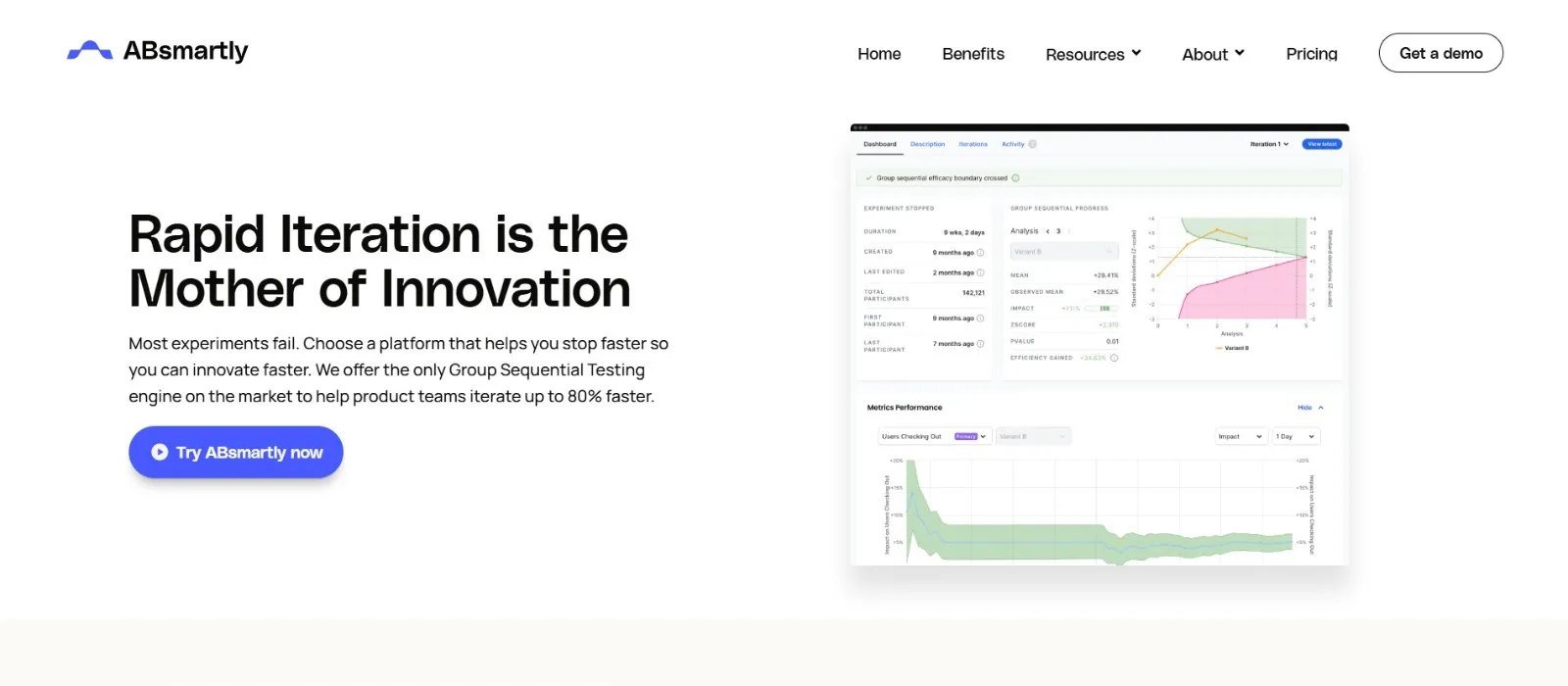
AB Smartly is built for organizations that view experimentation as a science. It offers full-stack A/B Testing, advanced statistical methodologies, and robust developer APIs, making it a top choice for engineering and product analytics teams.
Unlike simpler visual tools, AB Smartly supports experimentation across frontend, backend, and mobile layers, ensuring complete accuracy in test allocation and reporting. Its statistical engine ensures unbiased results even when running multiple experiments simultaneously.
For enterprise ecommerce or fintech products, where every small design change can affect millions in revenue, AB Smartly brings the discipline of science into digital experimentation.
Best for: Large data-driven teams who need rigorous, full-stack experimentation across channels.
Trying to validate copy or banners quickly before committing dev time? CustomFit.ai lets non-technical teams push controlled variants live and measure lift against conversions, not just clicks.
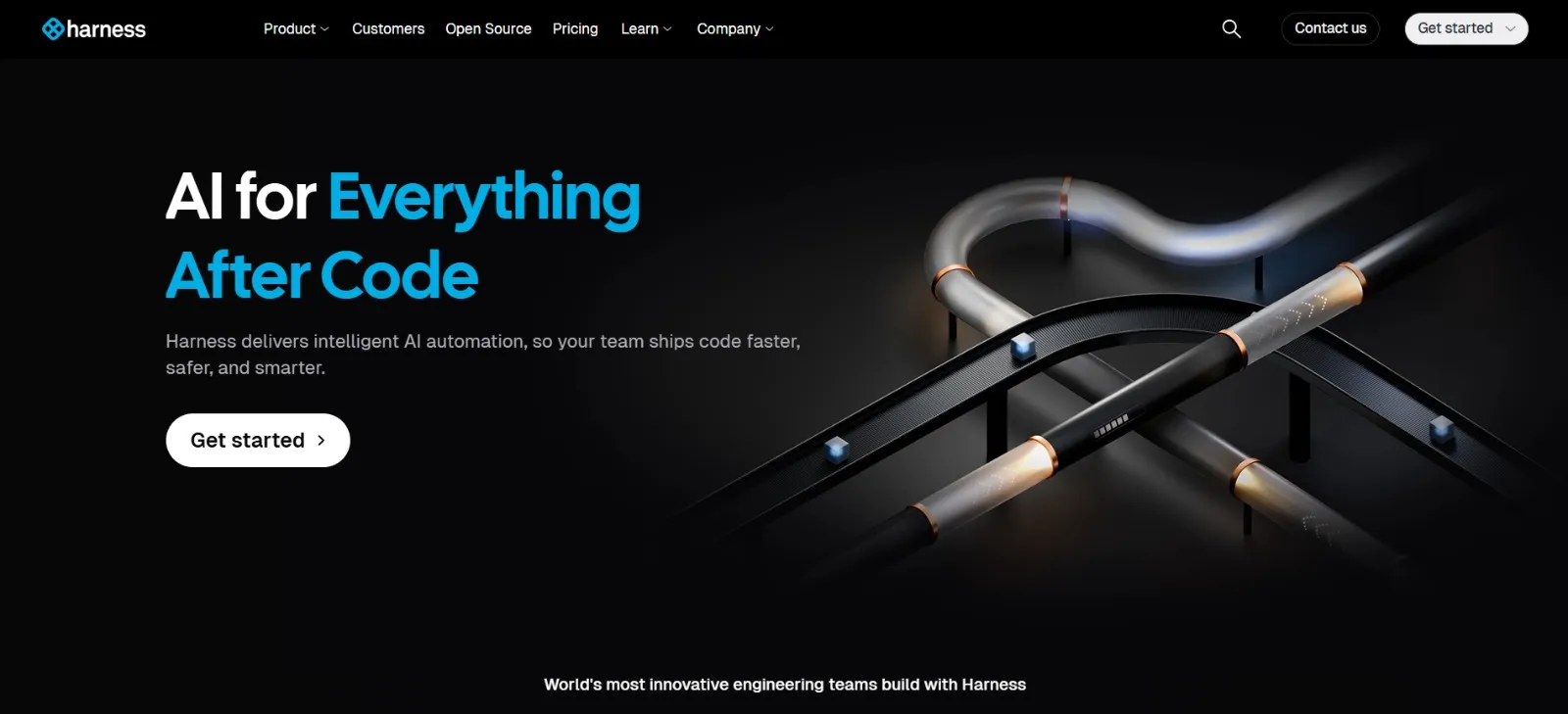
Harness.io extends its popular Continuous Delivery (CD) platform with built-in Feature Flags and A/B Testing capabilities, enabling DevOps and product teams to deploy, test, and iterate faster—all from the same workflow. It helps teams manage gradual rollouts, perform safe canary releases, and validate new features using live metrics without impacting overall system stability.
Harness’s key strength lies in automation: it uses machine learning to optimize deployments, detect anomalies, and even auto-rollback when performance thresholds are breached. With integrations across CI/CD pipelines, observability tools, and cloud providers, Harness offers a unified control plane for both experimentation and delivery.
For organizations that want to align feature experimentation with deployment velocity and operational safety, Harness provides an enterprise-grade solution that minimizes release risks while accelerating innovation.
Best for: Engineering-driven organizations and DevOps teams seeking an automated, all-in-one platform for feature flagging, experimentation, and continuous delivery.

Statsig is one of the most developer-friendly A/B Testing Platforms available today. It’s designed for engineering, data, and growth teams that want to connect experiments directly to product metrics, feature flags, and user events.
The platform automatically analyzes experiment results and shows statistically validated outcomes, so teams can make confident decisions without running complex manual calculations.
For ecommerce and SaaS products where hundreds of micro-changes happen every month, from new recommendation logic to UI updates, Statsig offers scale, accuracy, and integration with existing data tools.
Best for: Engineering-oriented teams that need experimentation built into their development lifecycle.
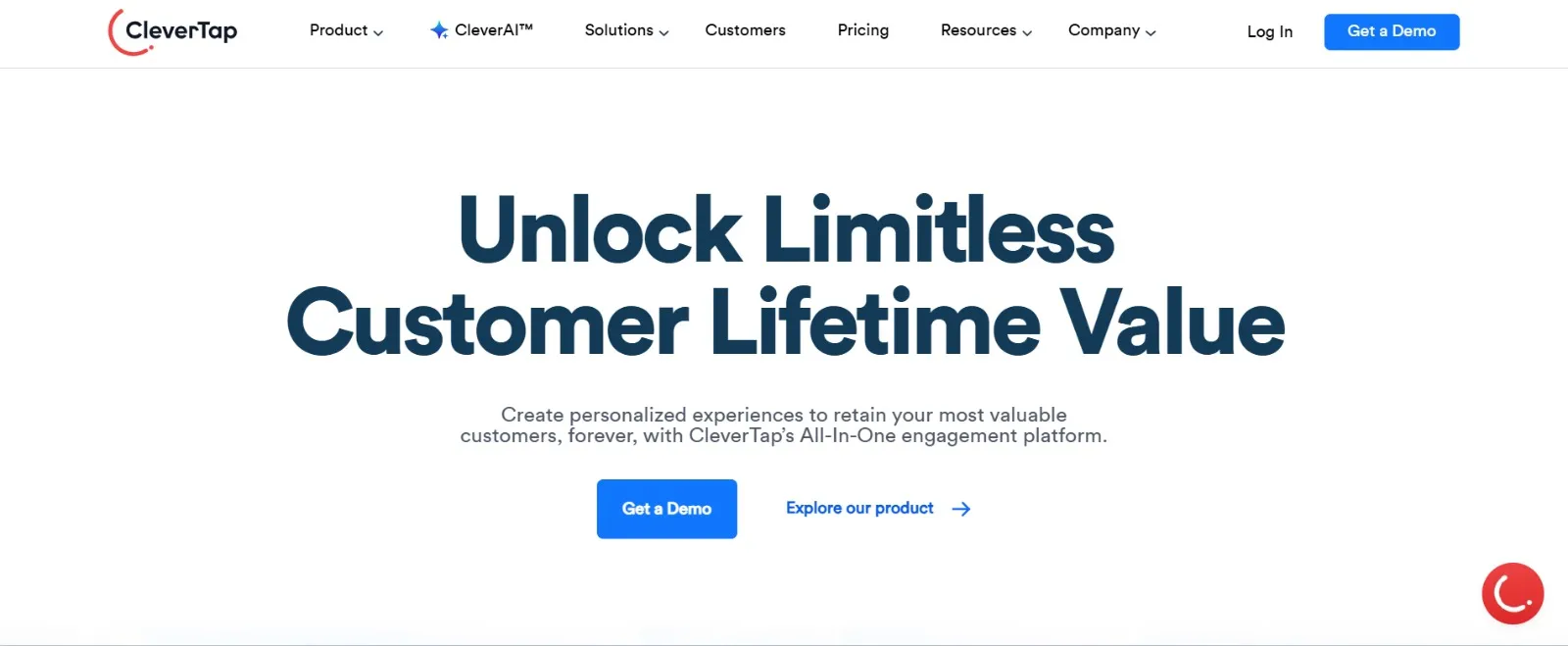
CleverTap is an advanced customer engagement and personalization platform that enables brands to deliver tailored user experiences across mobile and web in real time. Combining analytics, segmentation, and A/B testing, CleverTap helps marketers and product teams understand user behavior deeply and act on it instantly.
Its AI-driven personalization engine allows businesses to trigger contextual messages, push notifications, in-app experiences, and email campaigns based on user intent, location, or lifecycle stage. CleverTap also supports A/B and multivariate testing to help teams experiment with timing, content, and channel strategy—maximizing conversions and retention.
By unifying user data, real-time insights, and omnichannel delivery, CleverTap bridges the gap between analytics and execution. It’s especially powerful for brands with large user bases or complex user journeys, offering enterprise-grade scalability and automation.
Best for: Growth and marketing teams at mid-to-large consumer brands who want to personalize, test, and optimize every interaction across mobile, web, and omnichannel campaigns in real time.

Userpilot is a no-code product-growth and onboarding tool that lets SaaS and D2C platforms create in-app experiences and run A/B tests on them effortlessly.
Teams can test onboarding flows, tooltips, modals, or checklists to see which versions help users adopt features faster. The platform’s visual builder makes setup simple, and results are tied directly to engagement and activation metrics.
For ecommerce SaaS apps, where first-time user experience often determines long-term success, Userpilot helps find the right balance between simplicity and persuasion.
Best for: SaaS and ecommerce platforms that want to test and improve onboarding and feature adoption without coding.
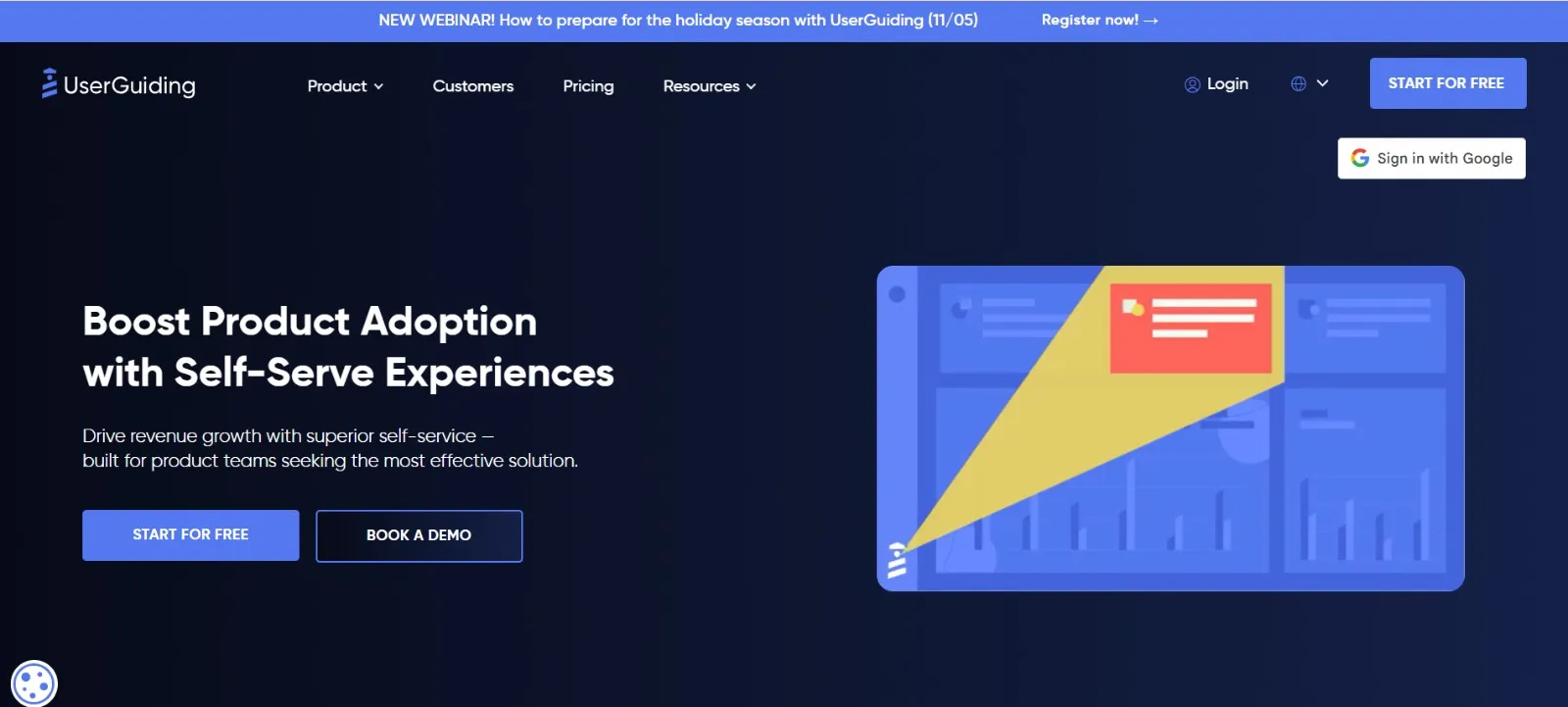
UserGuiding is a straightforward A/B Testing Platform for teams that want to improve UX and engagement through interactive guides, walkthroughs, and in-app messaging.
It’s especially useful for early-stage SaaS products and D2C platforms that are building user flows for the first time. Teams can test different versions of onboarding or tutorials and quickly identify which experience helps users convert or retain better.
Its ease of use and quick deployment make it a favorite for small marketing or product teams looking to implement experimentation without technical friction.
Best for: Teams focused on testing onboarding UX and driving engagement through guided experiences.
Flagr is an open-source feature flag and A/B testing service that provides developers with fine-grained control over rollouts and experiments.
It’s simple, self-hosted, and integrates easily with any tech stack, making it ideal for developers who value transparency and control.
Best for: Engineering teams that want self-hosted feature flagging and lightweight experimentation.
%201920%20x%201080%20px.webp)
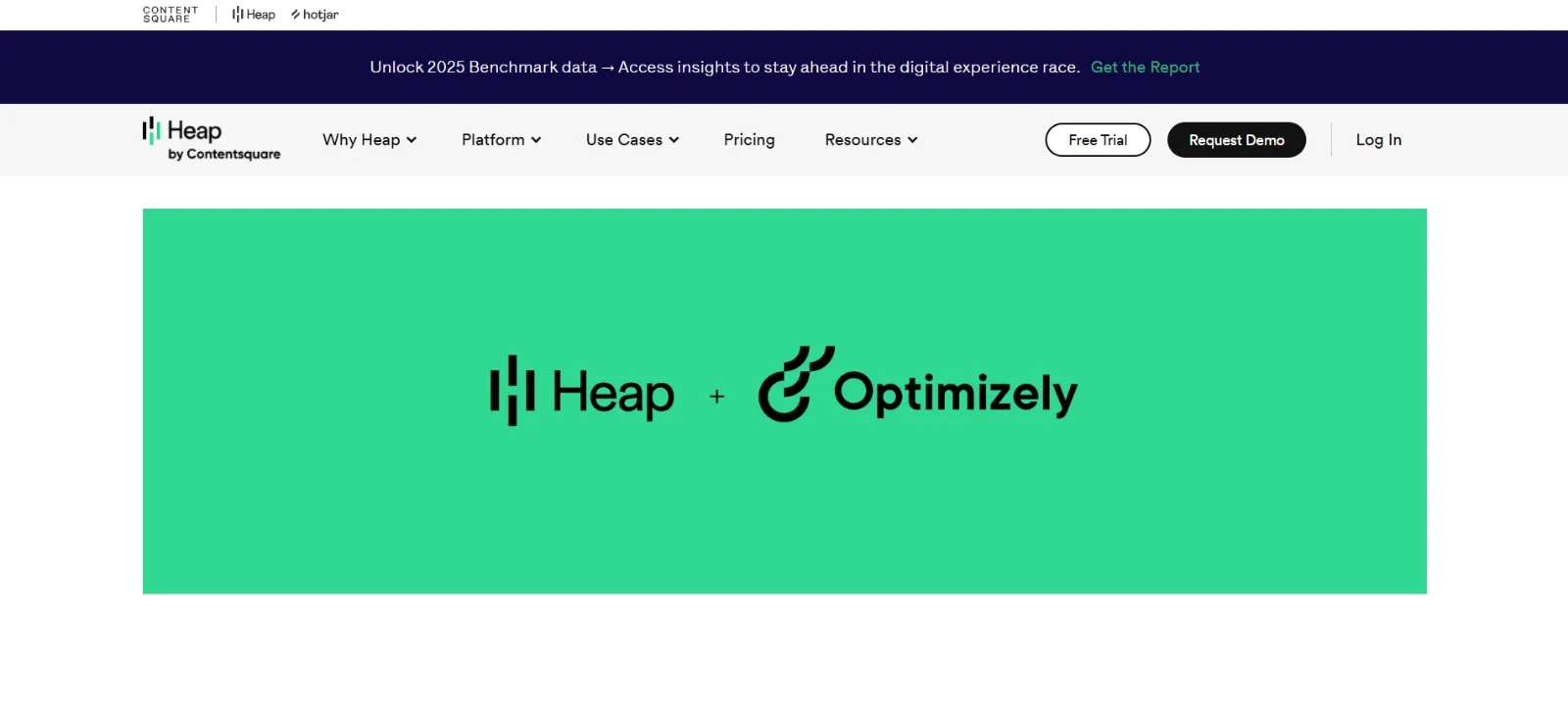
Heap is known for its event-driven analytics, automatically capturing every click, scroll, and interaction without manual tagging. Its experimentation module brings A/B testing capabilities directly into that environment.
This means teams can move from analysis to action instantly, identifying problem areas in a funnel and launching tests in the same platform. For ecommerce stores that want to increase conversion rates through a data-driven, continuous testing approach, Heap makes the workflow seamless.
Best for: Ecommerce teams that want automated data collection combined with built-in A/B testing.

Yieldify is a customer journey optimization platform that blends behavioral insights with personalization and A/B testing to improve onsite engagement and conversions. It helps ecommerce brands deliver tailored experiences by understanding visitor intent—whether they’re new users, cart abandoners, or returning customers.
Yieldify’s strength lies in its onsite messaging and smart triggers, allowing marketers to display personalized pop-ups, banners, and product recommendations based on real-time user behavior. The platform’s A/B testing tools make it easy to experiment with messaging, timing, and layout to see what drives higher conversions.
With detailed journey analytics and a visual campaign builder, Yieldify empowers marketing teams to run personalization campaigns without developer dependency—making it ideal for fast-moving ecommerce brands focused on optimizing checkout flows and reducing drop-offs.
Best for: Ecommerce and retail brands that want to combine behavioral insights, personalization, and A/B testing to deliver high-impact onsite experiences without heavy technical setup.

Kissmetrics has long been a favorite analytics tool for marketers. Its experimentation capabilities bring a conversion-focused edge to data tracking.
Teams can segment users based on behavior, traffic source, or campaign type, then test targeted experiences to see which audience responds best. For ecommerce and D2C brands, this integration between analytics and testing helps drive smarter marketing decisions, ensuring every experiment is tied directly to revenue outcomes.
Best for: Marketing and growth teams that want analytics and A/B testing under one roof.

FullStory isn’t just a testing tool; it’s a behavioral intelligence platform that helps you understand why test results happen.
It captures every interaction, clicks, scrolls, hesitations, and turns them into insights that reveal friction points in the customer journey. By pairing FullStory with an A/B Testing Platform, teams can not only see which variant won but also why it worked.
For ecommerce brands obsessed with refining user experience, FullStory acts as the lens that gives every test result a human story.
Best for: Ecommerce and product teams that want to pair analytics with qualitative understanding to drive continuous optimization.
For stores moving fast during campaigns, we’ve seen CustomFit.ai used to swap hero sections, run offer messaging tests, and gate rollouts by traffic source, all without a deployment.
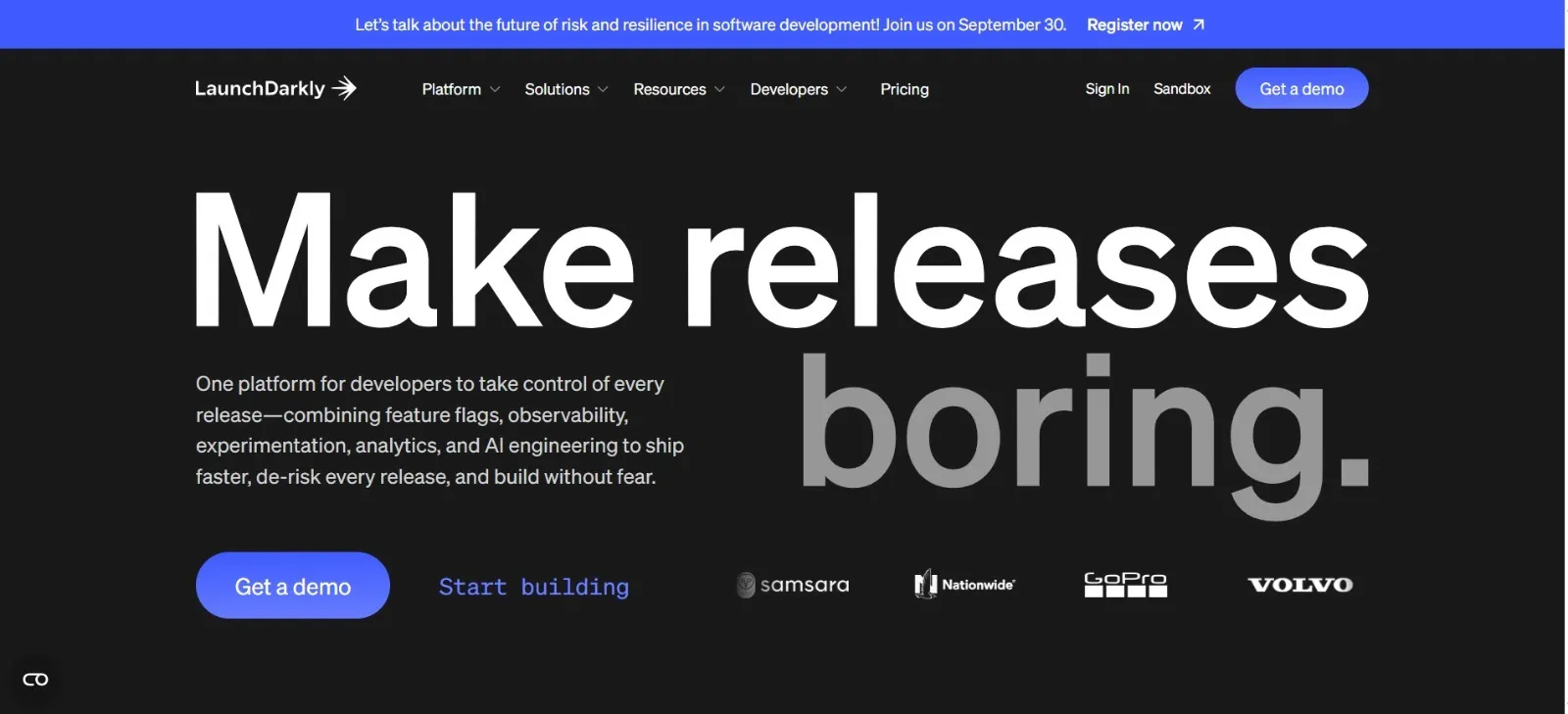
LaunchDarkly is one of the pioneers of feature-flag-based experimentation, giving engineering and product teams precise control over how and when new features are deployed.
Instead of rolling out updates to everyone at once, teams can use LaunchDarkly to release features to a small test audience, run A/B tests, and measure performance in real time. This reduces the risk of bugs or customer friction while still driving data-backed decisions.
For large ecommerce companies or SaaS businesses that frequently update their platforms, LaunchDarkly ensures every new experience can be tested, tracked, and iterated safely.
Best for: Engineering and product teams that want to manage feature rollouts and experimentation without disrupting user experience.
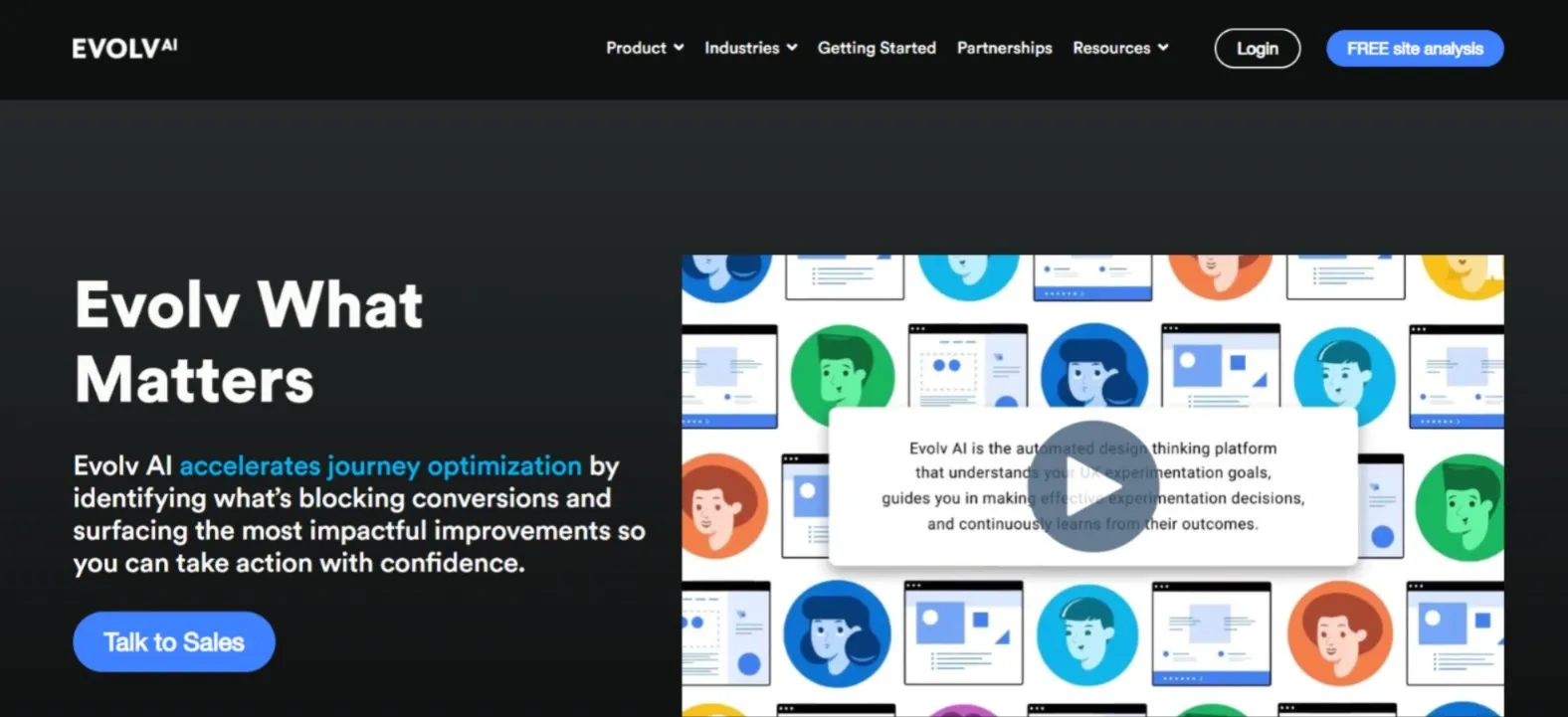
Evolv AI takes A/B Testing to the next level through evolutionary learning. Instead of testing two variants at a time, it continuously combines and evolves high-performing elements to find optimal experiences faster.
For large ecommerce stores, this means higher testing velocity and more intelligent personalization.
Best for: Growth-focused brands ready to move from static A/B tests to continuous optimization.
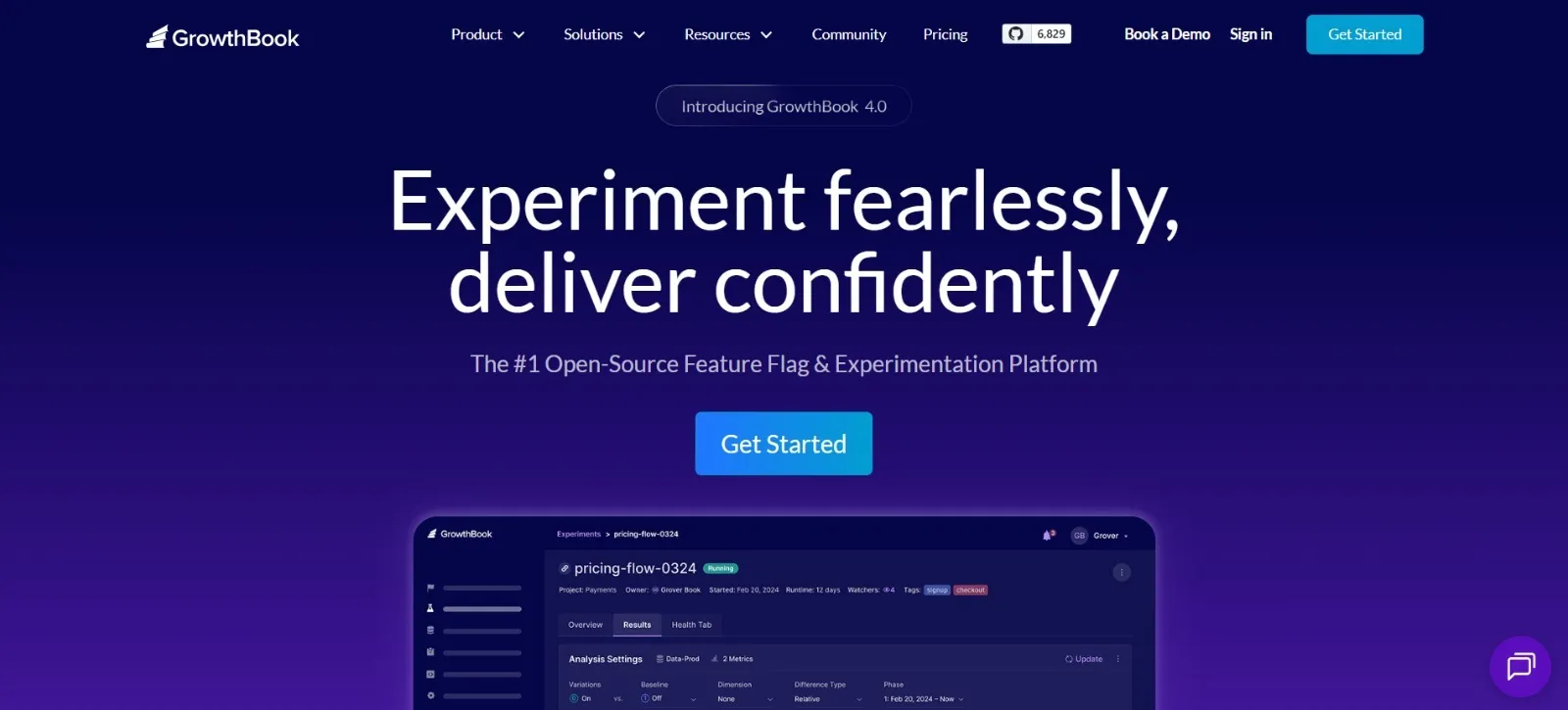
GrowthBook has quickly become one of the most popular open-source A/B Testing Platforms. It allows companies to self-host or use a cloud version to run experiments, manage feature flags, and integrate with their existing data pipelines.
Because it’s open-source, GrowthBook offers full transparency, flexibility, and cost control. It supports advanced statistical models and integrates easily with tools like Segment, Mixpanel, and Google Analytics.
For D2C and ecommerce brands that want ownership of their data and customization freedom, GrowthBook offers a powerful alternative to expensive enterprise testing tools.
Best for: Teams seeking open-source flexibility with full-stack experimentation and feature flagging.
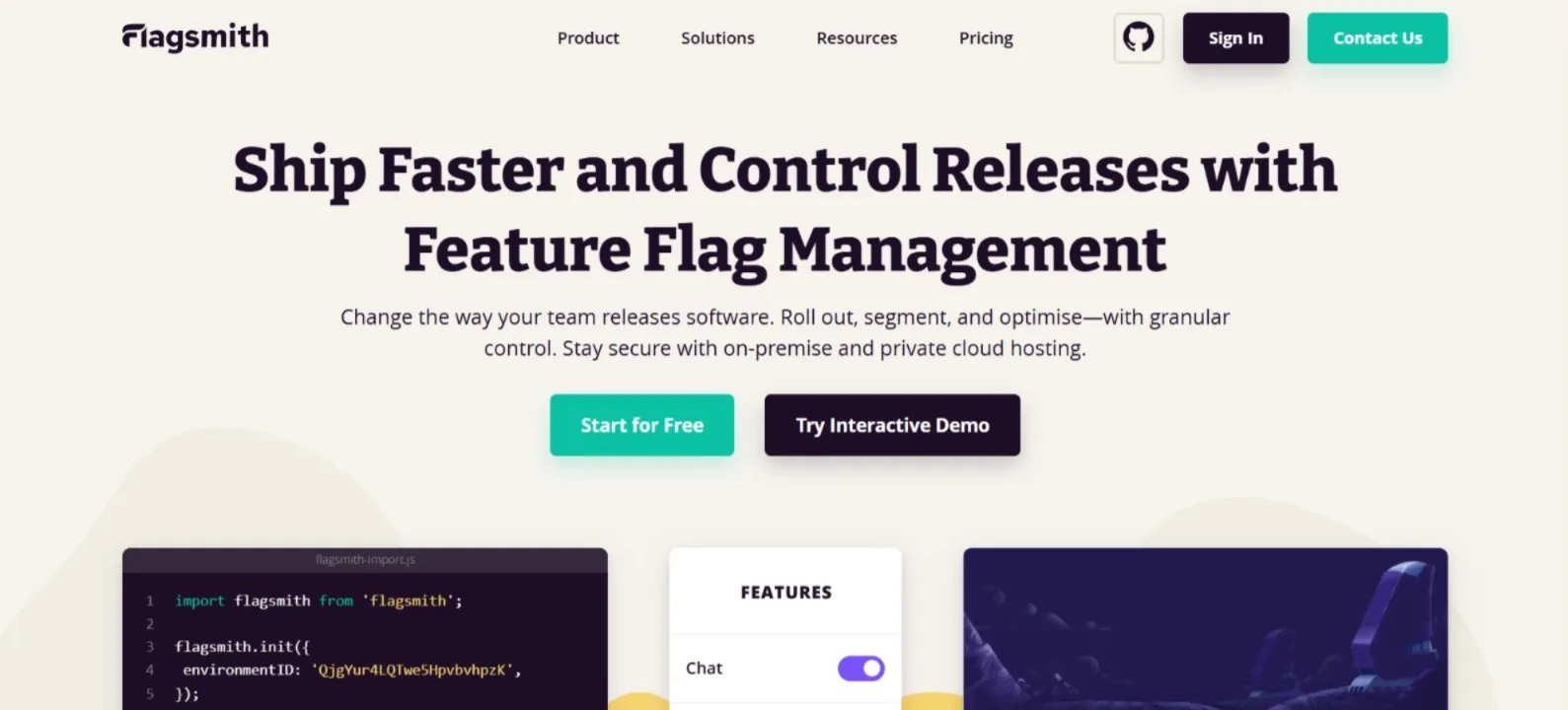
Flagsmith is another open-source feature-flag and A/B Testing Platform, designed for teams that need simplicity and control. It allows developers to toggle features on or off for specific users, while marketers and analysts can run experiments to see which variations drive engagement and conversions.
Its architecture supports both client-side and server-side integrations, making it equally suitable for web apps and backend systems.
For ecommerce brands building in-house experimentation frameworks, Flagsmith offers a lightweight yet reliable foundation that puts data ownership and privacy first.
Best for: Engineering and product teams that prefer open-source systems and want to manage experiments internally.

Unleash is one of the most trusted names in open-source feature flagging. It provides a self-hosted solution for organizations that want complete control over their infrastructure and customer data.
What makes Unleash stand out is its focus on privacy and flexibility. It supports strategies like gradual rollouts, A/B testing, and targeted releases without depending on external data processing.
For ecommerce companies operating in regulated environments or across multiple regions, Unleash ensures you can experiment safely without compromising user privacy or compliance.
Best for: Companies that require self-hosted, privacy-compliant feature-flag experimentation.
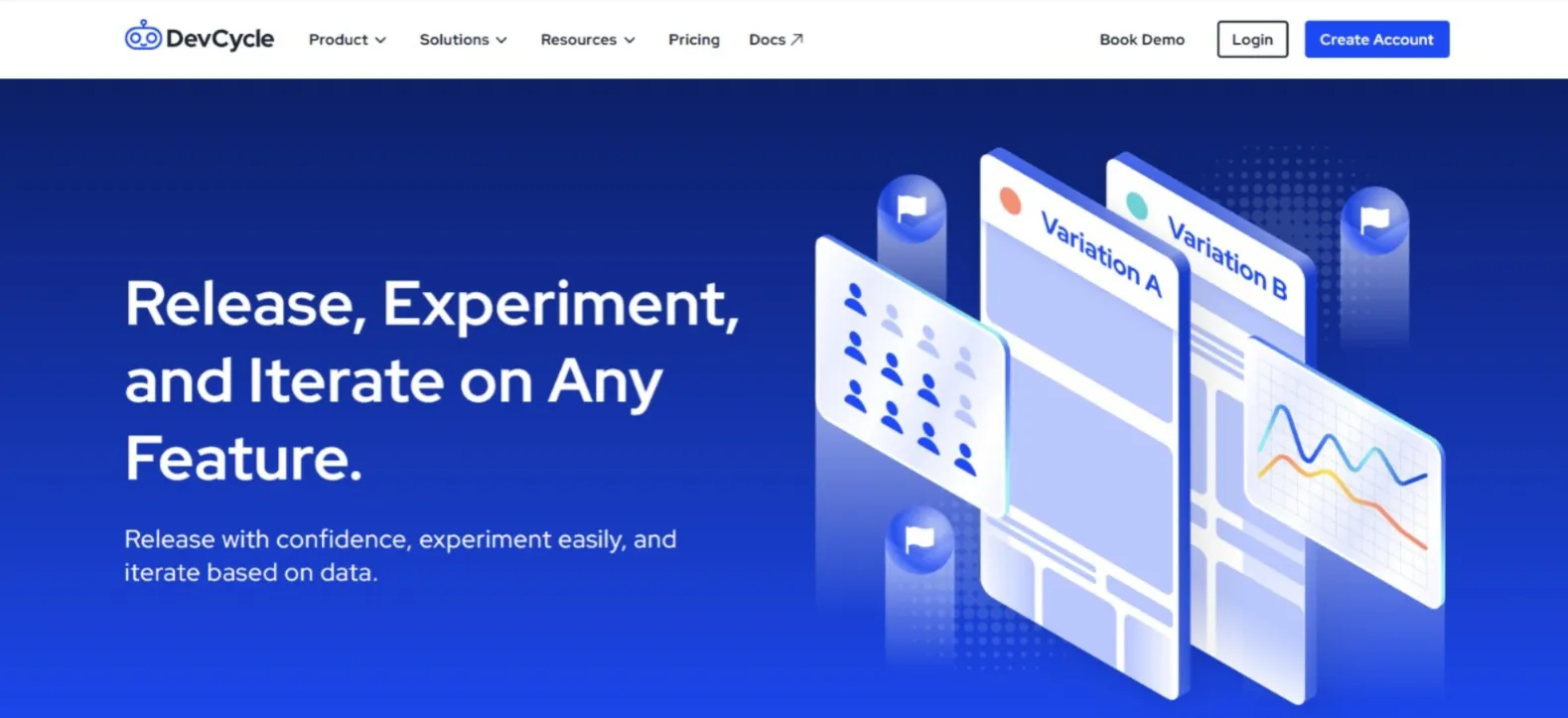
DevCycle brings experimentation closer to developers by simplifying how features are built, tested, and released. Its API-driven approach lets engineering teams integrate feature flags directly into their workflows and track experiment results with ease.
It’s particularly useful for large product teams managing multiple development environments or frequent release cycles. With DevCycle, they can run controlled A/B tests on new features without affecting the entire user base.
For D2C platforms and SaaS applications where user experience consistency is critical, DevCycle reduces release anxiety and encourages experimentation at the code level.
Best for: Developer teams who want to run experiments safely during product releases and rollouts.
.webp)
FeatBit is an open-source feature-flag and experimentation tool that focuses on real-time updates. It’s built for agility, teams can toggle, test, and measure features instantly, without redeploying code or interrupting services.
It supports traditional A/B testing as well as multivariate experiments, allowing engineering and marketing teams to collaborate more effectively. Its lightweight design makes it suitable for both startups and mid-sized companies looking to introduce experimentation early in their product journey.
Best for: Startups and mid-sized businesses that want open-source experimentation and instant feature control.
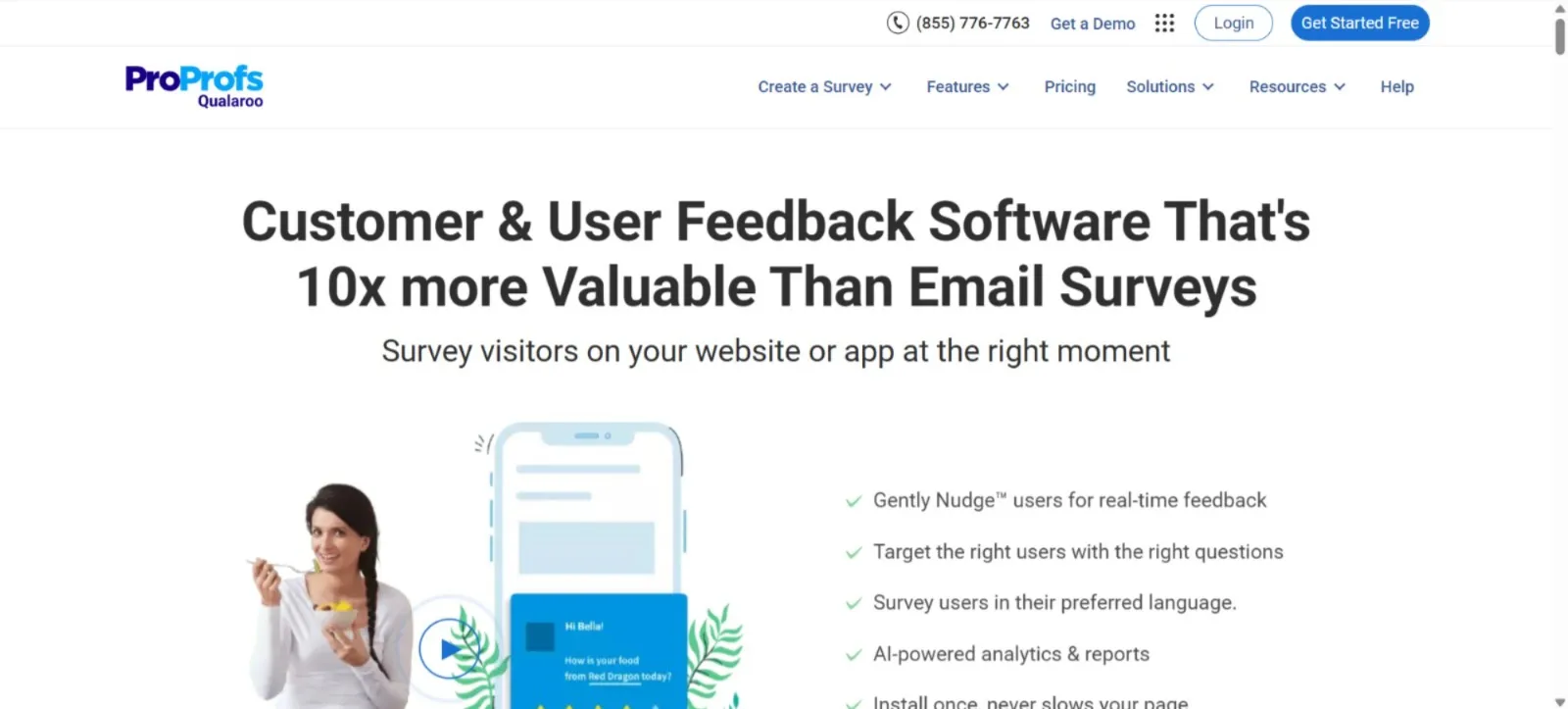
While most analytics tools focus on user actions, Qualaroo focuses on user feedback. It’s a survey and feedback tool that integrates beautifully into the A/B testing process, helping you capture real-time sentiment during or after a test.
For example, after launching two landing page variations, you can ask visitors, “Was this page helpful?” or “What stopped you from buying?” The answers reveal the emotional and cognitive side of performance data.
For ecommerce brands, pairing Qualaroo with a testing platform ensures every optimization isn’t just data-backed, it’s human-backed.
Best for: Teams that want qualitative feedback to complement quantitative test results and guide design decisions.
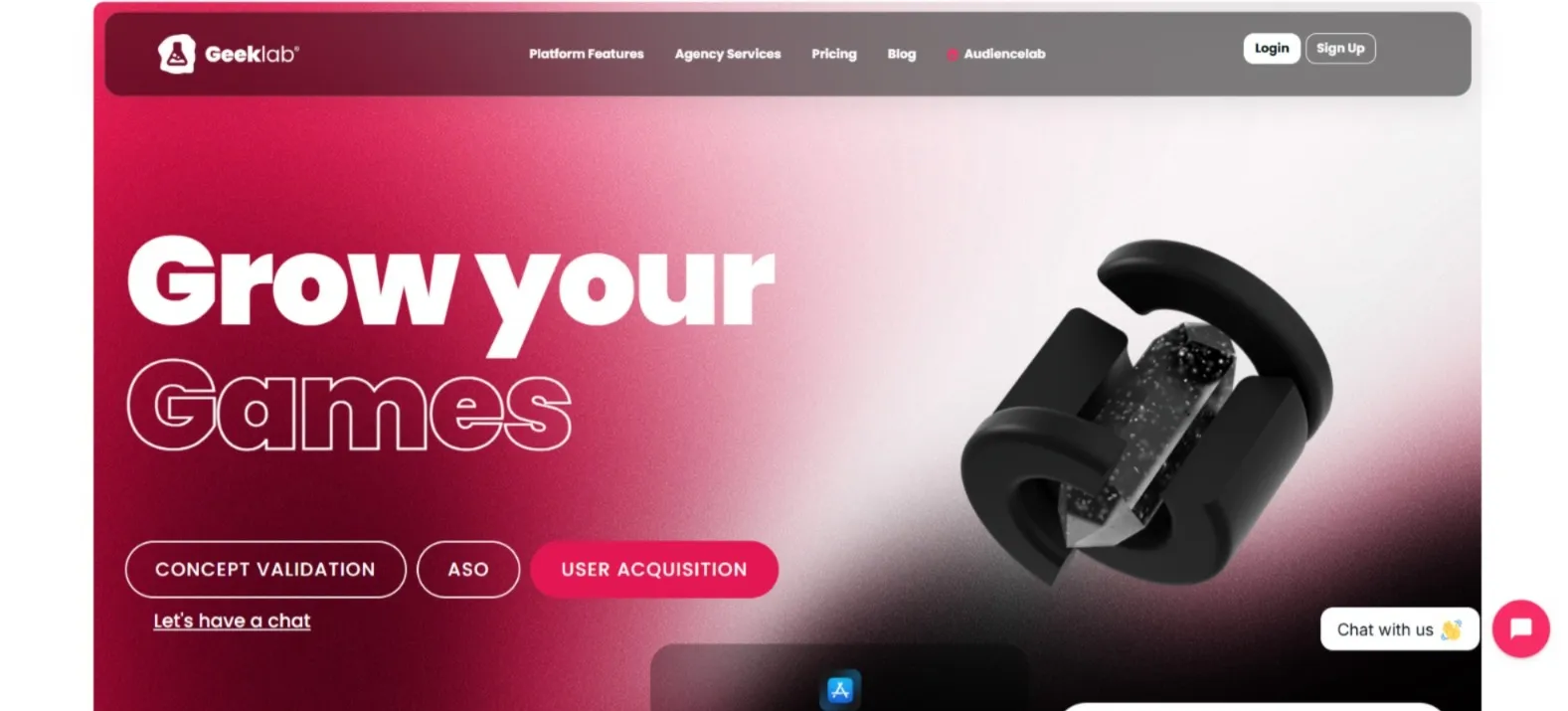
Geeklab offers a similar testing capability to SplitMetrics but adds flexibility for creative industries like gaming and entertainment. It allows A/B Testing of app store assets across platforms like iOS, Google Play, and even Steam.
Its visual-first design makes it easy for creative teams to experiment with artwork, icons, and trailers, no coding required. The insights reveal which combinations of creatives and messaging attract more installs or engagement.
For ecommerce or lifestyle apps, Geeklab can be just as effective. By testing visuals, brands can better understand what appeals to their audience before investing in ads or redesigns.
Best for: App developers, game studios, and ecommerce apps testing visuals and creatives for maximum app store impact.

Braze Feature Flags brings A/B testing into the world of customer engagement. Rather than testing website layouts, it allows marketers to experiment with in-app messages, push notifications, and personalized communication.
For example, an ecommerce app can test two different product recommendation messages and measure which one drives more clicks or purchases. This makes Braze’s approach to experimentation deeply integrated with retention and lifecycle marketing.
Best for: Ecommerce and app-based brands that want to A/B test messaging and communication within customer journeys.
If you’re a Shopify D2C team and want to launch tests without theme edits, CustomFit.ai lets marketers ship variants and behavior-based personalizations in minutes, with revenue-level reporting.
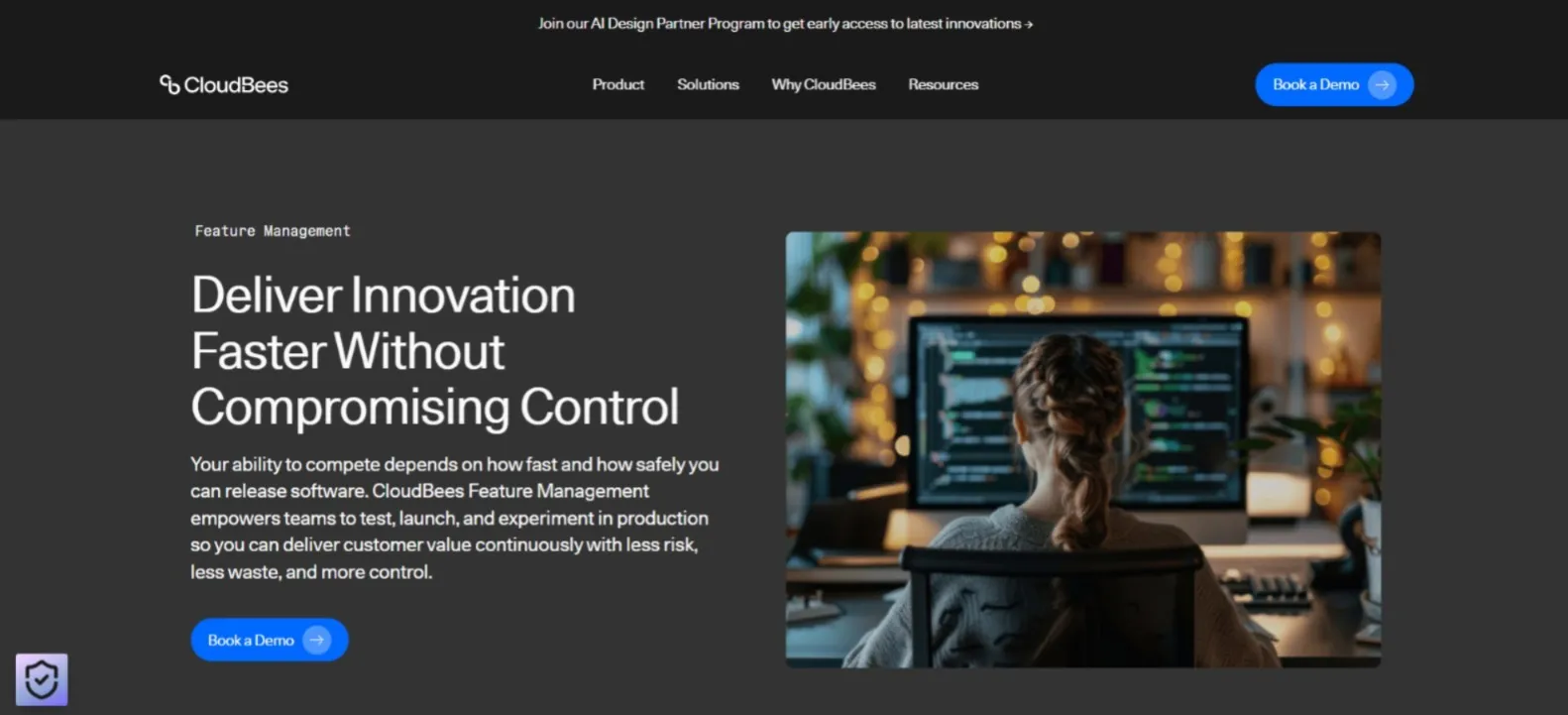
CloudBees Feature Management extends beyond traditional A/B testing to integrate with continuous integration and deployment workflows. It’s designed for large engineering organizations that release code daily and need complete control over feature exposure.
It supports feature flags, multivariate experiments, and custom rollout strategies, ensuring that every release is both tested and measurable. For ecommerce enterprises, this means you can experiment with pricing, recommendations, and UX flows while maintaining system stability.
Best for: Large-scale engineering teams and ecommerce enterprises that integrate testing directly into CI/CD pipelines.
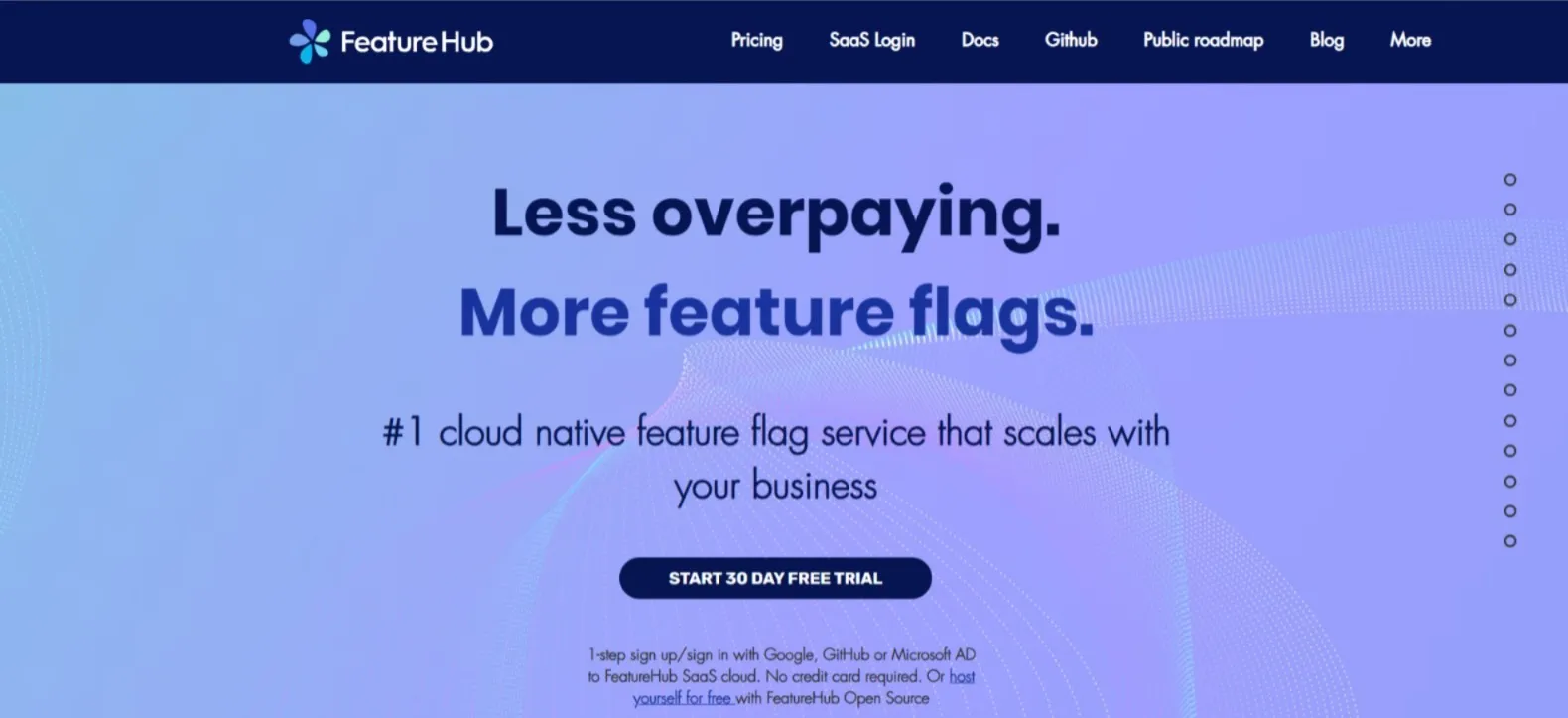
FeatureHub is a collaborative, open-source feature-flag and A/B Testing Platform that allows distributed teams to control feature rollouts and monitor performance in real time.
It supports multiple environments (development, staging, production) and provides granular control over who sees which features. Its open nature makes it ideal for teams that want transparency and the flexibility to extend functionality through APIs.
For growing ecommerce or SaaS startups, FeatureHub provides a cost-effective way to introduce experimentation and rollout management early in the development lifecycle.
Best for: Teams looking for collaborative, open-source experimentation and feature control.
Google Optimize 360 was the enterprise counterpart to Google Optimize, offering multivariate testing, advanced targeting, and audience integration via Google Marketing Suite.
It allowed large ecommerce and SaaS companies to run server-side and client-side experiments at scale. Though discontinued, its influence persists, many enterprise A/B Testing Platforms still follow its data-driven, cross-channel model. .discontinued on September 30, 2023, so it is no longer available for purchase or use.
Best for: Enterprise teams seeking a reference point for legacy Google experimentation workflows.
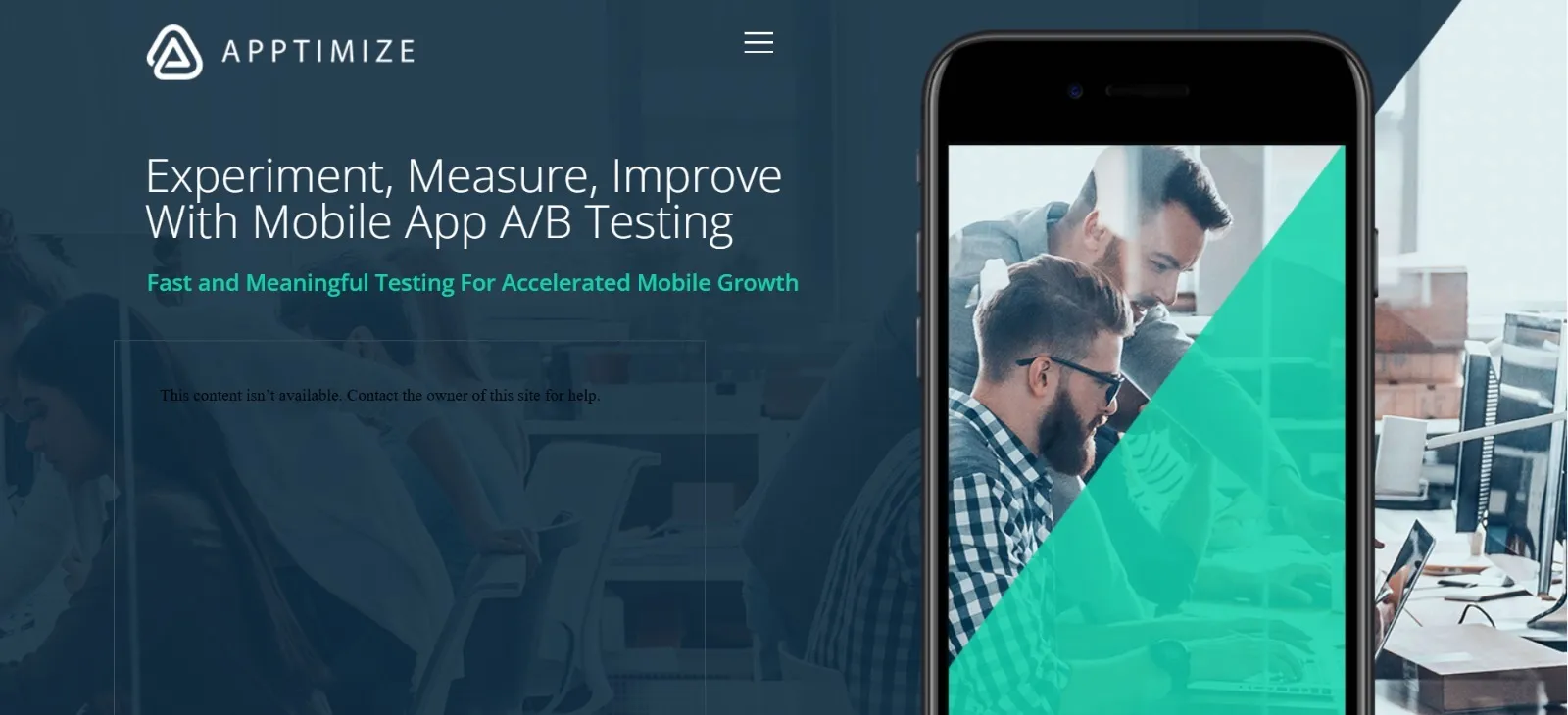
Apptimize is one of the most established names in mobile A/B Testing and feature experimentation. It helps teams test and release features across iOS, Android, and even web, giving full control over how updates are experienced by users.
Apptimize’s biggest advantage is cross-platform consistency. Teams can coordinate tests across app versions, ensuring that users have seamless experiences regardless of their device. For ecommerce apps, that means you can test a new checkout screen, product carousel, or notification design and instantly see which variation helps increase conversion rates.
It also integrates with analytics tools like Mixpanel and Amplitude, connecting test data directly to product performance metrics.
Best for: Ecommerce and D2C brands that want consistent, data-driven mobile A/B testing across iOS, Android, and web.

Firebase A/B Testing, part of Google’s Firebase platform, offers a powerful way to test app experiences at scale. It’s built for developers who want full control of how experiments are deployed through Firebase Remote Config, allowing tests on text, images, UI layouts, and even functional behavior within the app.
The advantage of Firebase is its native integration with Google’s ecosystem, Google Analytics for Firebase, Crashlytics, and BigQuery, giving teams an end-to-end view of how experiments affect user behavior, retention, and revenue.
For D2C mobile apps or ecommerce stores, Firebase A/B Testing provides a robust, scalable, and free foundation for running sophisticated tests, whether it’s optimizing onboarding steps or testing push notification timing.
Best for: App developers and ecommerce brands using Firebase who want free, scalable A/B testing tightly integrated with Google’s analytics.
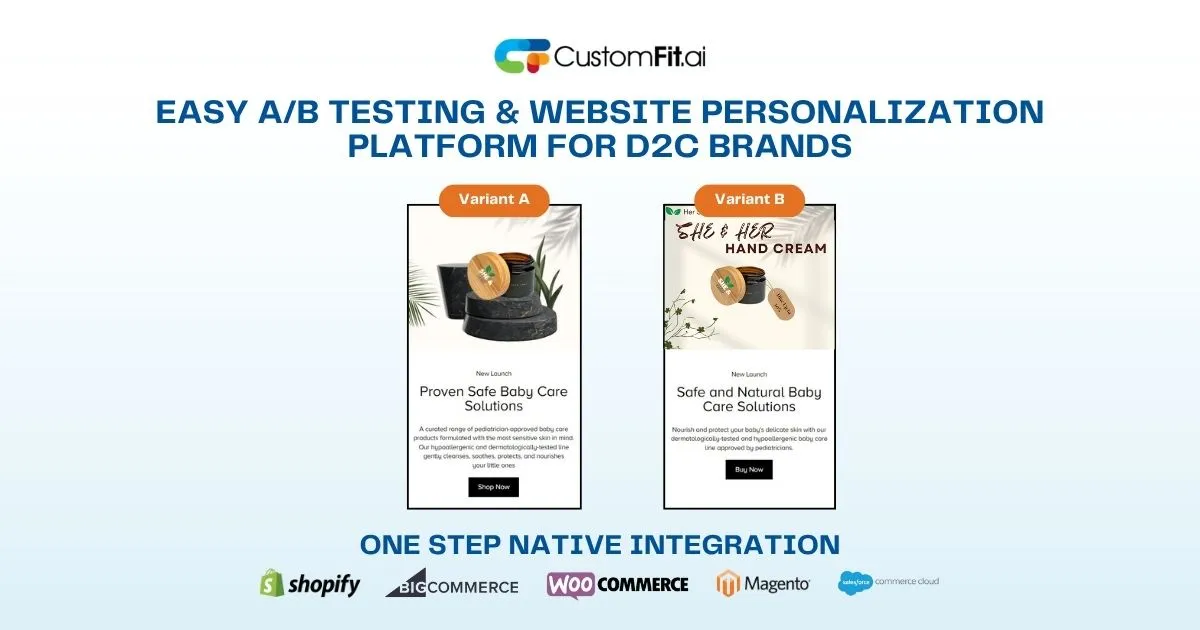
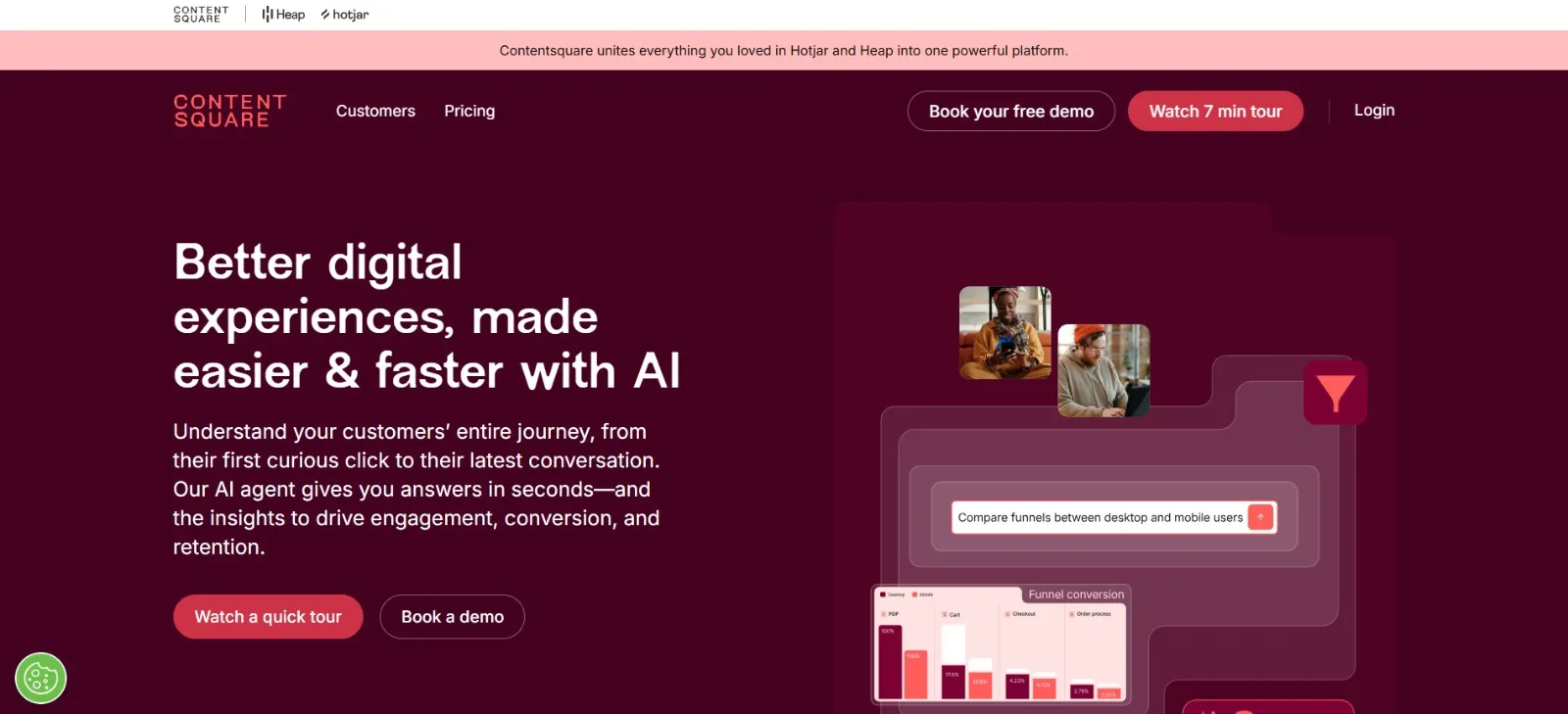
Contentsquare goes beyond analytics, it’s an experience intelligence platform designed for enterprise-scale brands. It helps teams combine quantitative and qualitative insights by analyzing every micro-interaction across web and mobile.
Used alongside A/B Testing Platforms like Optimizely or AB Tasty, Contentsquare provides context behind conversion drops or spikes. It segments audiences by behavior patterns, helping ecommerce teams refine personalization strategies.
For large retailers, it’s a way to transform data noise into meaningful stories, guiding where to test next and how to improve user experience holistically.
Best for: Enterprise ecommerce brands seeking deep, data-rich behavioral analysis to complement testing.

SplitMetrics focuses on a specific but highly impactful part of the mobile ecosystem, App Store A/B Testing. It lets app developers and marketers test app store elements such as icons, screenshots, videos, and descriptions to see what drives more downloads.
Before launching a campaign, brands can use SplitMetrics to create multiple page variants that simulate the App Store experience. Real users interact with these pages, and the platform measures which version achieves better conversion, whether that’s more installs, clicks, or engagement.
For ecommerce apps competing for visibility in crowded marketplaces like the Apple App Store or Google Play, even a small improvement in conversion rate can mean thousands of additional users.
Best for: App marketing and ecommerce teams that want to test and optimize app store listings for better user acquisition.

Dynamic Yield is one of the most advanced A/B Testing Platforms for retail personalization. It enables brands to create individualized shopping experiences by combining behavioral data, purchase history, and contextual signals.
With Dynamic Yield, retailers can test everything from homepage layouts to recommendation algorithms, all in real time. It blends A/B Testing with machine learning to ensure each shopper sees the content or product most relevant to them.
For ecommerce and D2C brands, this means optimizing not just clicks but intent, leading to higher average order value (AOV) and improved retention.
Best for: Mid-to-large ecommerce and retail brands looking for deep personalization combined with experimentation.

Monetate Commerce has long been a pioneer in retail A/B Testing and personalization. Now part of the same family as Dynamic Yield (under the Mastercard umbrella), Monetate remains a trusted solution for large-scale retailers that want to deliver relevant customer experiences at every touchpoint.
It allows teams to test layouts, recommendations, offers, and messages based on real-time shopper segments. The platform’s strength lies in its “decisioning engine”, it automatically adjusts which variation to show based on data performance, helping retailers adapt faster.
For D2C and omnichannel ecommerce stores, Monetate’s combination of testing, targeting, and personalization helps deliver experiences that increase conversion rates both online and offline.
Best for: Enterprise-level retailers seeking unified personalization and testing across web, mobile, and in-store.
.webp)
Shoplift is one of the most popular Shopify A/B Testing Apps built natively for merchants who want to optimize their store without writing code. It lets you duplicate theme templates, create variations, and test them directly within Shopify’s ecosystem.
You can run split tests on page layouts, product descriptions, pricing, or calls-to-action, and view performance metrics in an intuitive dashboard. Its “Lift Assist” feature even suggests tests based on store performance data.
For small to mid-size Shopify ecommerce stores, Shoplift is a practical, plug-and-play A/B testing solution that helps increase conversion rates without complexity.
Best for: Shopify merchants who want simple, theme-based A/B testing directly within their store setup.
Prefer a no-code workflow on Shopify? Try CustomFit.ai for rapid tests and behavior-based personalization.
.webp)
Chameleon helps SaaS and ecommerce platforms guide users through onboarding and feature discovery while running A/B tests on these experiences.
It’s particularly effective for improving activation and adoption rates in product-led environments.
Best for: SaaS and D2C apps optimizing user journeys through guided onboarding.
.webp)
Intelligems stands out as a specialized Shopify A/B Testing Platform designed for brands that want to go beyond surface-level design experiments. It focuses on price testing, allowing merchants to experiment with different product prices, shipping thresholds, or discounts to identify the most profitable combination.
Beyond pricing, Intelligems supports content and theme tests, enabling brands to optimize the entire storefront experience. It integrates tightly with Shopify, ensuring accurate revenue tracking and analytics.
For D2C brands and high-volume Shopify stores, Intelligems bridges the gap between creative experimentation and financial impact, proving which ideas truly improve margins.
Best for: Ecommerce brands on Shopify that want to experiment with pricing, offers, and content to maximize profits.
.webp)
Shogun Optimize is built for Shopify Plus and headless ecommerce brands that prioritize design flexibility. It extends the popular Shogun page builder with robust A/B testing features, allowing merchants to test variations of product, collection, and landing pages.
Its visual editor makes test creation simple, while performance data helps identify which design or layout drives higher conversions. For Shopify Plus brands using a headless architecture, Shogun Optimize integrates seamlessly with custom frontends.
This makes it ideal for fast-scaling D2C brands that want to combine creativity with measurable outcomes, every design decision backed by data.
Best for: Shopify Plus and headless ecommerce stores needing visual testing within custom-built experiences.
.webp)
Split.io is a comprehensive platform designed for teams aiming to optimize software delivery through agile feature management, experimentation, and robust analytics. Built for technology companies, SaaS, financial services, and ecommerce, Split.io empowers product and engineering teams to decouple feature releases from code deployments using advanced feature flags. This allows for controlled rollouts, instant rollbacks, and targeted experimentation with real user segments.
With Split.io, teams can run A/B and multivariate tests on any new product feature or experience, ingesting data from multiple sources (SDKs, APIs, platforms such as Segment and mParticle) to measure business impact, user engagement, and conversion rates. Its attribution engine automatically merges experiment results with feature flag data, delivering clear insights into which changes drive positive business outcomes. Split.io’s dashboard supports real-time monitoring and observability, allowing rapid detection and resolution of issues during progressive feature delivery.
The platform prioritizes data-driven decision making and enterprise-grade security, with instant detection of feature impact and local data processing to protect sensitive information. Split.io’s integrations enable easy connection with leading development, analytics, and communication stacks.
Best for: Product teams and engineering organizations in SaaS, technology, or ecommerce seeking an integrated toolkit for feature flag management, controlled rollouts, A/B/n experimentation, and advanced experimentation analytics.

Mutiny is a no-code platform for B2B marketers that personalizes website content using AI and audience data, enabling rapid creation of targeted experiences for key accounts. Marketers can build customized landing pages, microsites, and campaigns without coding, leveraging seamless integrations with CRM and analytics tools for data-driven segmentation and messaging. Real-time analytics let teams measure impact and iterate quickly, while robust compliance ensures data privacy.
Best for: B2B marketing teams seeking fast, scalable website personalization and targeted ABM campaigns, no developers needed.
.webp)
GrowthHero provides a simple platform for running marketing experiments across campaigns. It’s built for agility, enabling quick A/B tests of copy, visuals, and landing pages without the overhead of enterprise systems.
For startups or small ecommerce brands, it acts as a sandbox for creative experimentation.
Best for: Lean marketing teams looking for fast testing cycles without heavy data infrastructure.
.webp)
ConvertCart takes a broader approach to optimization by offering an entire conversion rate optimization (CRO) suite, which includes A/B Testing, analytics, personalization, and cart recovery.
It’s built specifically for ecommerce, providing insights into how shoppers behave at every funnel stage, from product discovery to checkout. Teams can test page elements, offers, navigation flows, or even checkout sequences, all while tracking their effect on sales.
ConvertCart also provides guided suggestions based on past results, helping brands continuously improve site performance. For growing D2C brands, it’s like having an embedded optimization team.
Best for: Ecommerce and D2C stores seeking an all-in-one testing, analytics, and CRO toolkit.
.webp)
Nosto combines A/B Testing, segmentation, and personalization into one ecommerce-focused platform. It analyzes browsing and purchase behavior in real time to deliver dynamic product recommendations, targeted popups, and customized content.
Brands can run A/B tests on recommendation layouts, content placements, or promotional strategies, all aimed at maximizing conversion and engagement.
For Shopify, Magento, and BigCommerce stores, Nosto plugs in easily and gives retailers a continuous feedback loop on what truly drives shoppers to buy.
Best for: Ecommerce brands that want personalization-driven A/B testing to improve product discovery and conversion rates.
.webp)
Freshworks Experiments, part of the Freshworks ecosystem, offers a lesser-known but capable A/B Testing Platform aimed at ecommerce and SaaS companies. It supports website and app-based experiments for optimizing layouts, pricing strategies, and call-to-action effectiveness.
While not as robust as tools like Dynamic Yield or Monetate, it integrates seamlessly with Freshmarketer and Freshsales, giving marketing and product teams shared access to data and outcomes.
For small ecommerce businesses looking for an entry-level A/B testing tool within an existing marketing stack, Freshworks Experiments is a practical option.
Best for: Smaller ecommerce stores that use Freshworks tools and want to add testing functionality without additional software.
.webp)
Hotjar bridges the gap between analytics and empathy. While tools like Google Analytics show you where users go, Hotjar reveals how they behave through heatmaps, session recordings, and surveys.
After running an A/B test, you can use Hotjar to replay how users interacted with each variation, where they clicked, scrolled, or got stuck. For ecommerce stores, it’s the easiest way to uncover friction points in the buying journey and validate which design or content change truly made an impact.
Hotjar’s visual insights make optimization intuitive. It transforms abstract test data into actionable understanding, so every future A/B test becomes smarter.
Best for: Ecommerce and D2C teams that want to visualize post-test behavior and understand user psychology.
Great experimentation platforms don’t replace judgment; they refine it. Start with the tool that matches your team’s reality, how you ship, who runs tests, and what you can measure reliably. Keep cycles short, define success in revenue terms, and let learning stack week over week. If you’re a D2C team that needs no-code velocity on Shopify, CustomFit.ai is a practical place to start, ship the test now, harden the winner later.

Before “CRO” was a common term, Crazy Egg was helping marketers understand website performance visually. It offers heatmaps, click-tracking, and scroll-maps, alongside a lightweight A/B Testing feature that lets teams make quick changes and see instant results.
For ecommerce websites, Crazy Egg makes it easy to test page headlines, button placements, or product layouts and see how each variant affects engagement.
Its simplicity and fast insights make it ideal for small marketing teams, especially those who want to combine visual analytics with quick A/B experiments without heavy setup.
Best for: Small to mid-sized ecommerce teams that value fast, visual testing and optimization.
.webp)
Microsoft Clarity offers enterprise-grade session recording and heatmap analytics, completely free. It’s a growing favorite among D2C and ecommerce marketers who want behavior insights without additional costs.
You can use Clarity alongside any A/B Testing Platform to validate test results, observing how users engage with winning and losing variants in real time.
Its standout feature is the “Rage Click” and “Dead Click” detection, which reveals areas of user frustration, helping brands spot UX problems that metrics alone can’t show.
Best for: Teams running A/B tests that want a free, privacy-friendly behavioral analytics companion to understand user actions.
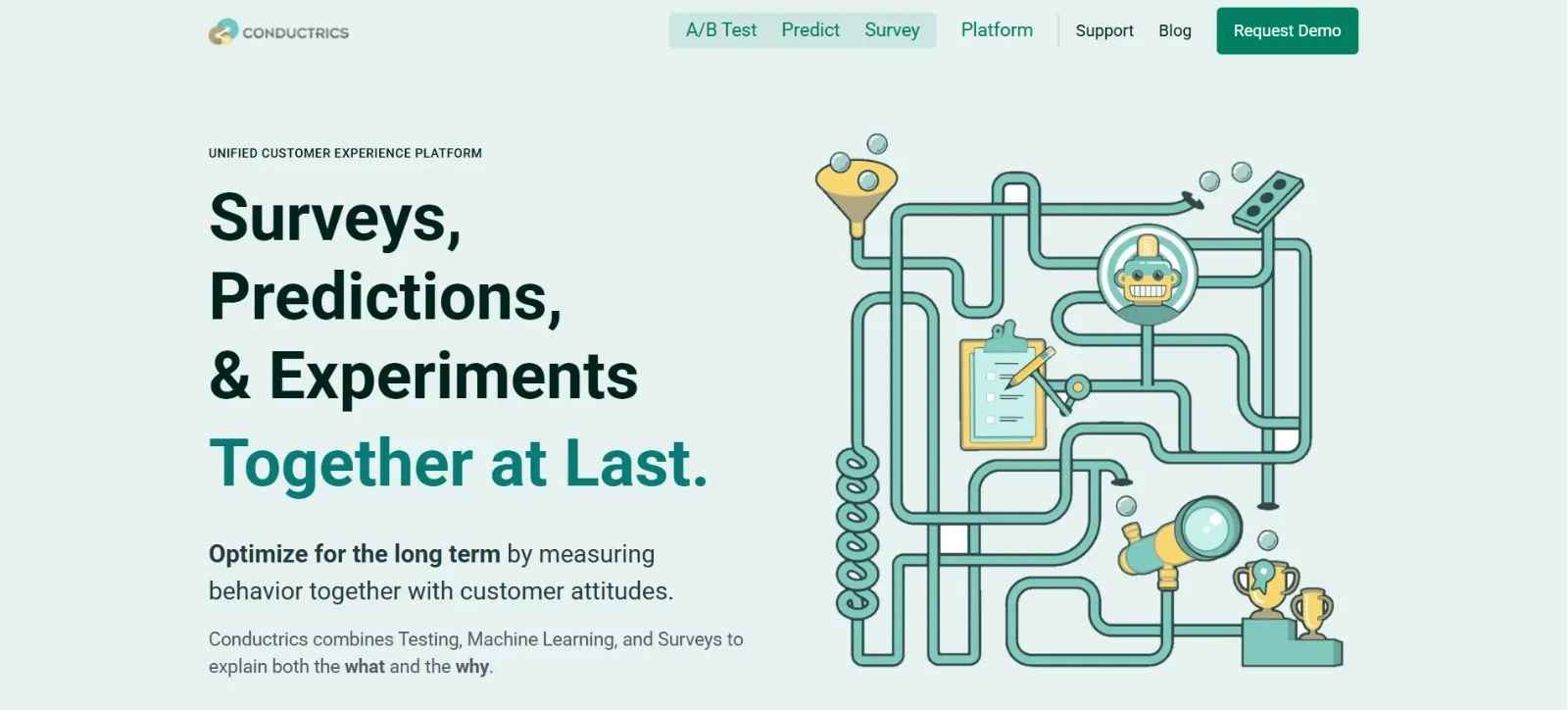
Conductrics is a hybrid experimentation and decisioning platform that combines A/B testing, machine learning, and rules-based personalization to optimize digital experiences in real time. Unlike traditional A/B testing tools that focus on static experiments, Conductrics dynamically learns which variations perform best for different audience segments and automatically adjusts delivery to maximize results.
Its AI-driven engine evaluates user context—like device type, referral source, time of day, or past behavior—to decide the best experience for each visitor. This adaptive testing approach helps teams move beyond fixed control/variant setups and into intelligent optimization that continuously improves with more data.
Conductrics also integrates seamlessly with analytics and marketing platforms, giving product and marketing teams full control over test logic, targeting, and success metrics without needing heavy developer support.
Best for: Enterprises and data-driven organizations that want to blend A/B testing with machine learning–based personalization to deliver optimal user experiences automatically across complex digital journeys.
.webp)
Symplify (formerly SiteGainer) is a comprehensive conversion optimization platform combining A/B testing, personalization, heatmaps, and surveys in one solution. It helps marketers and growth teams understand visitor behavior, test variations, and deliver tailored onsite experiences without complex setup.
With tools for multivariate testing, behavior-based targeting, and real-time analytics, Symplify makes it easy to identify conversion barriers and continuously improve performance across web and mobile. Its visual editor and unified dashboard simplify experimentation, personalization, and customer feedback collection.
Best for: Ecommerce and D2C brands seeking a single platform to test, personalize, and optimize user journeys with actionable behavioral insights.
.webp)
Mixpanel has long been one of the most popular product analytics tools, and now, it’s also an A/B Testing Platform. Its strength lies in tracking user events at a granular level, letting you measure not just page visits but every click, scroll, or interaction.
When combined with experimentation, this approach gives teams a 360-degree view of how each variation impacts engagement and conversion. You can test a new checkout design, an onboarding flow, or pricing model, and instantly connect results with retention and lifetime value.
For ecommerce businesses, Mixpanel helps translate behavior patterns into actionable tests, closing the gap between observation and optimization.
Best for: Ecommerce and SaaS teams focused on deep behavior analytics and event-based experimentation.

Adobe Journey Optimizer Tests extend A/B Testing beyond the website, into email, push notifications, and personalized journeys.
For enterprise ecommerce brands, this enables true omnichannel optimization, ensuring consistent experiences across every customer touchpoint.
Best for: Large enterprises optimizing multi-channel customer journeys.

Tggl is a lightweight platform for feature flagging, release management, and A/B testing, designed to help product and engineering teams ship faster and safer. It lets developers deploy code early and product teams control releases, test variations, and track KPIs—all without extra dev cycles.
With progressive rollouts, instant rollbacks, and built-in experimentation, Tggl simplifies testing in production while maintaining full control and visibility. GDPR compliance, EU data storage, and audit logs ensure enterprise-grade security and governance.
Best for: SaaS, fintech, and mobile teams seeking a secure, collaborative way to manage releases, run experiments, and improve product metrics in real time.
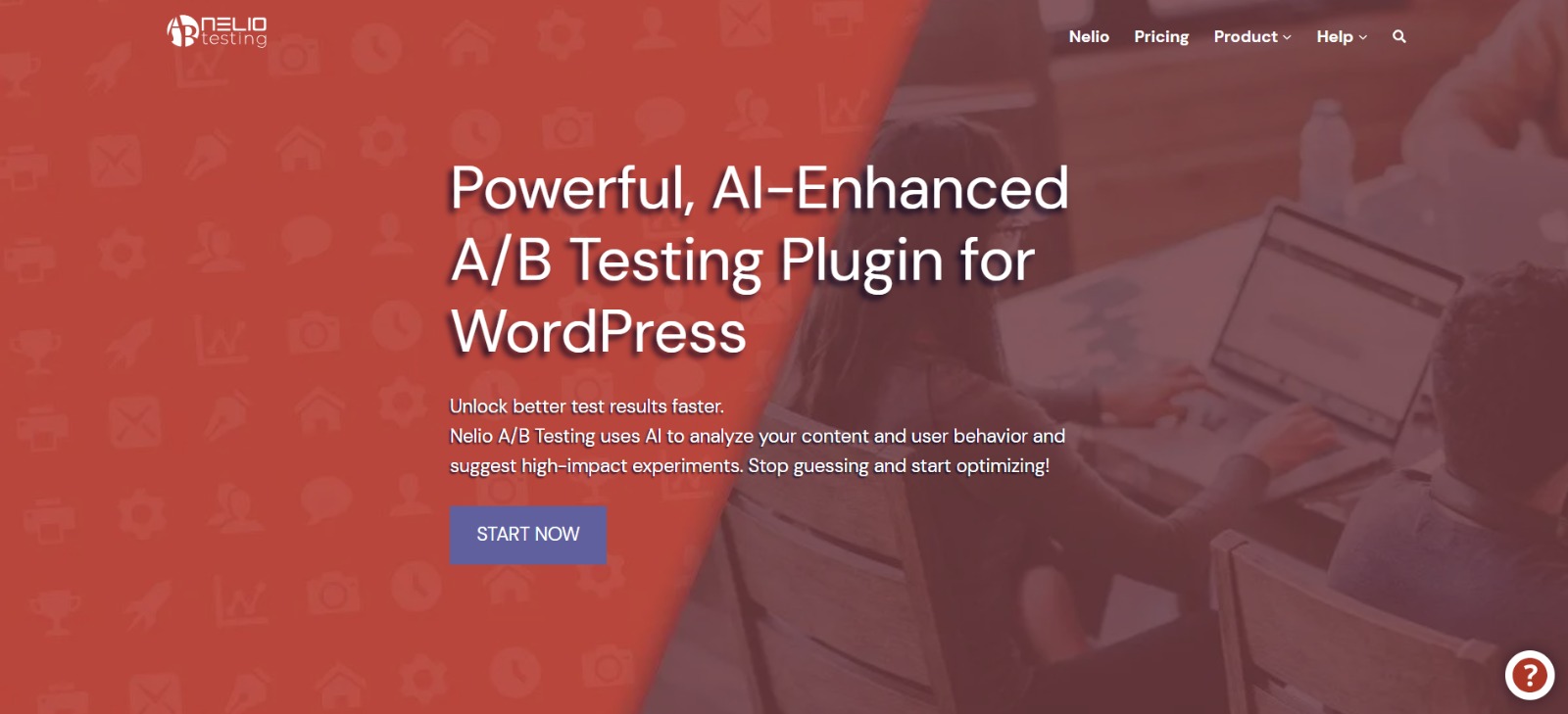
Nelio A/B Testing is one of the most feature-rich testing plugins available for WordPress. It enables A/B testing for pages, posts, widgets, menus, and even themes, making it a complete optimization toolkit for content-heavy websites.
What makes it especially useful is its native integration. Everything is managed inside the WordPress dashboard, and results are visualized in clear reports that help users understand which design or content choices drive better results.
For D2C and ecommerce sites running on WooCommerce, Nelio also supports testing of product pages and CTAs, offering a direct path to increase conversion rates through better content decisions.
Best for: WordPress-based ecommerce or blog-driven brands seeking native testing inside their CMS.
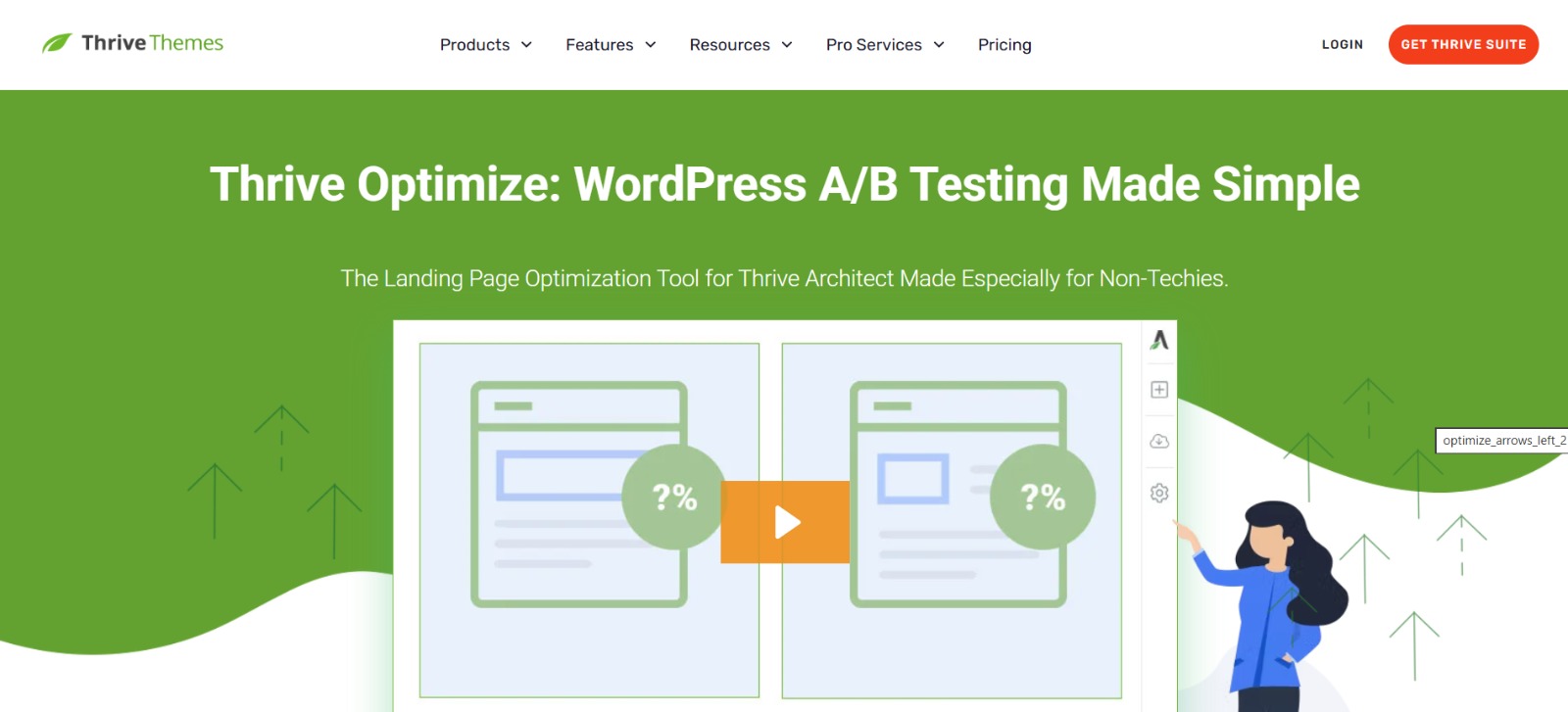
Thrive Optimize extends the popular Thrive Architect page builder with built-in A/B testing. It allows marketers to duplicate landing pages, tweak design or messaging, and instantly track which variation leads to higher conversions.
Its interface is made for marketers, not developers, drag, drop, test, and measure. This makes it ideal for solopreneurs, small agencies, and D2C businesses focused on campaign-specific optimization.
For ecommerce stores, testing hero images, button colors, or headlines in Thrive Optimize often leads to measurable uplift in add-to-cart rates or form completions.
Best for: WordPress users running campaigns or landing pages who want easy visual testing inside Thrive Architect.
Elementor Experiments brings lightweight testing capabilities directly into one of the world’s most-used page builders. It allows users to activate or deactivate experimental features and test performance or compatibility in real time.
While it’s more technical than commercial A/B Testing tools, Elementor’s approach helps web designers and marketers preview new layouts, animations, and UX features without affecting live traffic.
For creative D2C websites, it’s a sandbox for visual innovation, testing experiences safely before scaling them to production.
Best for: Elementor users testing design or UX features before full rollout.
Bookmark a few tools from this list. Run one meaningful test this week. Review results with your team and line up the next two. Consistency beats complexity. And if you need a way to move without engineering bottlenecks, CustomFit.ai can help you experiment and personalize quickly while keeping the analytics honest.
.webp)

Intellimize is an AI-powered A/B Testing Platform that takes the concept of experimentation to the next level. Instead of manually creating test variants and waiting weeks for results, Intellimize uses machine learning to personalize web experiences dynamically.
It continuously learns from visitor behavior and adjusts content in real time which means faster insights and more efficient optimization. For example, it can show different hero images, product titles, or discount banners to different user segments, automatically optimizing for conversion.
For large D2C ecommerce stores, this means you can run hundreds of micro-tests simultaneously, improving performance faster than traditional A/B testing allows.
Best for: Ecommerce and SaaS brands that want an AI-driven approach to A/B testing and personalization.

Conversion Sciences is more than a tool, it’s a methodology. Originally a consultancy, it offers a suite of CRO utilities including A/B testing, heuristic analysis, and behavioral insight frameworks.
It’s often used by agencies and ecommerce teams that want structured experimentation guidance paired with hands-on optimization tools.
Best for: Businesses looking for expert-led CRO frameworks alongside self-service testing.
Crozdesk’s A/B Testing Directory serves as a comprehensive listing of available A/B Testing Platforms across industries. It’s less a testing tool and more a discovery engine for comparing products, pricing models, and user reviews.
For agencies or marketers beginning their experimentation journey, it’s an easy way to shortlist tools that match their business scale and technical comfort.
Best for: Teams researching and comparing A/B testing and personalization platforms.
TheCXLead publishes one of the most referenced directories of A/B Testing Platforms, combining expert curation with practical use-case summaries.
It’s particularly useful for understanding which tools align best with specific industries, ecommerce, SaaS, mobile, or enterprise.
Best for: Professionals seeking vetted recommendations before adopting an A/B Testing Platform.
UserZoom, formerly known as UsabilityHub, blends user testing, surveys, and UX research with experimental design. Instead of pure A/B testing, it lets you run comparative studies, testing multiple visual or UX concepts before full-scale implementation.
For D2C brands focused on brand perception and user satisfaction, UserZoom helps validate new ideas through direct audience feedback, saving costly post-launch iterations.
Best for: UX and design teams wanting research-backed insight before launching A/B tests.
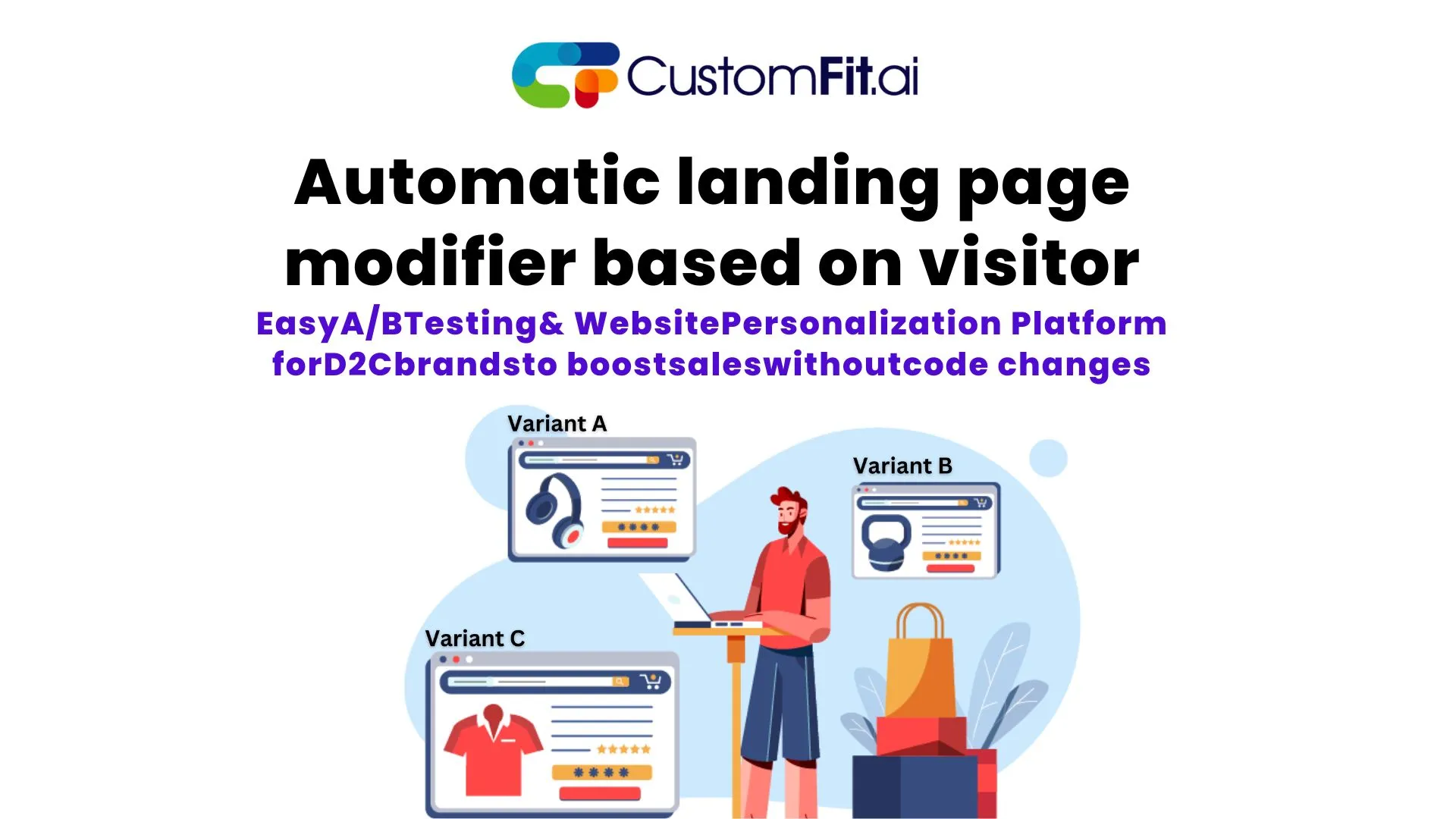
Qubit Aura focuses on mobile app personalization and A/B testing for retailers. It helps brands test recommendation widgets, product placements, and content flows specifically in mobile environments.
It’s a strong choice for D2C and retail brands investing in mobile commerce.
Best for: Retailers and D2C brands optimizing mobile shopping experiences.
Taplytics Cloud is the cloud-based variant of Taplytics, offering web and mobile A/B Testing at scale. It provides all the same capabilities, feature flags, message experiments, and personalization, but with faster setup and scalability for SaaS and ecommerce environments.
Best for: Multi-channel teams running web and mobile tests in a centralized SaaS platform.
FullStory Replay goes beyond analytics. It captures every user interaction and converts it into replays that show the why behind A/B test outcomes.
When used alongside any A/B Testing Platform, FullStory helps visualize friction points, analyze rage clicks, and identify what made a variation succeed or fail.
Best for: Product and growth teams that need visual storytelling for post-test analysis.
Heap Experiments builds on Heap’s powerful automatic event tracking. It lets teams move from analytics to experimentation seamlessly, identifying patterns and immediately launching A/B tests to validate hypotheses.
For ecommerce and SaaS businesses, this reduces the time between insight and action, a crucial factor in fast-moving markets.
Best for: Data-driven teams that want integrated analytics and testing under one system.
FeaturePeek is designed for pre-deployment testing. It allows developers and QA teams to review design or feature variants before merging them into production.
While not an A/B Testing Platform in the traditional sense, it’s a vital part of the experimentation lifecycle, ensuring each change is visually and functionally validated before launch.
Best for: Developer and QA teams conducting pre-deployment variant reviews.
In 2025, the moat isn’t just traffic or tooling, it’s the cadence of validated learning. Choose a platform that shortens that cycle for your context. Enterprise suites deliver breadth; focused tools deliver speed. For Shopify-led D2C brands, CustomFit.ai offers the fastest path from idea to measurable lift without code. Pick your lane, then keep shipping.
SplitMetrics Optimize is the premium module of SplitMetrics, offering deeper creative testing for app store listings. It enables marketers to optimize icons, screenshots, and promotional videos to increase installs.
Best for: Mobile app marketers focused on conversion optimization in app store environments.
Userbrain lets you run remote usability tests where real users interact with your site or prototype while recording feedback.
For ecommerce brands, these qualitative insights complement quantitative A/B testing, helping explain why certain design choices improve conversions.
Best for: UX teams and D2C brands that value direct user feedback during experimentation.
SessionCam, now merged into Glassbox, was one of the earliest session replay tools that supported A/B testing workflows. Its historical relevance lies in showing how early behavioural analytics helped shape modern optimization platforms.
Best for: Historical context; foundational tool for modern analytics-driven experimentation.
ABalytics JS is a simple, open-source JavaScript library for running client-side A/B tests without heavy infrastructure. Developers can assign variations, log conversions, and analyze results using existing analytics systems.
It’s perfect for startups or developers who want to embed experimentation directly into their website logic.
Best for: Developers who want a lightweight, DIY testing setup.
Gainsight PX combines product analytics, user engagement, and A/B testing to help SaaS and ecommerce apps optimize in-app experiences.
It allows you to test onboarding flows, tutorials, or feature placements, helping increase user adoption and retention.
Best for: SaaS and app-based ecommerce teams optimizing user engagement and activation.
LaunchKit was once a popular mobile app landing-page testing tool, allowing developers to A/B test marketing pages before store launch. Though discontinued, it paved the way for modern mobile optimization platforms.
Best for: Historical insight into mobile-first experimentation evolution.
DataDog Experiments extends observability into experimentation, enabling developers to measure how code-level changes affect system performance and business KPIs simultaneously.
It’s particularly useful for large ecommerce platforms with complex architectures, ensuring that optimizations don’t just improve UX but also backend efficiency.
Best for: Engineering teams linking A/B testing with application performance monitoring.
SmartTraffik bridges the gap between online and offline retail. It helps brands attribute A/B test performance not only to online conversions but also to in-store sales and engagement.
For omnichannel retailers, it provides a complete view of how digital changes influence real-world outcomes.
Best for: Retailers running cross-channel experiments linking digital experiences to store performance.
Monetate AI Personalization builds on Monetate’s heritage, adding machine-learning algorithms that automatically adjust variations based on performance.
For ecommerce brands, it means each user’s experience evolves dynamically, like A/B testing that runs itself and improves over time.
Best for: Retailers and enterprises seeking AI-powered personalization within A/B testing workflows.
Revolve AI uses machine learning to evolve winning experiences automatically. It runs multivariate experiments to identify high-performing design and messaging combinations without manual setup.
For ecommerce, this helps accelerate growth by reducing testing cycles and continuously learning from user data.
Best for: AI-driven brands looking to automate the experimentation process.
Flagship by AB Tasty takes experimentation to an enterprise scale. It’s a feature-flag and full-stack experimentation platform built for organizations that want centralized control over feature rollouts across multiple teams and environments.
With support for server-side and client-side testing, it enables product, data, and marketing teams to collaborate seamlessly. Its targeting options and rollout rules allow for granular audience segmentation, ensuring only specific users experience certain features or tests.
For large ecommerce or technology enterprises, Flagship brings the governance and structure needed to experiment confidently across large user bases.
Best for: Enterprises that need full-stack A/B testing with precise rollout control and scalability.
The A/B testing landscape has evolved far beyond split pages and color experiments. Today’s platforms combine behavioral analytics, AI-driven personalization, and seamless integrations that empower marketers to act fast, often without relying on developers. While enterprise solutions like Optimizely and Adobe Target dominate large-scale ecosystems, newer tools such as CustomFit.ai are redefining what’s possible for D2C and ecommerce brands by putting no-code experimentation directly in marketers’ hands. At the end of the day, the best platform isn’t just the most powerful one; it’s the one that lets you test, learn, and adapt at the speed your customers expect.